This flight took place in mid-June. That’s a perfect time for flying towards the Med.
The plan was to spend a week in various places in my “other home country” – Italy – mostly in Sardinia.
However, in the days preceeding the trip, the weather forecast (especially for Central Italy) was not too good. Not really too bad in Sardinia, but just not good enough for a summer holiday in a place like Sardinia. Fortunately, I hadn’t made any reservations (I almost never do any when going to Italy – I sort out everything “on the spot” with just the telephone and ipad; even hotels are usually no problem in June).
We kept on weighing up things right until the night before our planned departure – and finally changed plans. We turned our view towards Spain and France, where the weather was forecast to be much better. So, there I was, 11 pm on Friday the 13th ( ) of June, trying to work out flightplans, fuel, etc. as well as a “general plan” for the first few days. The final decision was to fly from Lübeck (EDHL) to southern France (which would leave us with a lot of options), get some fuel and lunch and then take further decisions. One idea was to spend a couple of days at Menorca – the small sister of Mallorca. I have previously been to Mallorca and Ibiza, so that would round things off nicely. Other options were Ampuriabrava (Costa Brava) or the Atlantic coasts of Spain and France.
) of June, trying to work out flightplans, fuel, etc. as well as a “general plan” for the first few days. The final decision was to fly from Lübeck (EDHL) to southern France (which would leave us with a lot of options), get some fuel and lunch and then take further decisions. One idea was to spend a couple of days at Menorca – the small sister of Mallorca. I have previously been to Mallorca and Ibiza, so that would round things off nicely. Other options were Ampuriabrava (Costa Brava) or the Atlantic coasts of Spain and France.
As our first stop, we settled on Mende-Brenoux (LFNB); I have previously used this place on the way southwest. It’s just under 4 hours in the SR22. IFR routing options are two: either roughly via Nancy and Dijon (with a slight dogleg to the left) or via Frankfurt, Basel, Geneva and Lyon (with a slight dogleg to the right). Nothing in between. So, since it was more scenic, we opted for the second one:
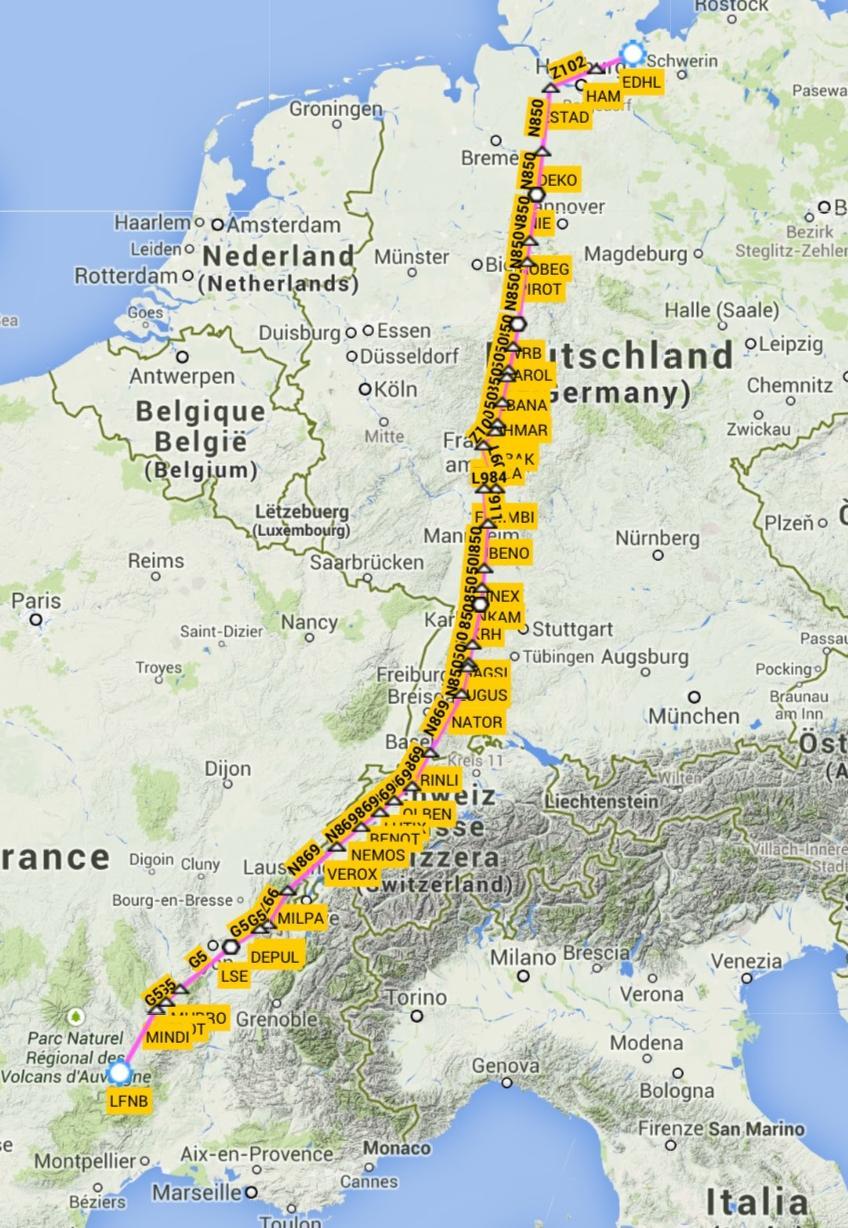
The weather was forecast to be very good, so no interesting sat images to show you. Departure was early in the morning (which I always do in summer). However, there was a lot of cloud, but it was only a shallow broken layer topping out at about FL100, so we chose FL120 to stay comfortably on top.
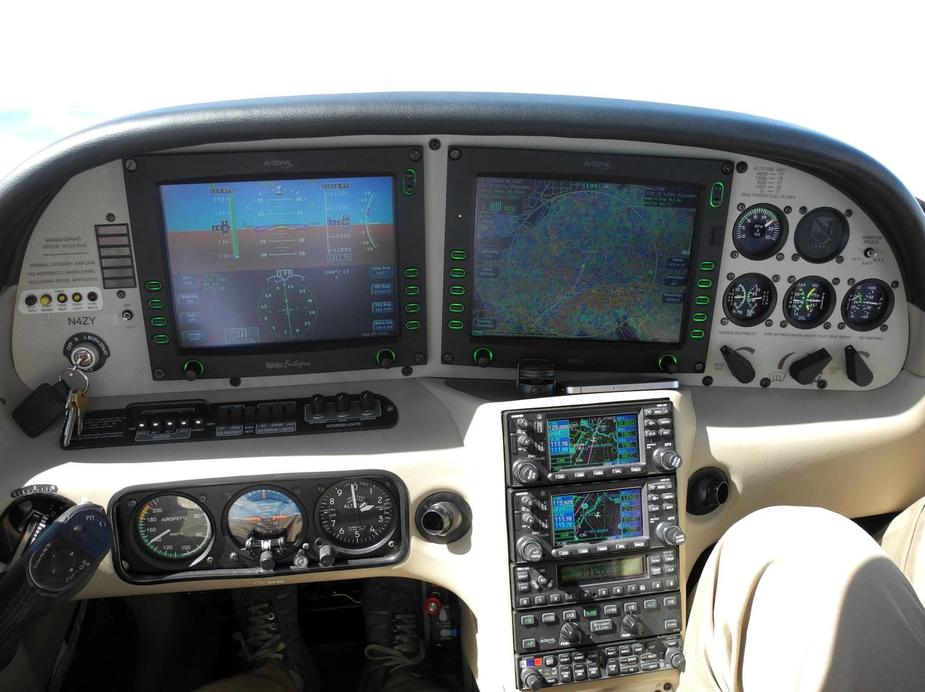
Fortunately, we had a slight tailwind (coming from the northwest) which gave us 180 knots of groundspeed and cut down our calculated ETE to just over three and a half hours, which was very welcome.
As always, that planned routing would take us right over Frankfurt from north to south, with its minimum of FL140. Eventually, Langen asked us “are you able to climb to FL140 later on for crossing Frankfurt?” I took this as an inviatation and said “well, we can do FL140 no problem, but if it were possible to just stay at FL120, that would be great” (we did have 02 on board). Needless to say, that did the trick. It usually pays off to talk to controllers in reasonable manners. Obviously, it also requires a cooperative controller.
Here’s but a minimal glimpse of the cities of Offenbach and Frankfurt.
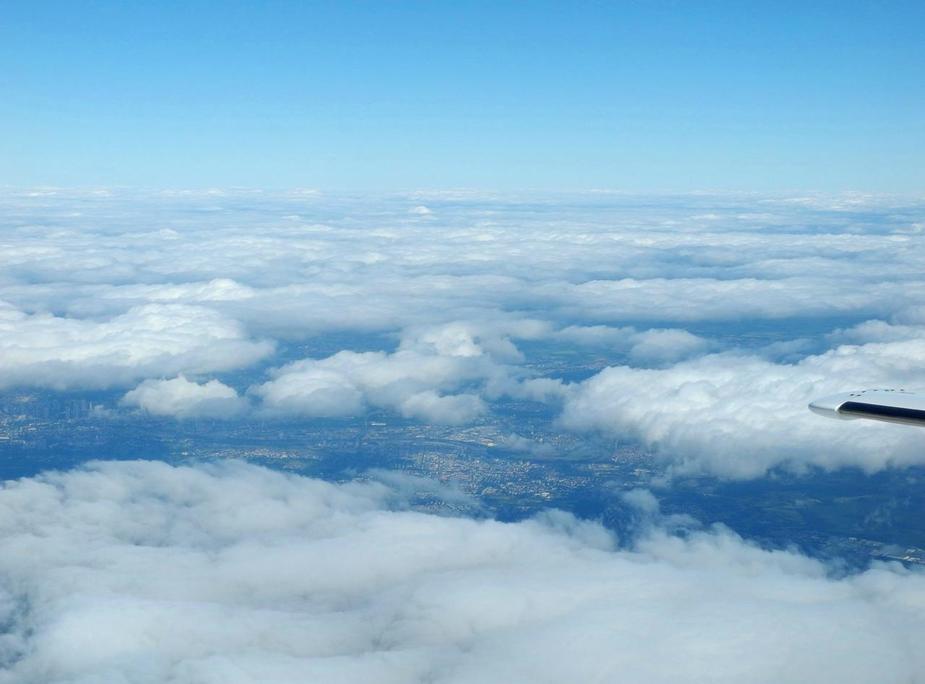
Here’s our further routing.
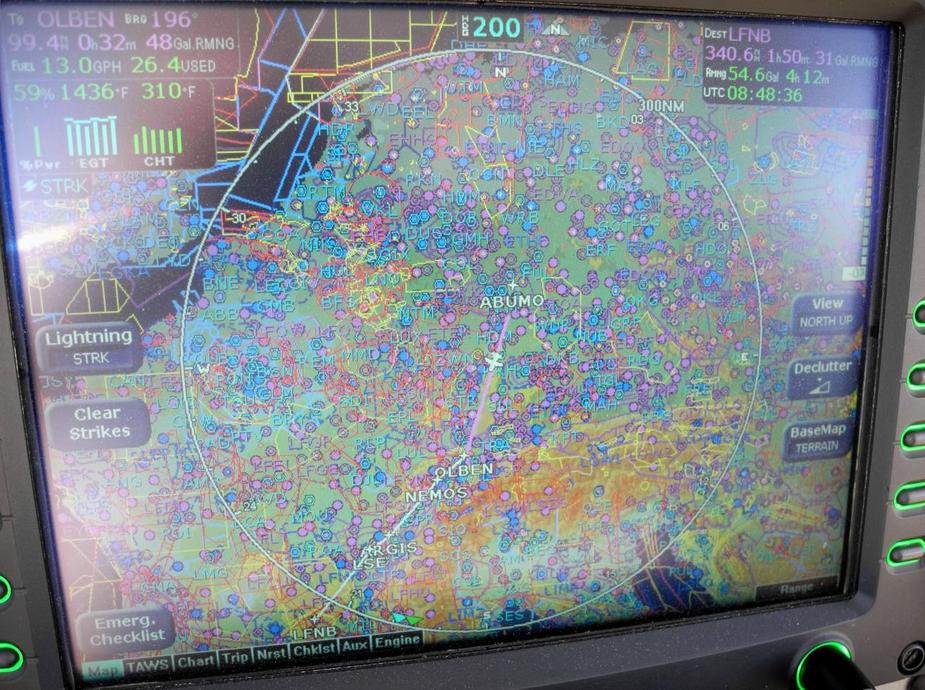
Once past ABUMO, we tried to obtain something a shortcut towards our destination, but no way. So via OLBEN it was.
Here’s Basel airport (LFSB).
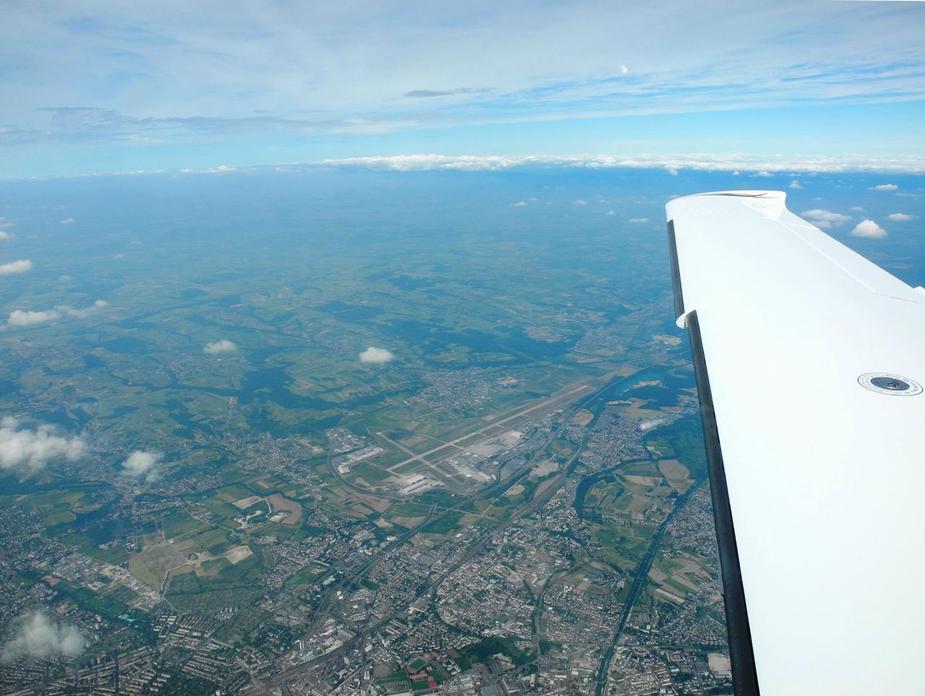
Cruising alongside Lake Neuchâtel.
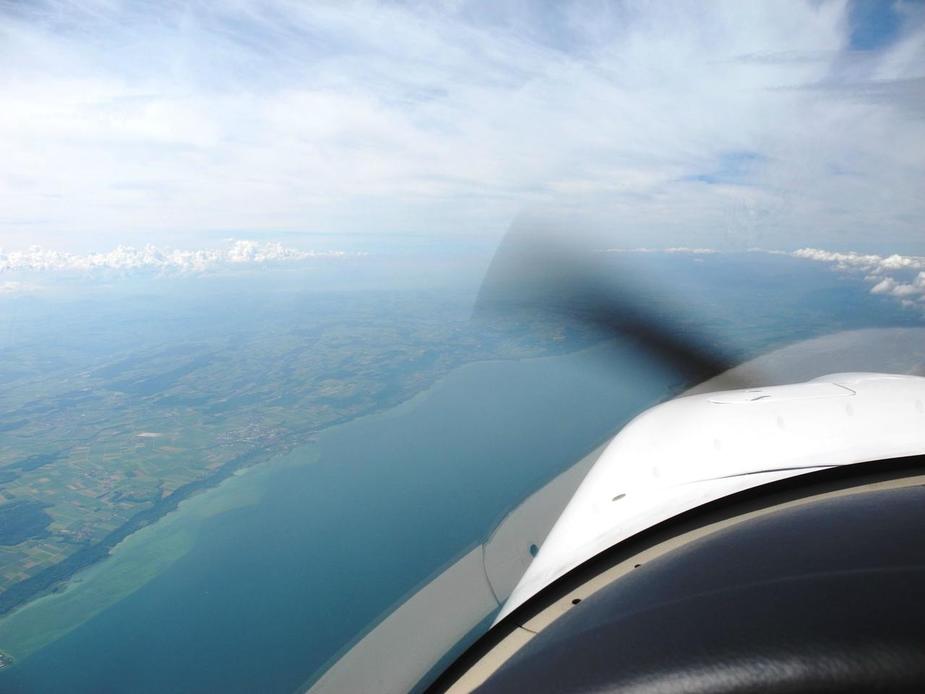
The Jura Mountains to the right.
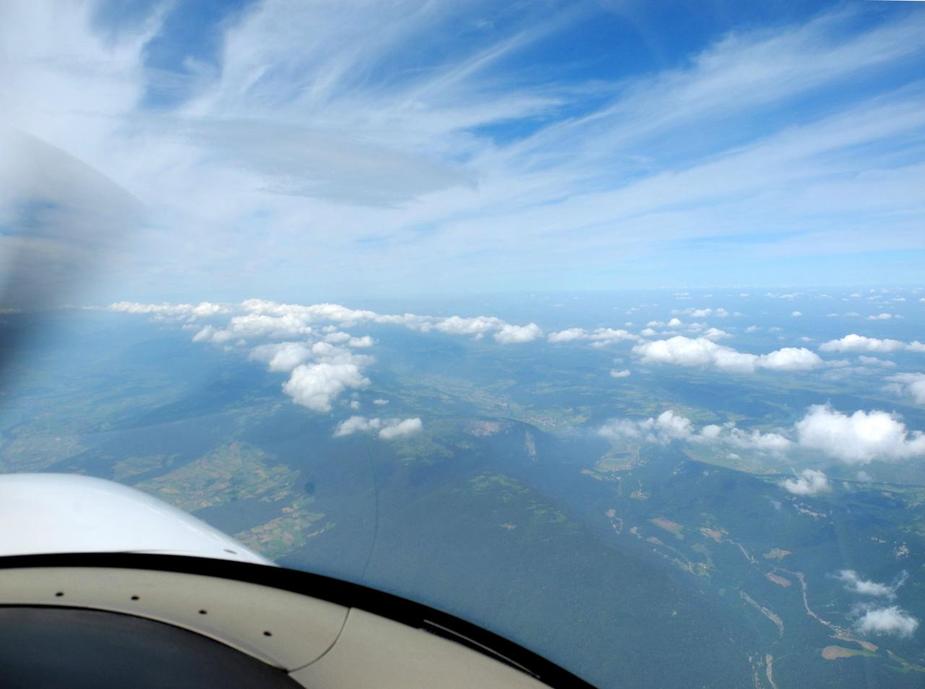
Geneva. 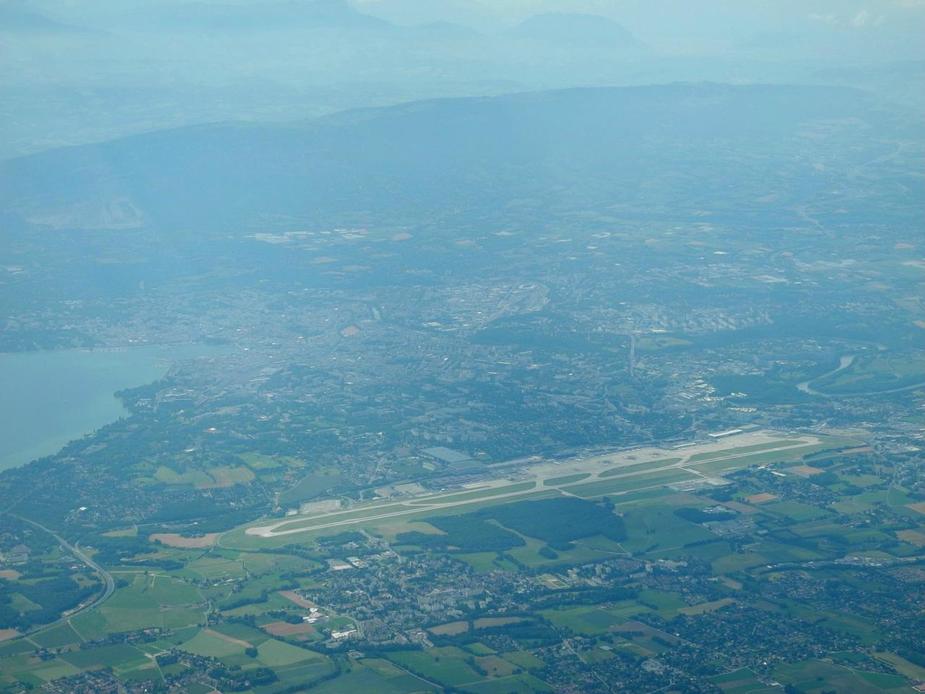
A little later on, passing overhead Lyon Saint-Exupéry (LFLL).
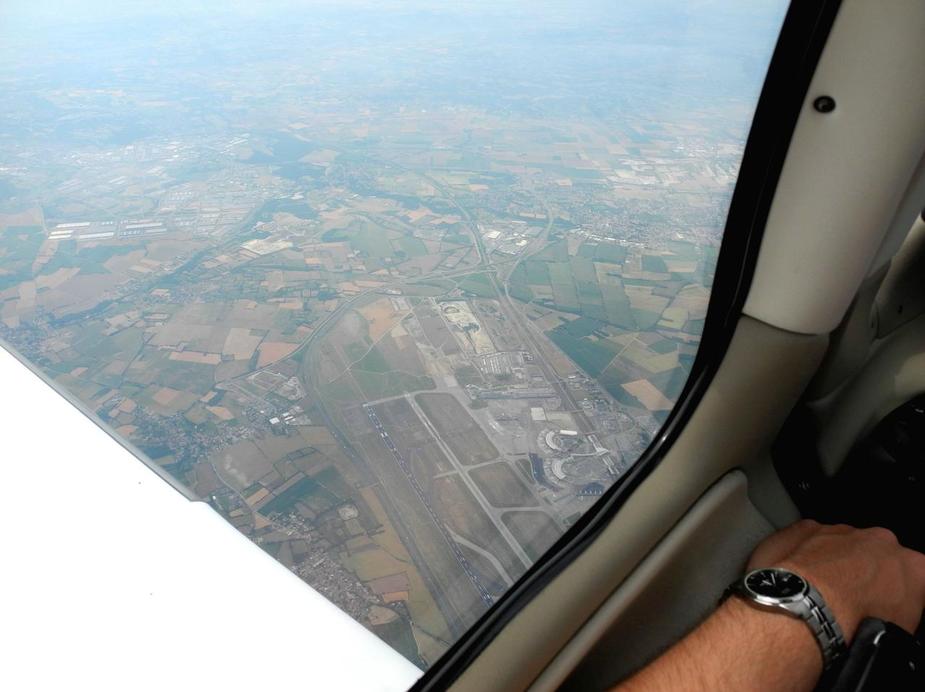
Down there is Lyon’s main GA airport, Bron (LFLY).
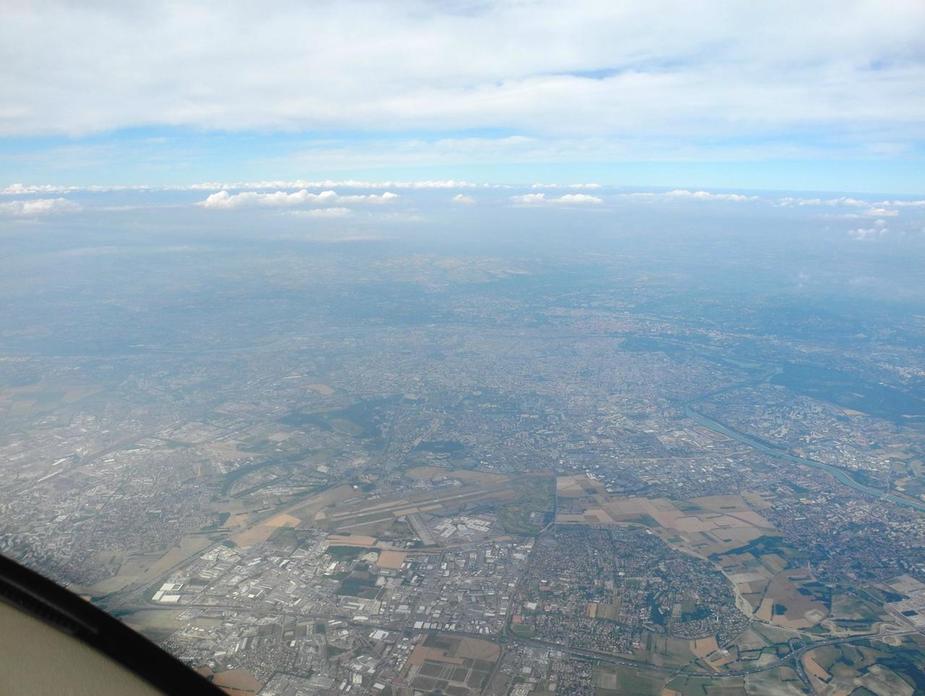
Lyon truly is a vast city.
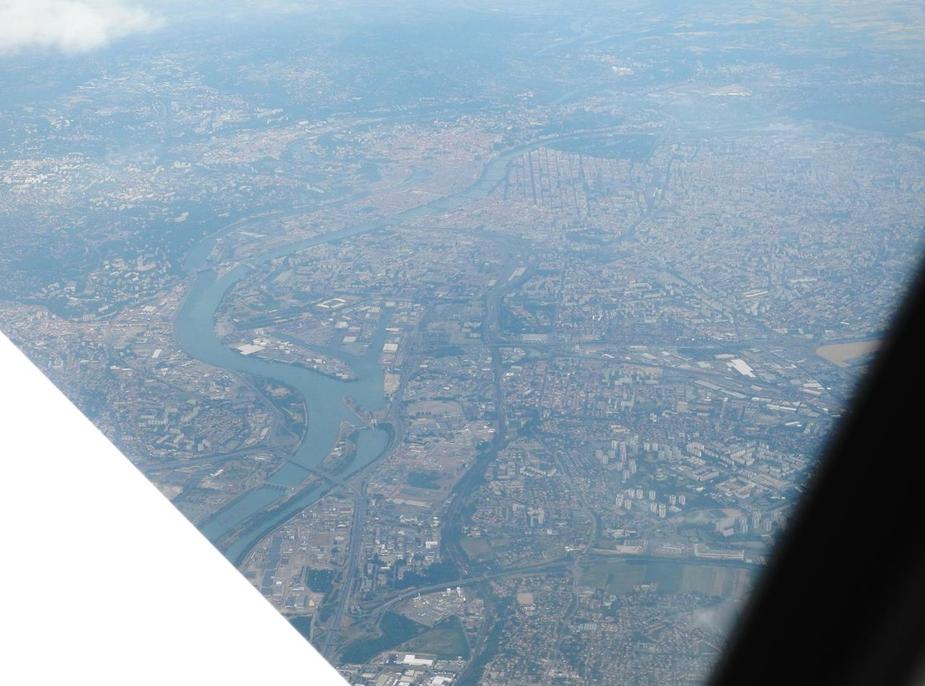
The weather at our destination was perfect, so in order to save time, we opted for a VFR approach at Mende. This is the nice town of Mende, right in the Massif Central.
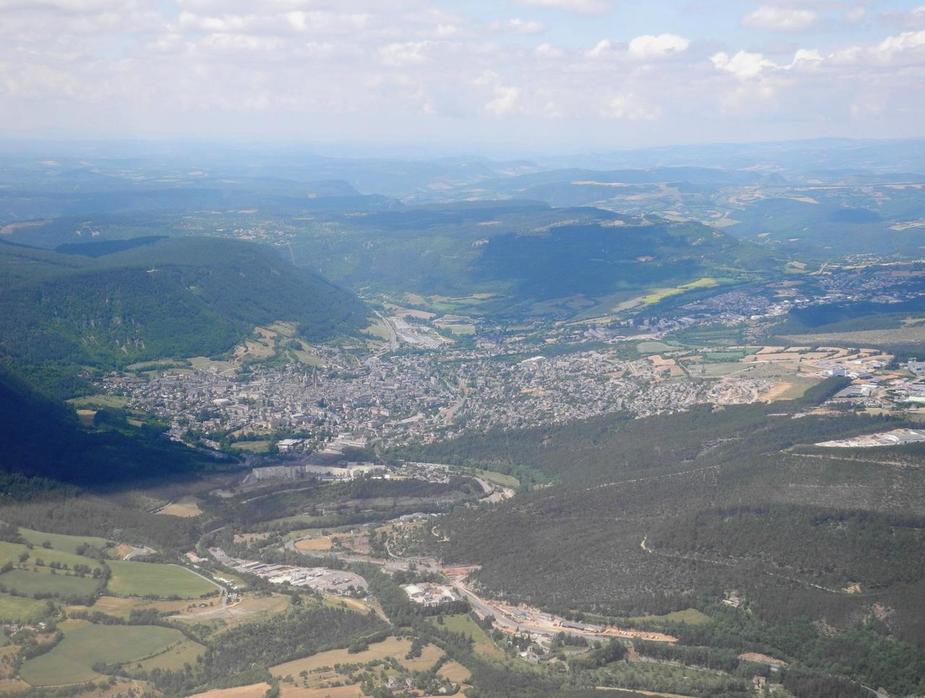
Approaching the overhead (mandatory joining procedure for airfields without an active AFIS or Tower).
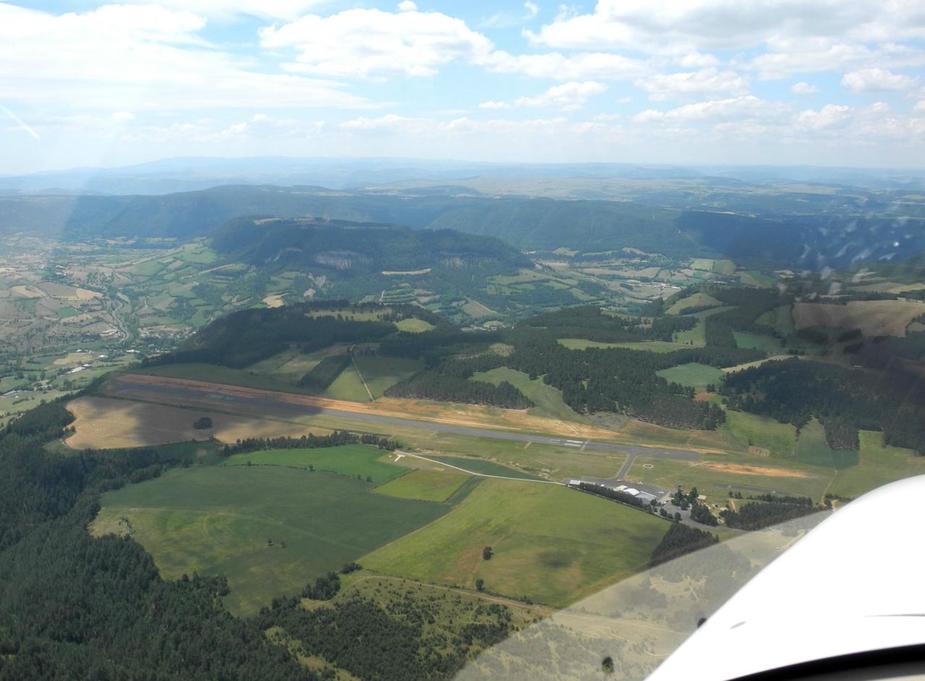
Lovely landscapes.
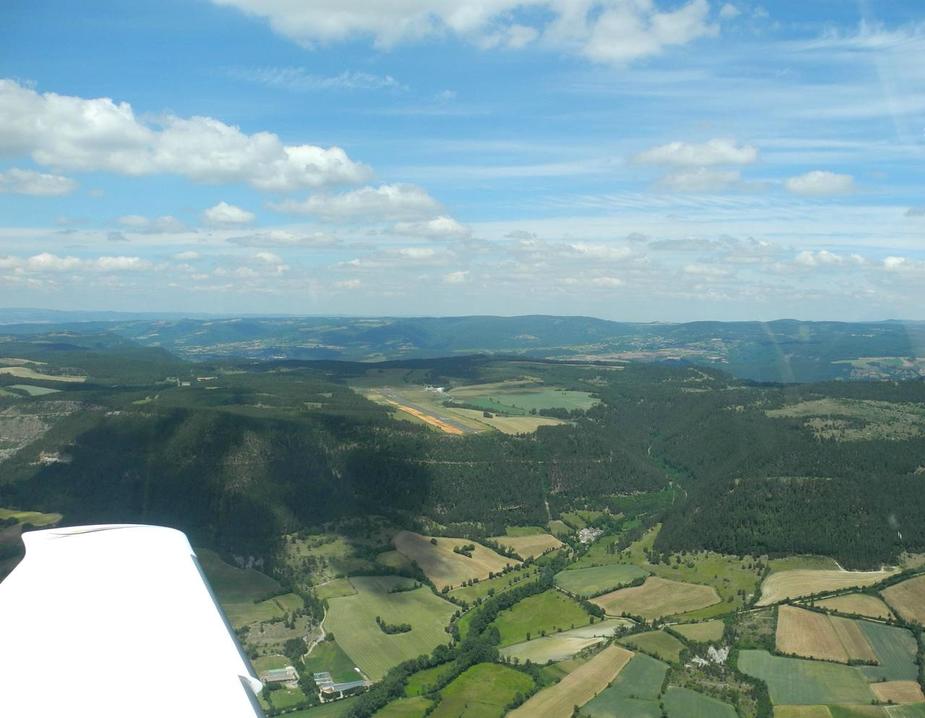
Just about to turn final. The location of the aerodrome can make for an interesting approach. In case of strong westerly or northerly winds, one can expect strong leeside downdraughts on final for 31 and strong turbulence on departure on 31. Also, the airfield is situated at almost 3400 feet MSL, which often makes for 6000+ density altitudes in summer. It’s good to have 1300 metres of runway available.
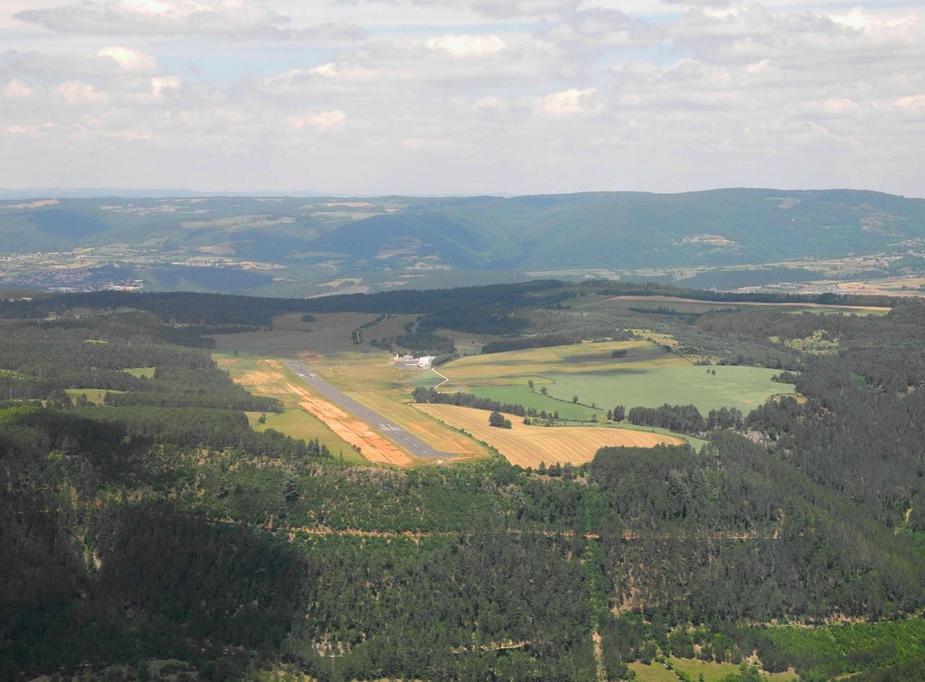
I chose Mende partly because it has an automatic TOTAL fuel dispenser and I knew we would be landing sometime aroung 12:30.
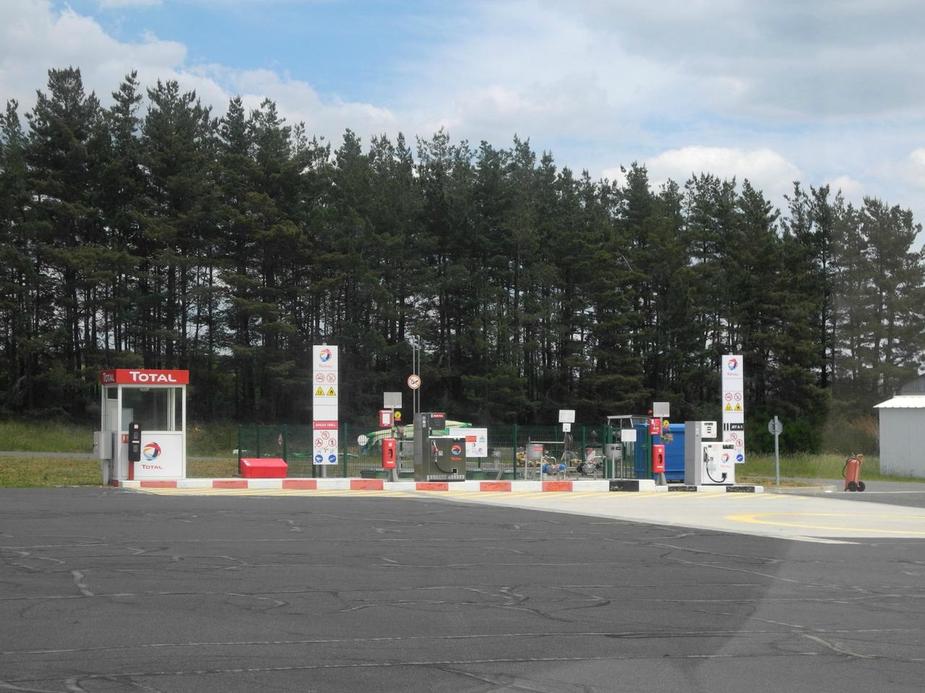
So, with the carnet, refuelling was without delay and at a good price of 2.02 Euros.
Well, and the other reason for choosing LFNB was this (the building to the right  )
)
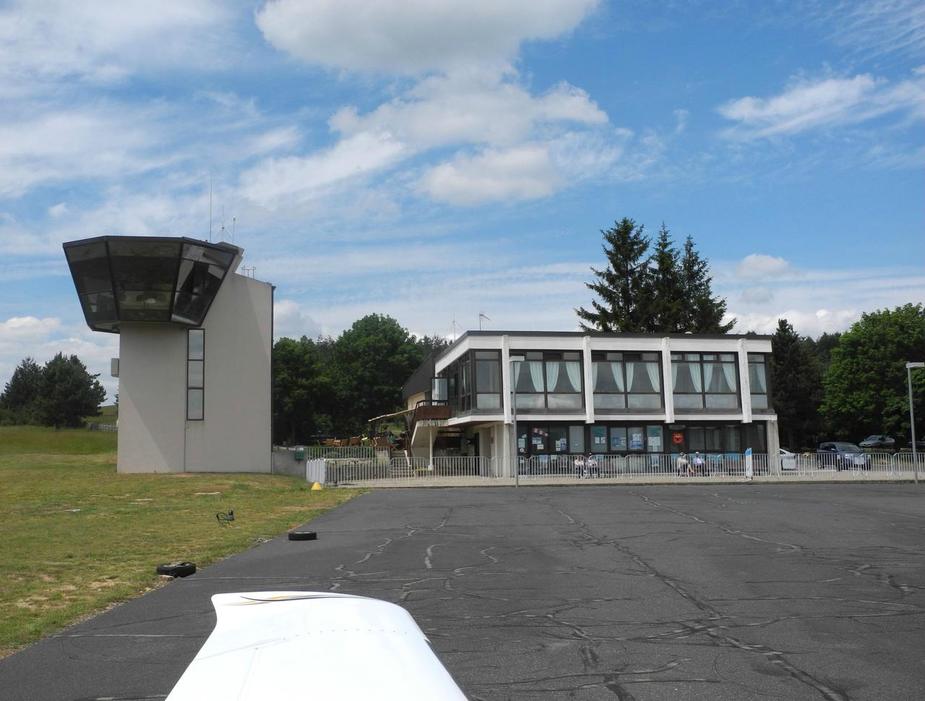
During lunch we checked the weather forecasts again (the restaurant has WiFi) and settled on Menorca as our first “real destination”. The flightplan was done within minutes using Rocketroute. The routing was via Beziers, Perpignan and Bagur. 1:45h enroute.
By the time we were ready to go, the AFIS man had arrived back from his lunch break, so I didn’t get around paying the huge sum of 5 Euros for a landing fee.
But he was very nice. He said “By the way, I do have your flightplan, Sir. I will give you the clearance once you taxi out to the runway.”
After departure, we climbed to FL100 and Montpellier Appraoch took care of us very nicely (“direct Perpignan”). Here’s Bédarieux airfield (LFNX).
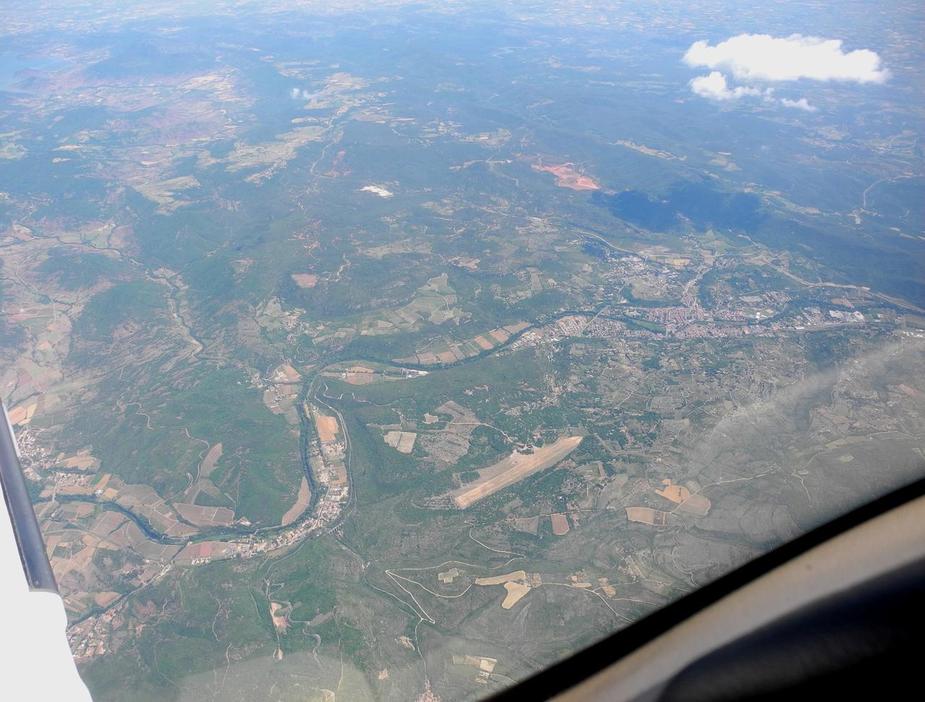
At that time, we asked for 25 degrees to the left to avoid “for about 30 minutes”(!), which, to my astonishment, was immediately approved.
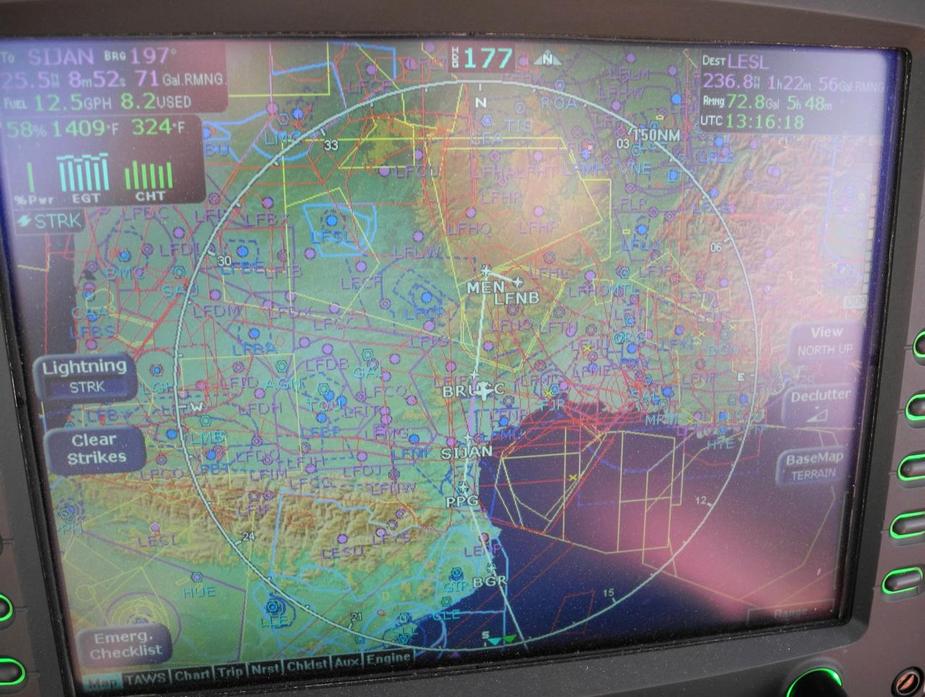
Now, you might think…“clever boy, making up a weather-related deviation in order shortcut the route…”
…but it really was there:
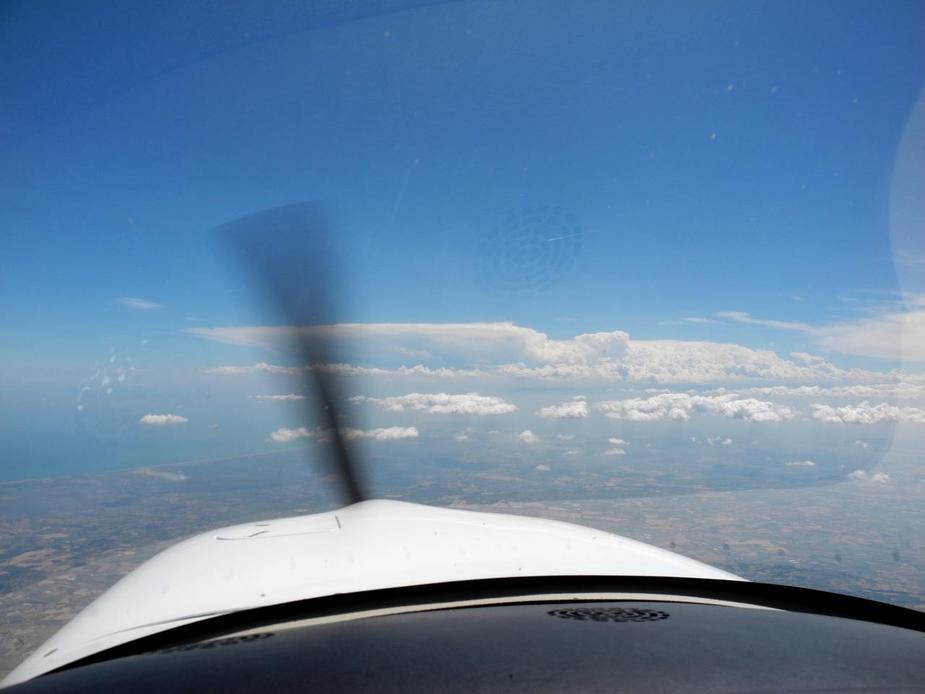
Here’s Beziers and a first glance of the Med.
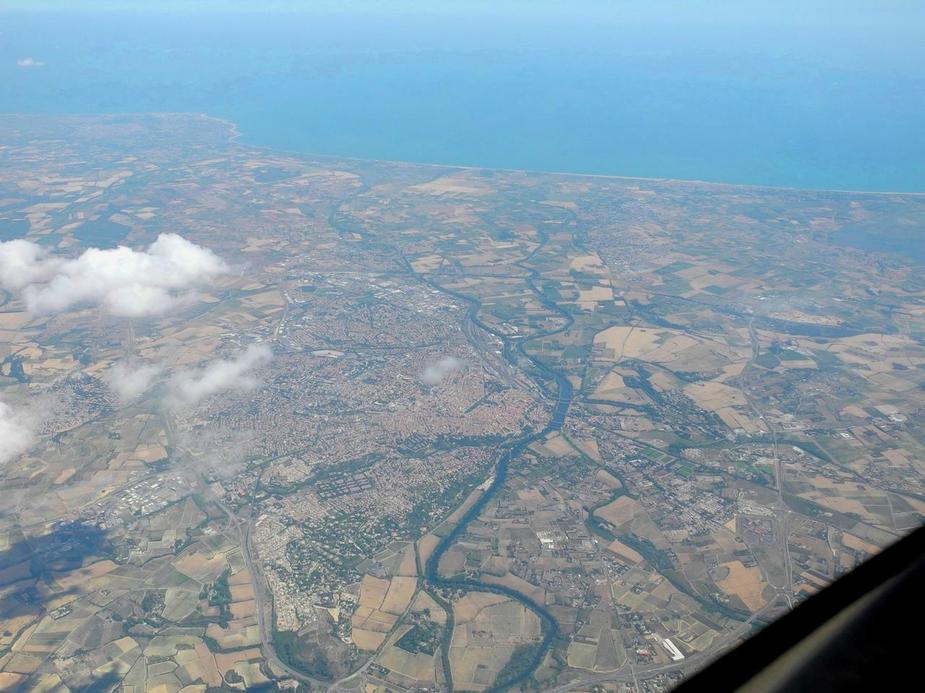
The crossing, from just to the east of Bagur (BGR) to Menorca was uneventful and took less than half an hour.
Oh, by the way, for who doesn’t know: Menorca has two airports: the main (airline) aiport (Mahon, LEMH) which obviously has IFR, has customs, rental cars, Avgas, etc. (I guess Peter would love it  ). However, it also has (expensive) handling and the typical Spanish airport fuss. The “second” airport (San Luis, LESL) once was the island’s airline airport, but now only serves GA and the Menorca aeroclub. It has no fees, no PPR, no fuss, no IFR, no customs and no rental cars (however, if necessary, one could use the ILS of LEMH and then almost “side-step” to LESL, since the two airports are very close to each other):
). However, it also has (expensive) handling and the typical Spanish airport fuss. The “second” airport (San Luis, LESL) once was the island’s airline airport, but now only serves GA and the Menorca aeroclub. It has no fees, no PPR, no fuss, no IFR, no customs and no rental cars (however, if necessary, one could use the ILS of LEMH and then almost “side-step” to LESL, since the two airports are very close to each other):
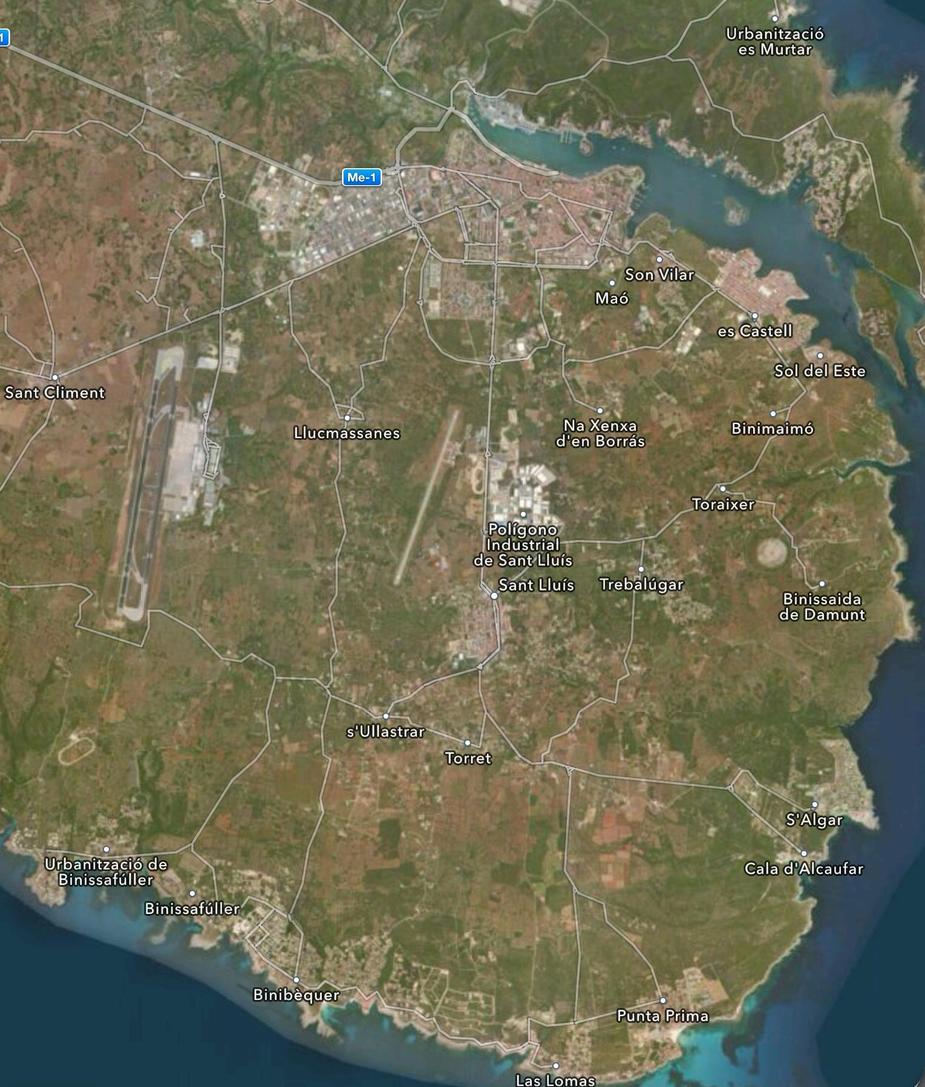
As the weather was good, we opted for the “standard” VFR arrival: after reaching the coastine at 1000 feet, proceed around the island up to La Mola point, then to San Luis.
Reaching the coastline.
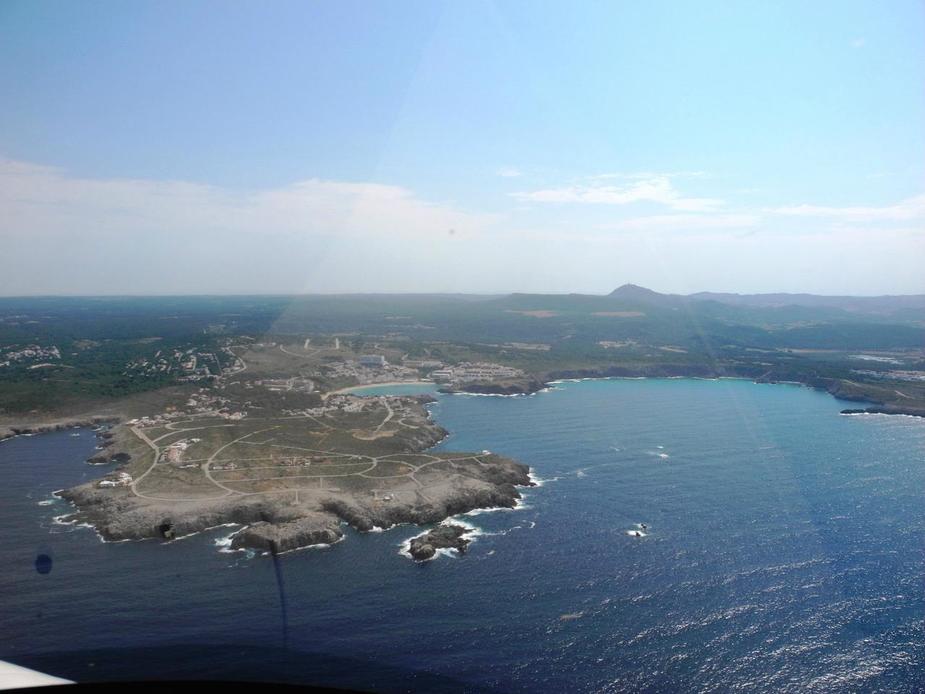
A welcome little VFR trip around the island at 1000 feet.
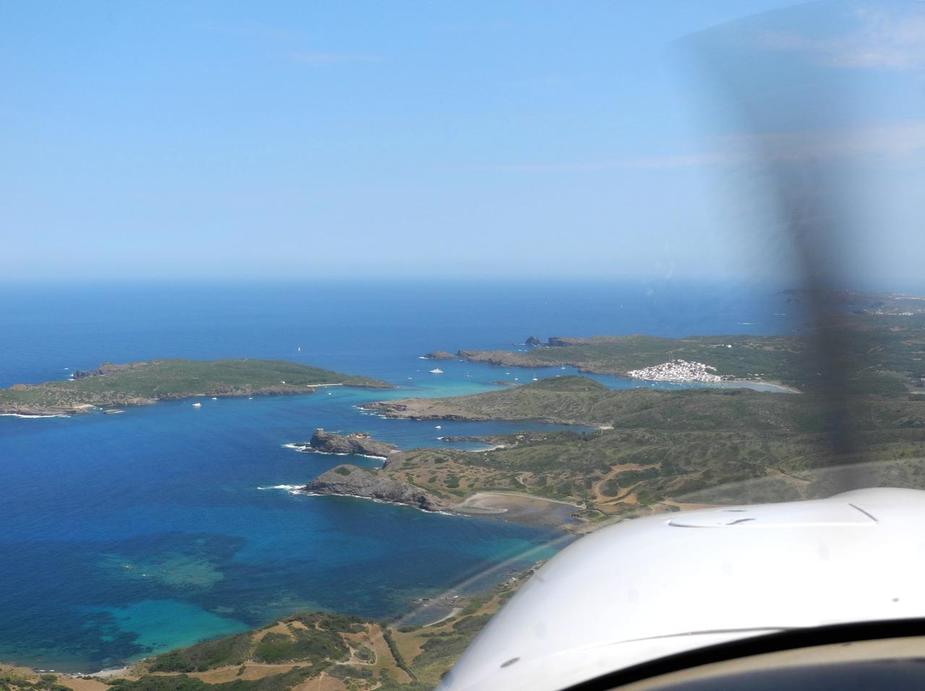
Es Grau, a beautiful little village up in the northeast of the island. Looks like the Aegean.
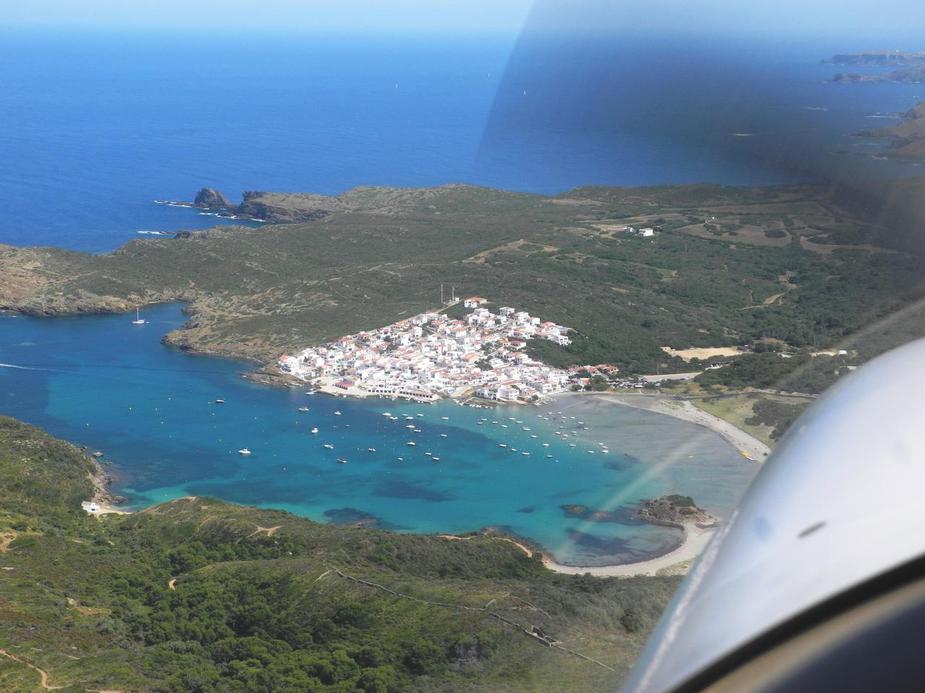
In the foreground: the island’s capital Mahon (Maó in Menorquin). In the background: San Luis airport.
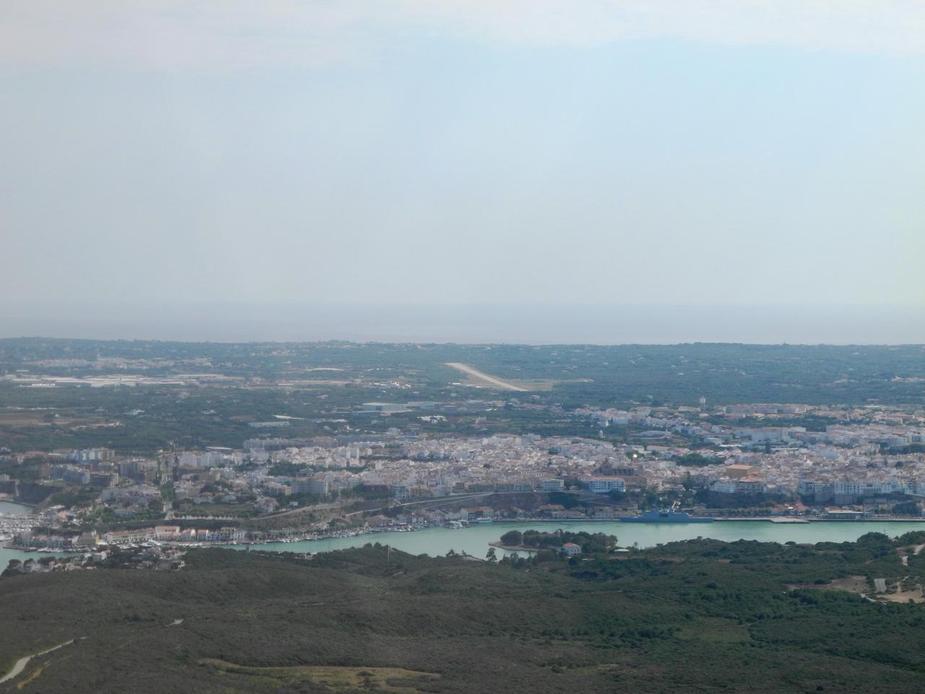
The harbour is the biggest natural harbour in the Mediterranean Sea.
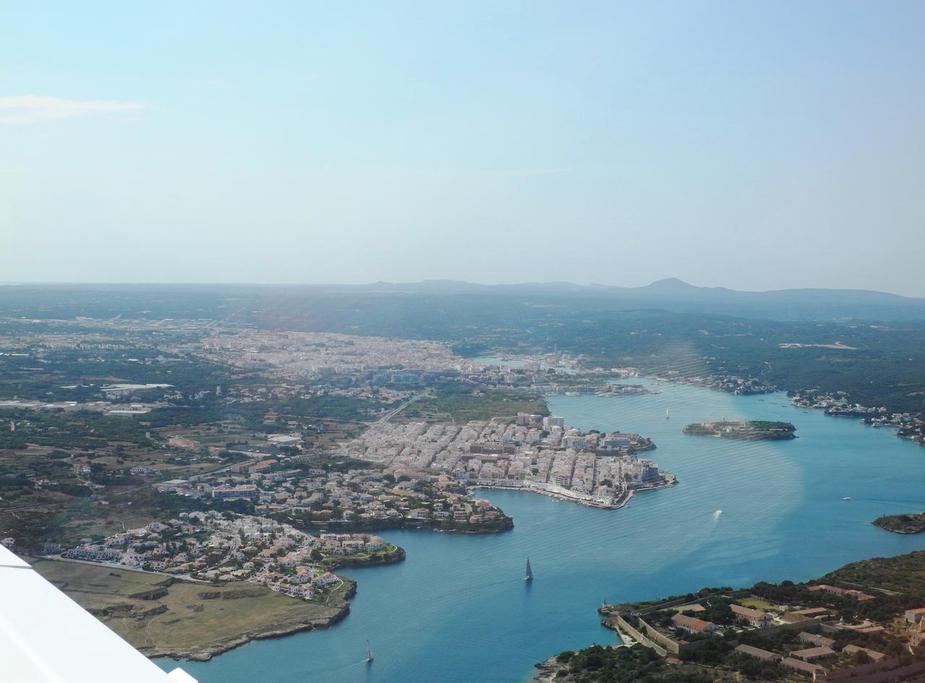
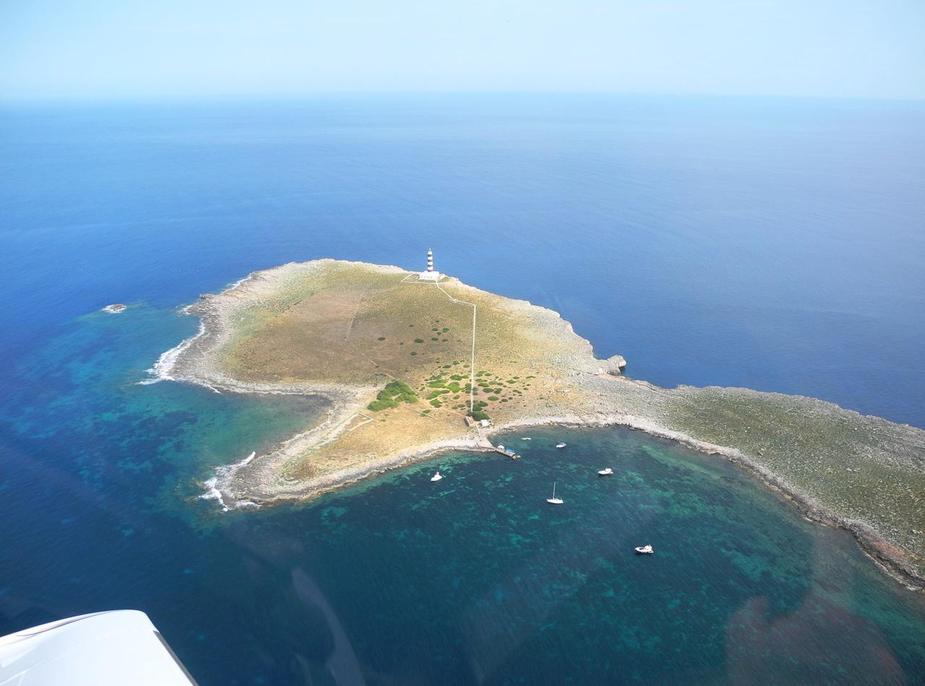
Approaching runway 02.
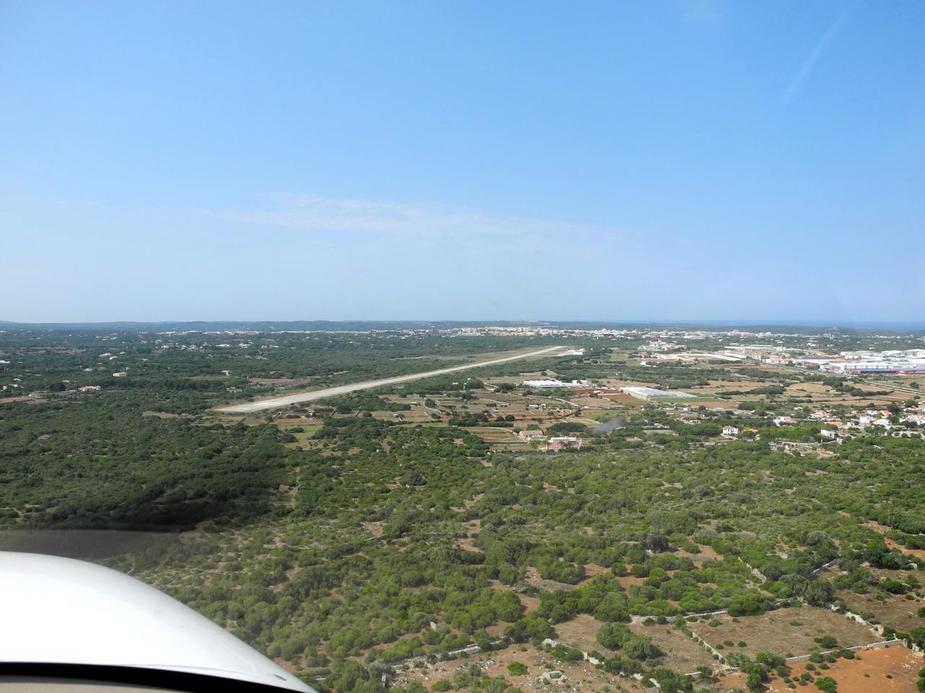
San Luis turned out to be a beautiful, sleepy airport (too sleepy, actually).
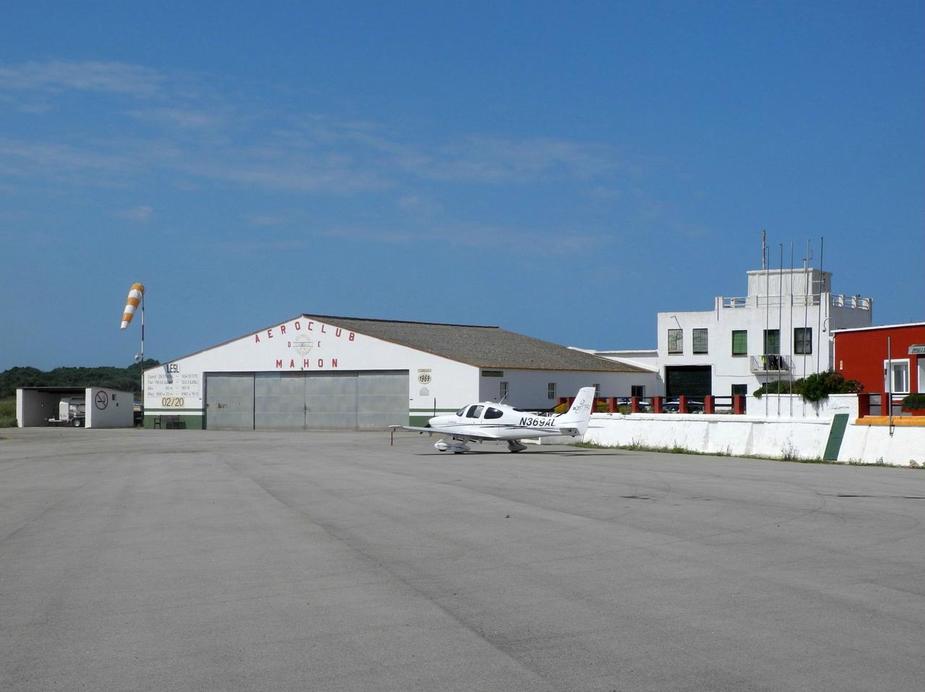
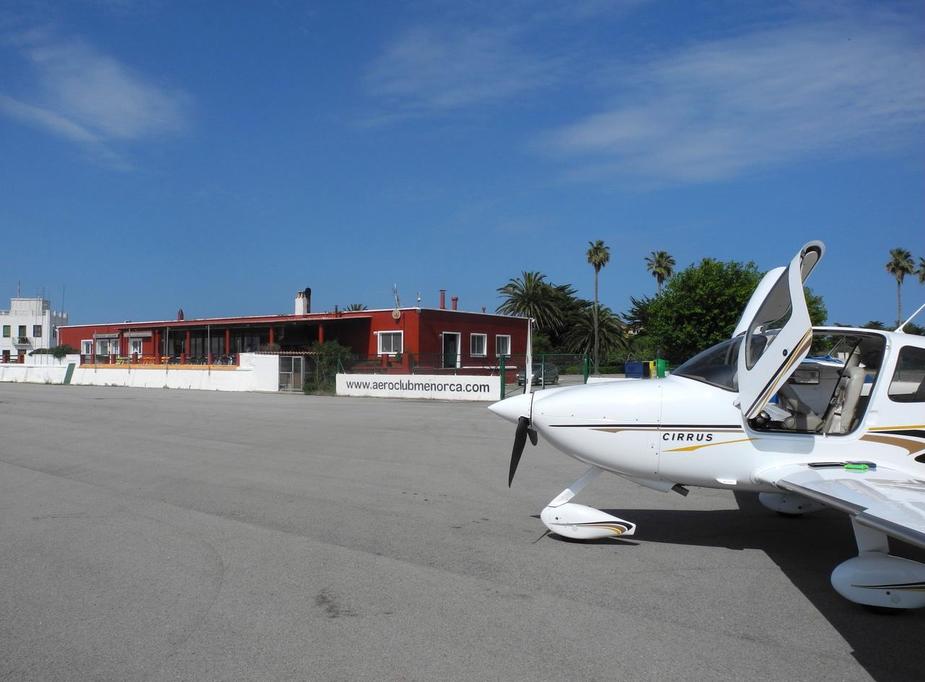
An old C150 rotting away. Symbolic image of the state of Spanish GA (a consequence of burocracy and the downward spiral of the Spanish econony).
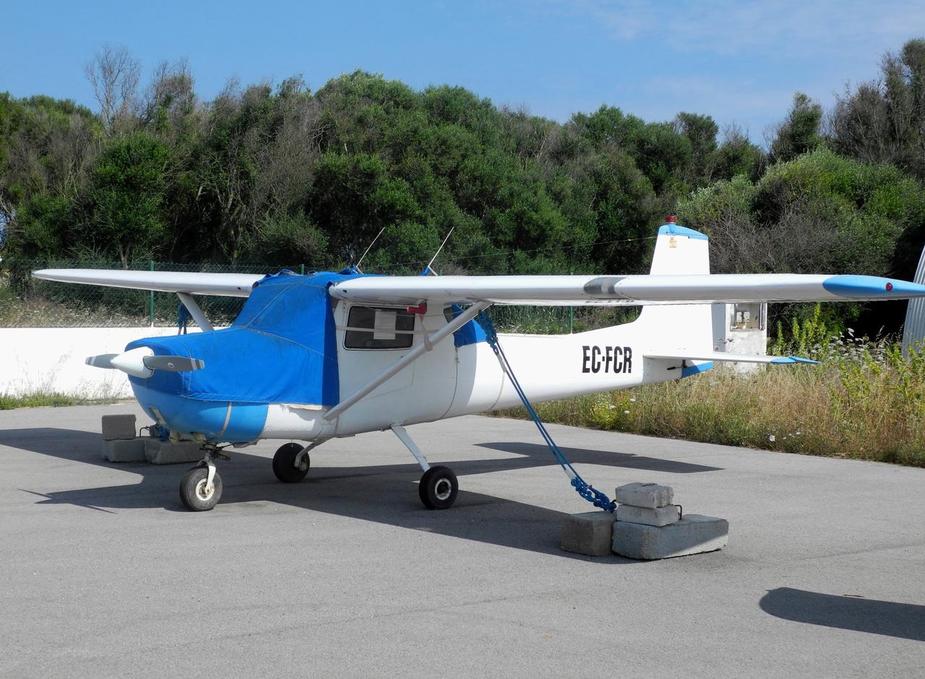
Just a couple of beach pics of Menorca.
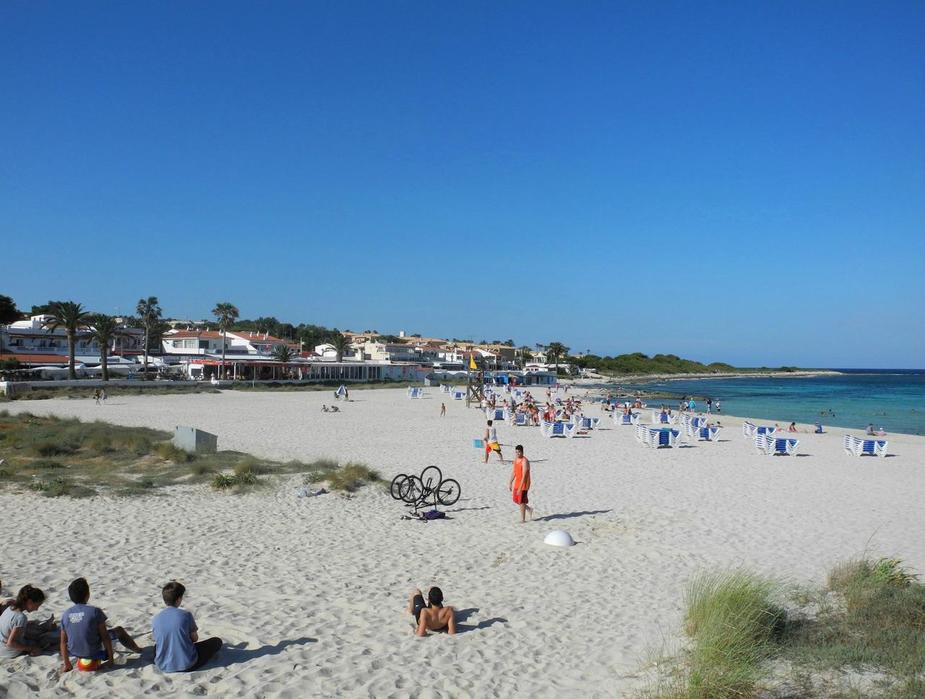
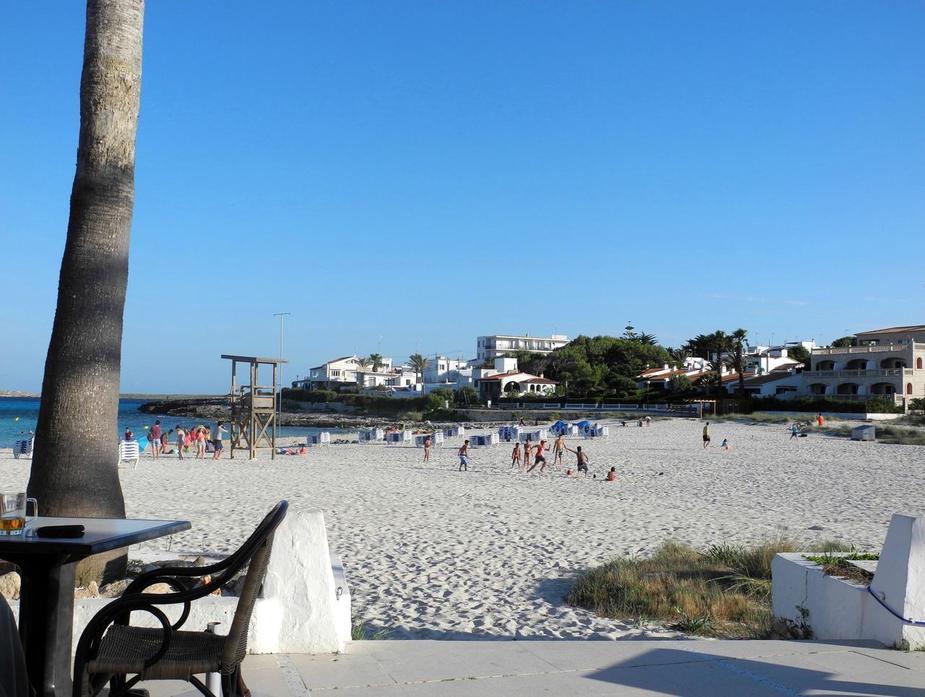
Two days later, it was time to move on. The weather was good all over France and Spain. However, we were now really looking forward to France (all in all, I do prefer France over Spain), so decided to say goodbye to Spain. Since we had never previously spent any time in the Pyrenees region, we decided to do that. France has one very nice airfield right in the central Pyrenees, Bagnères-de-Luchon (LFCB), so we decided to go there. The flightplan was filed as a Zulu flightplan (Spain doesn’t allow filing India if departing an airfield without IFR procedures).
On departure from San Luis, here’s Mahon once again. To the very left is LESL, in the background is LEMH.
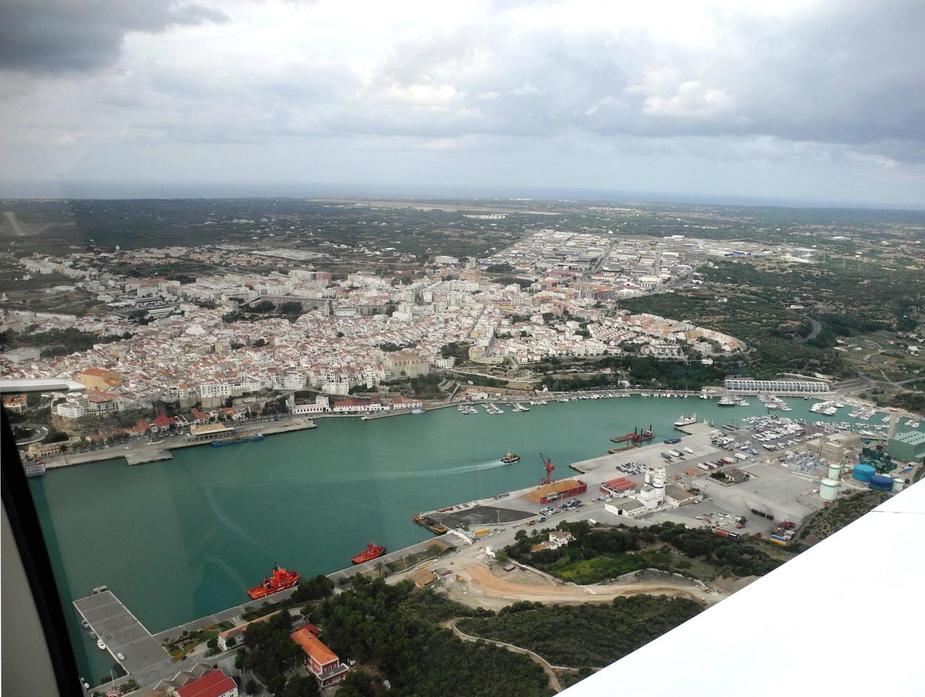
The IFR pickup actually went very smooth, a little to my surprise. We climbed to FL110. Here’s a photo of our PFD with the further route depicted.
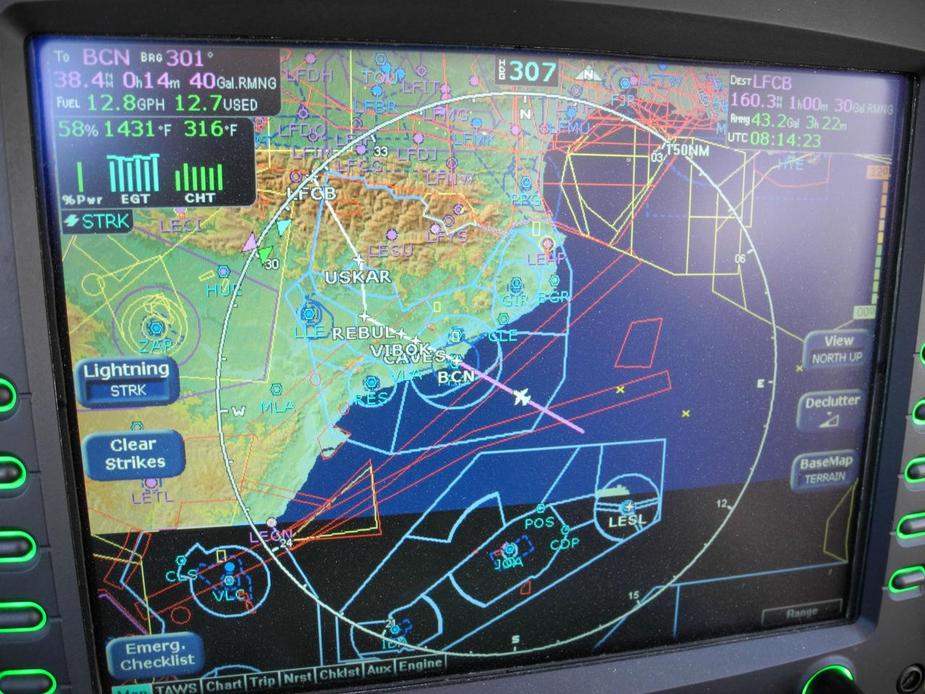
This took us right over Barcelona and allowed us to take some nice pictures of the Spanish metropolis.
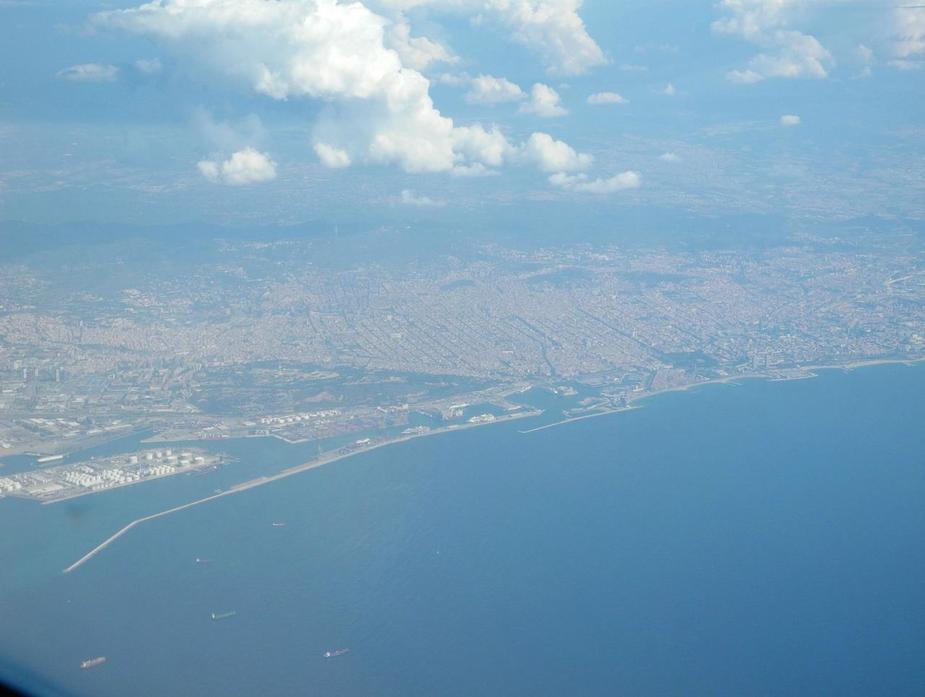
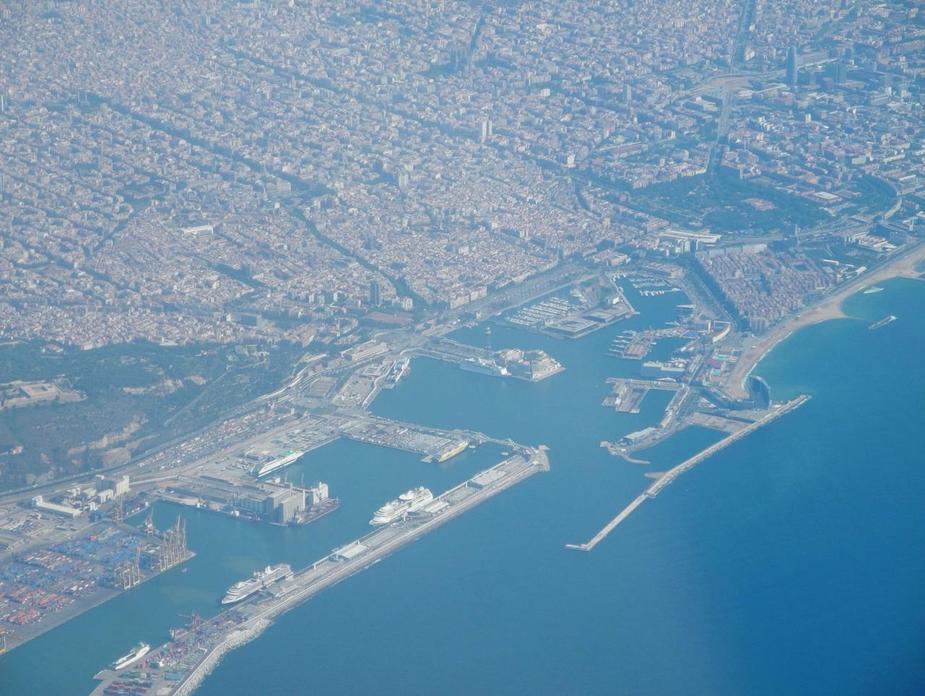
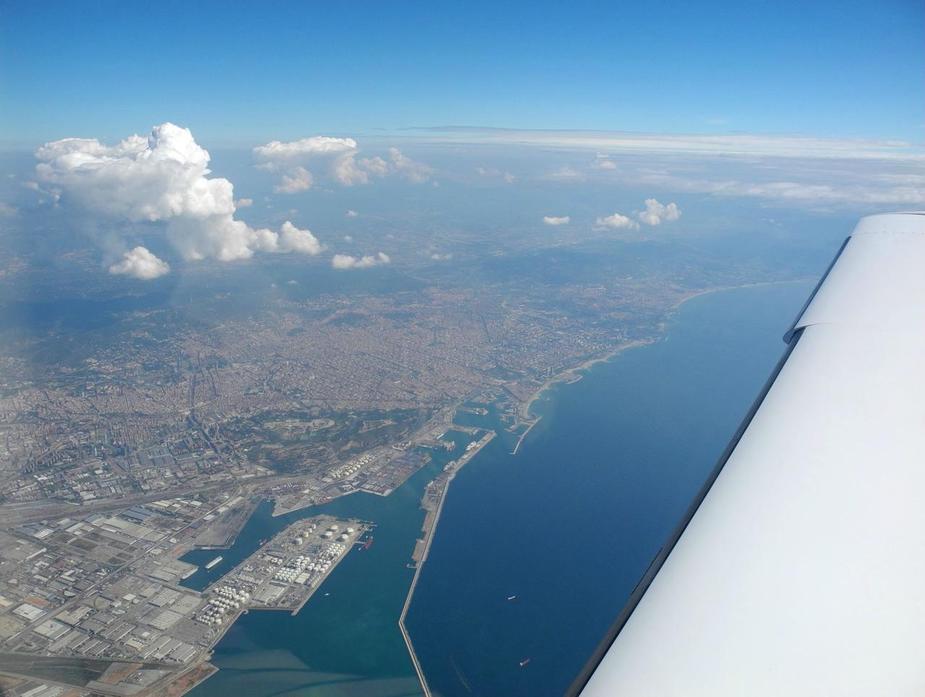
El Prat (LEBL).

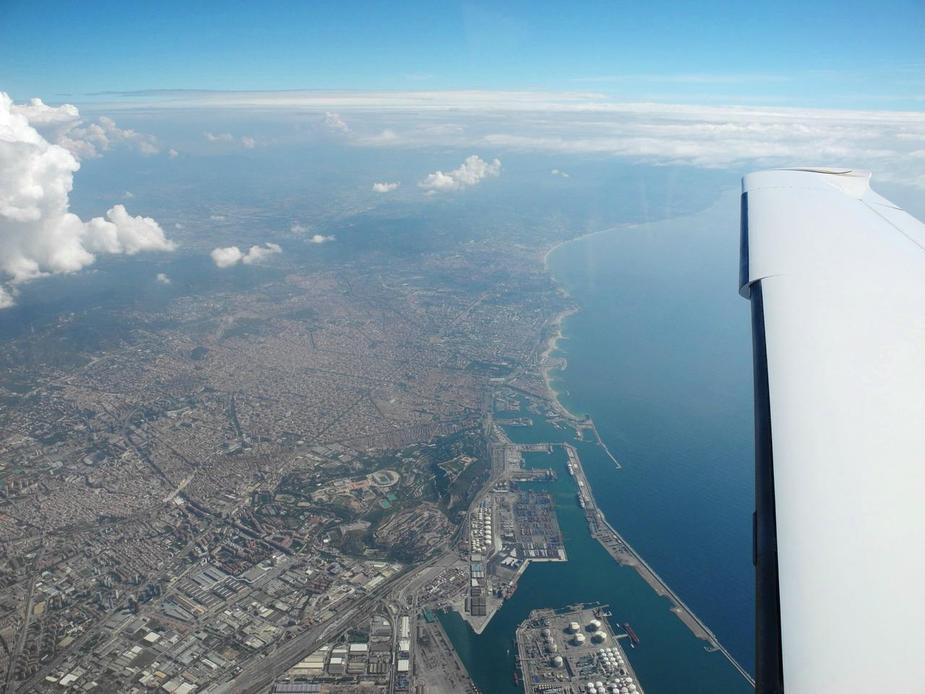
Typical Spanish landscapes.
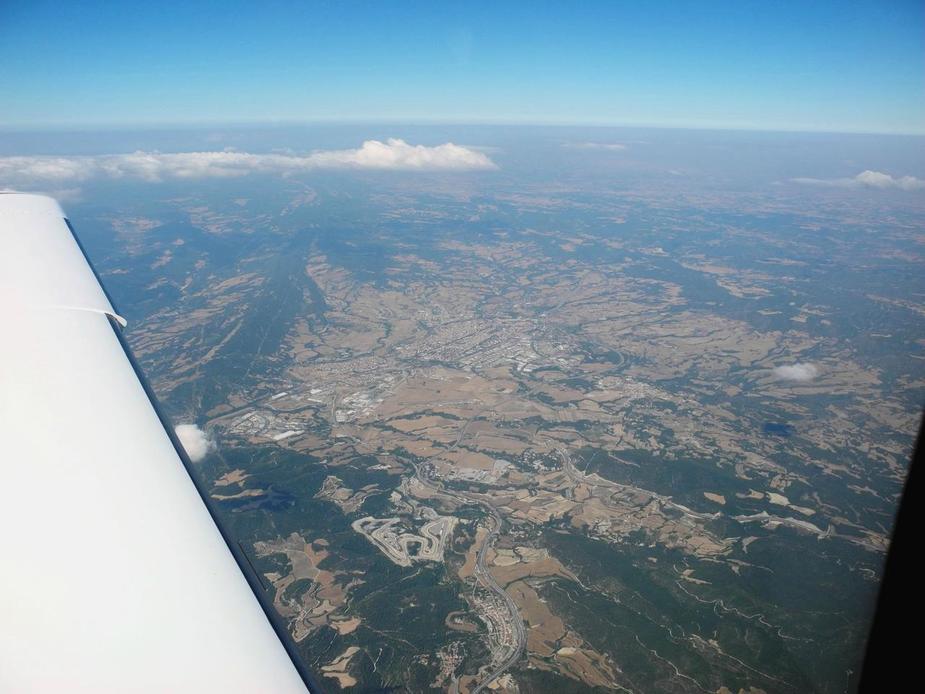
Igualada, northwest of Barcelona. The airfield is in the foreground.
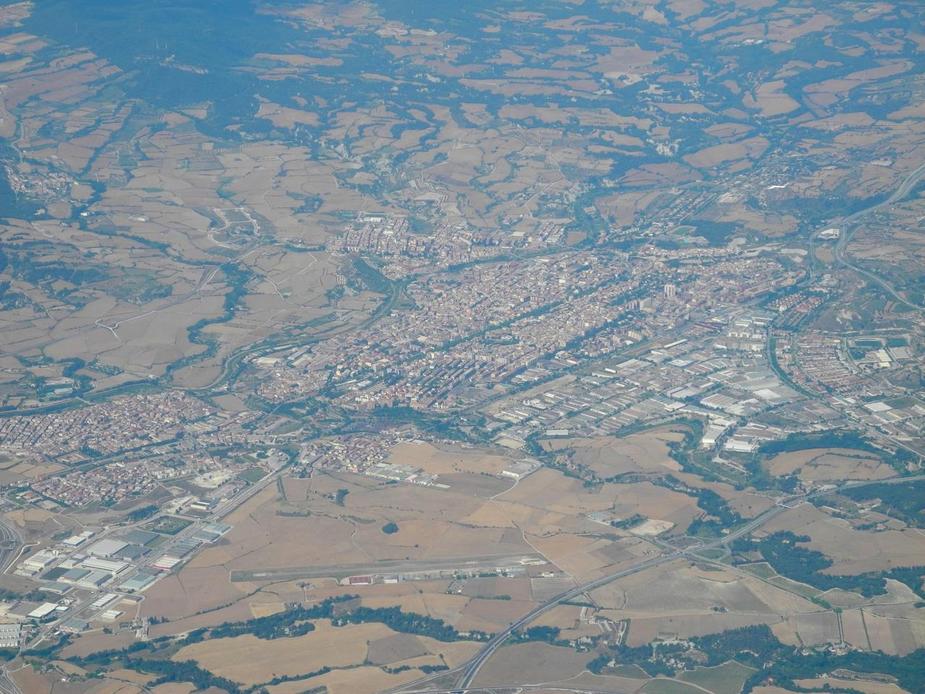
A lake in the foothills of the Spanish Pyrenees.
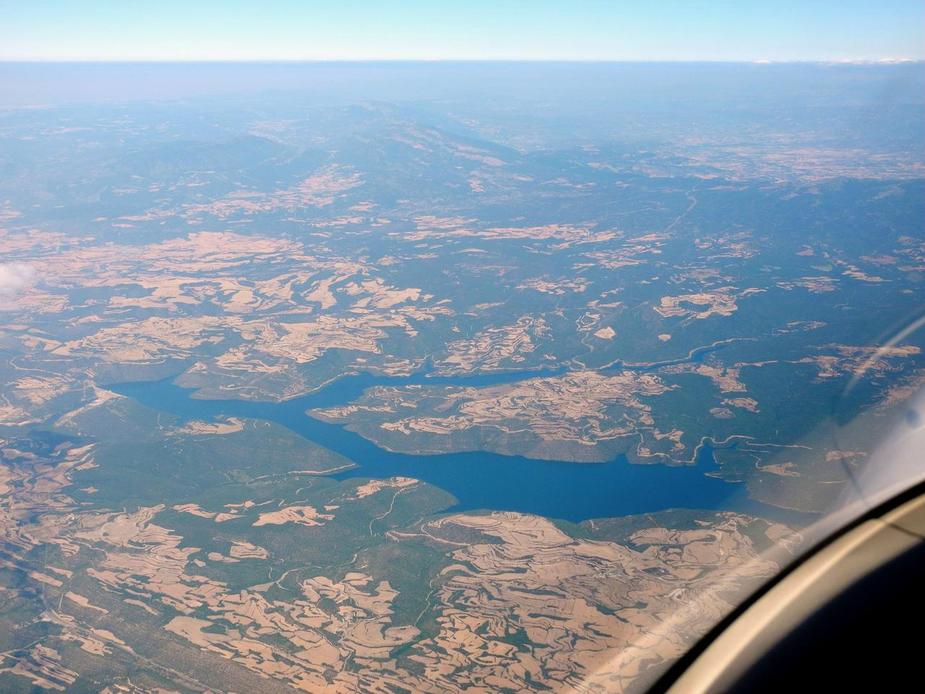
Here’s our further routing:
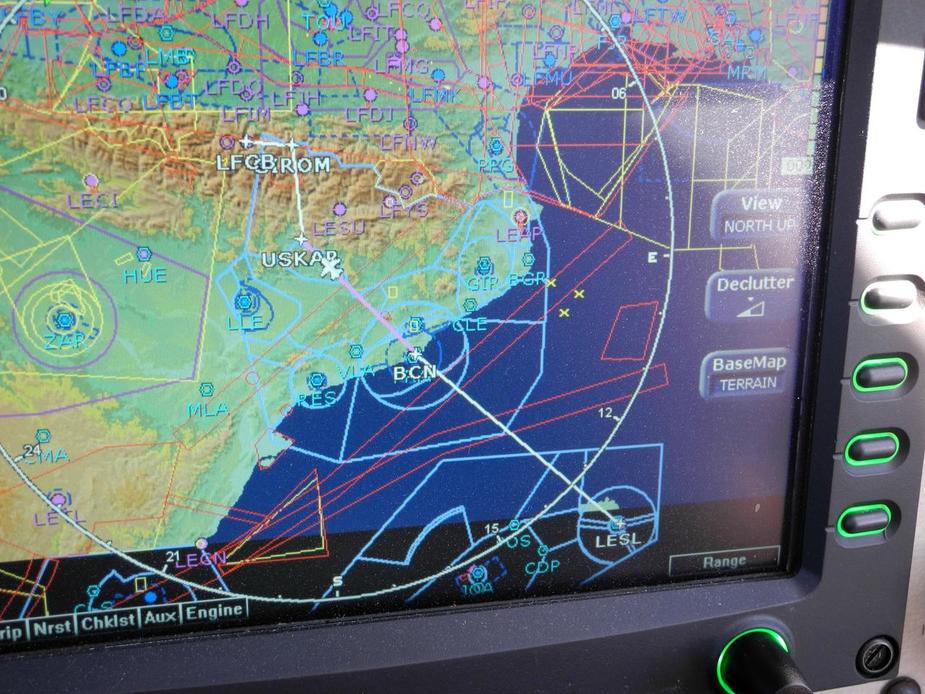
La Seu airfield (LESU) and Andorra remained to the right of us. Since it was cloudy on the north side of the mountains, we elected to remain IFR and then cloudbreak once we were well clear of the mountains to the north. The airway is between USKAR and GIROM, with a minimum level of 130. Remarkably, Spanish ATC didn’t ask us to climb at all (!) and we had to almost urge them to go up to FL130…
The Spanish Pyrenees.
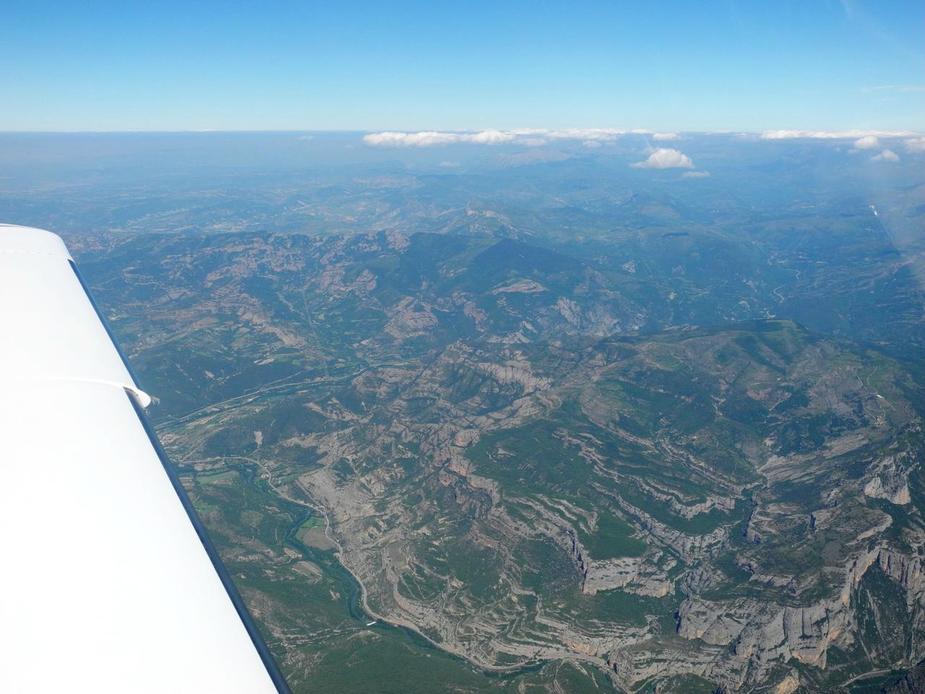
The highest peaks in that area are 11,000 feet high and the flight was beautiful (despite some stratus clouds blocking the views somewhat)
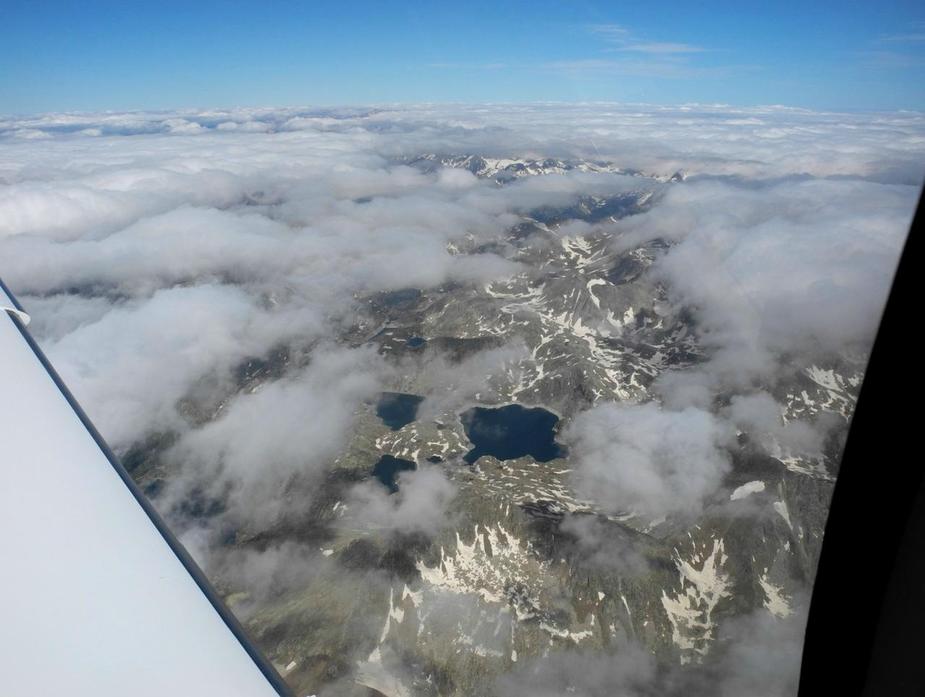
The approach to Bagnères-de-Luchon starts at a place called Cierp, a town at the northerly end of the valley. Bagnères is at its southerly end.
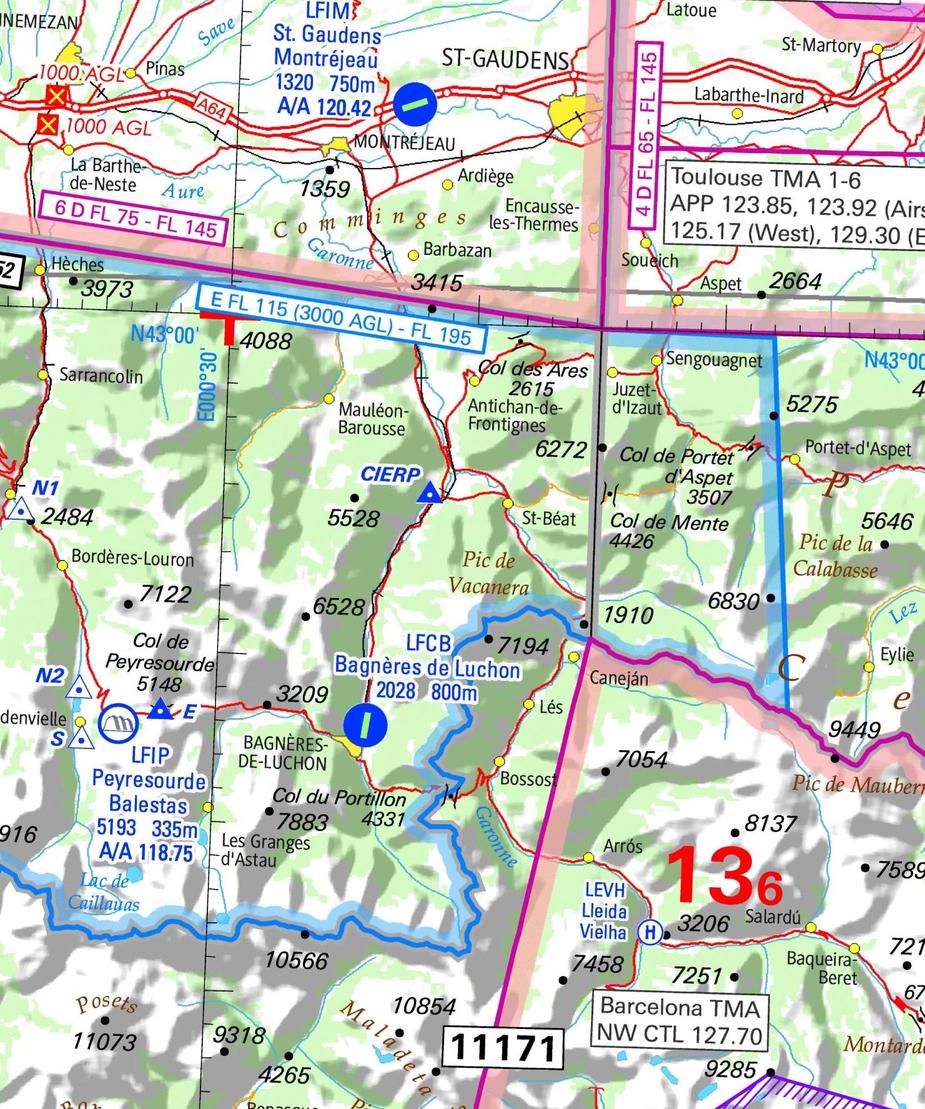
Here we are, north of the Pyrenees, after descending below the clouds whilst still IFR. I have to say, French ATC was perfect.
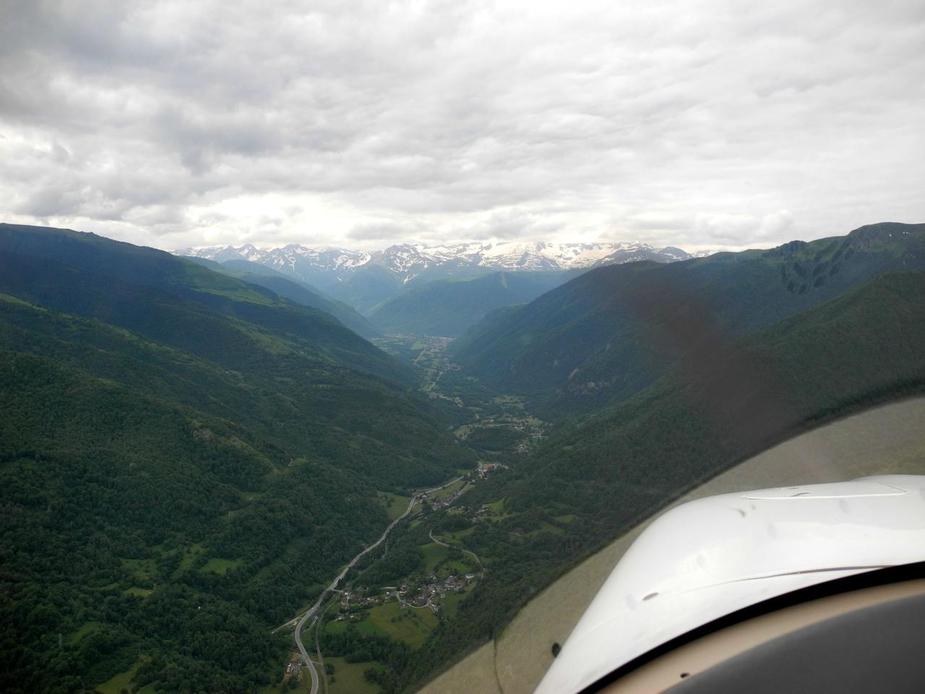
Due to the mountains, the circuit is rather tight, but it’s nothing too difficult, even in a rather fast aircraft. The runway in use normally is 01 (with the prevailing winds coming from the north).
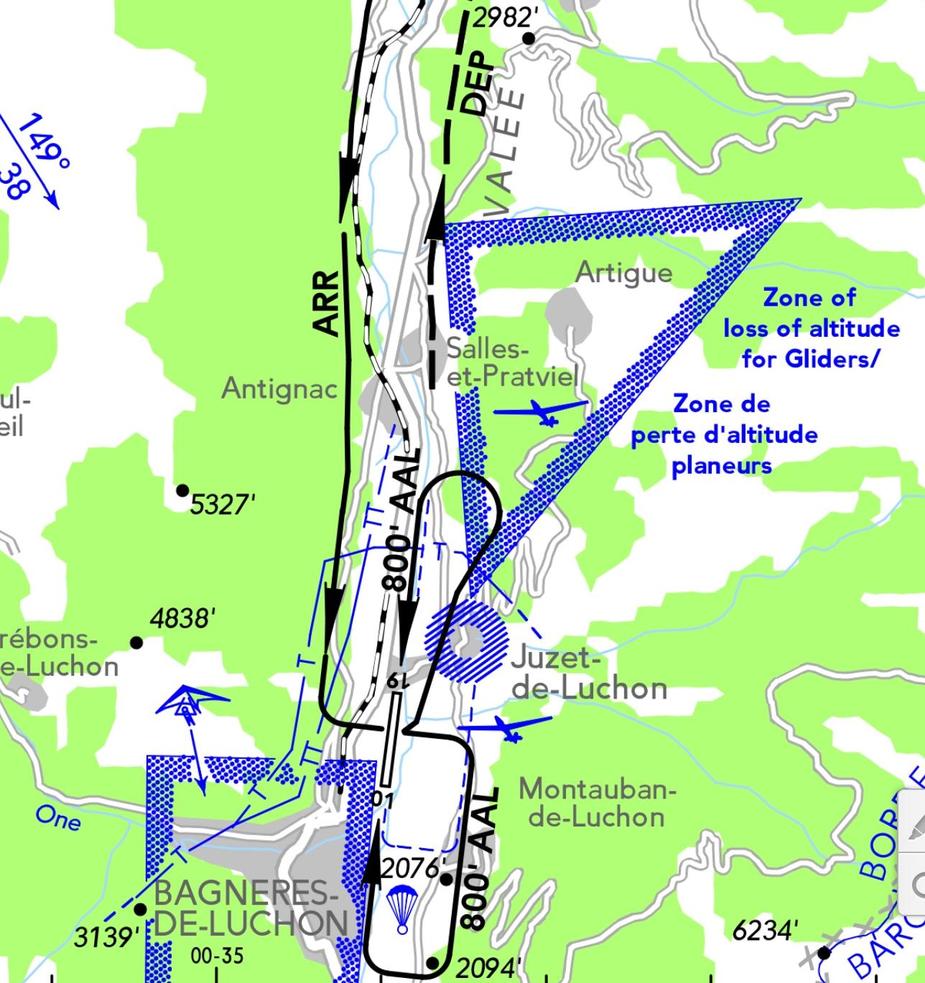
Here we are. The runway (775 metres of fine grass) is in the centre of the picture. It’s right next to town (walkable on foot).
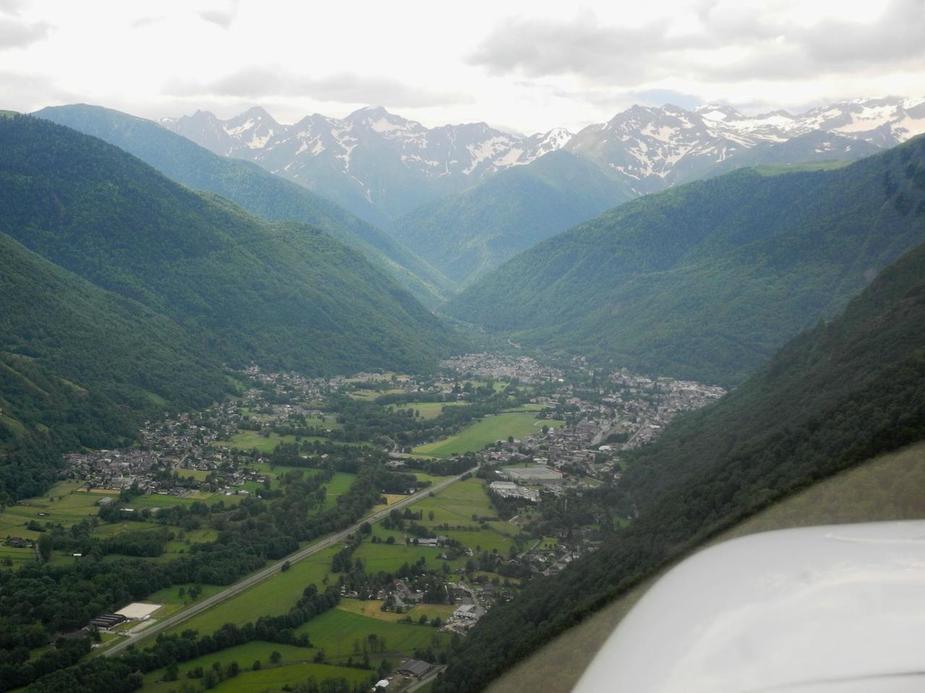
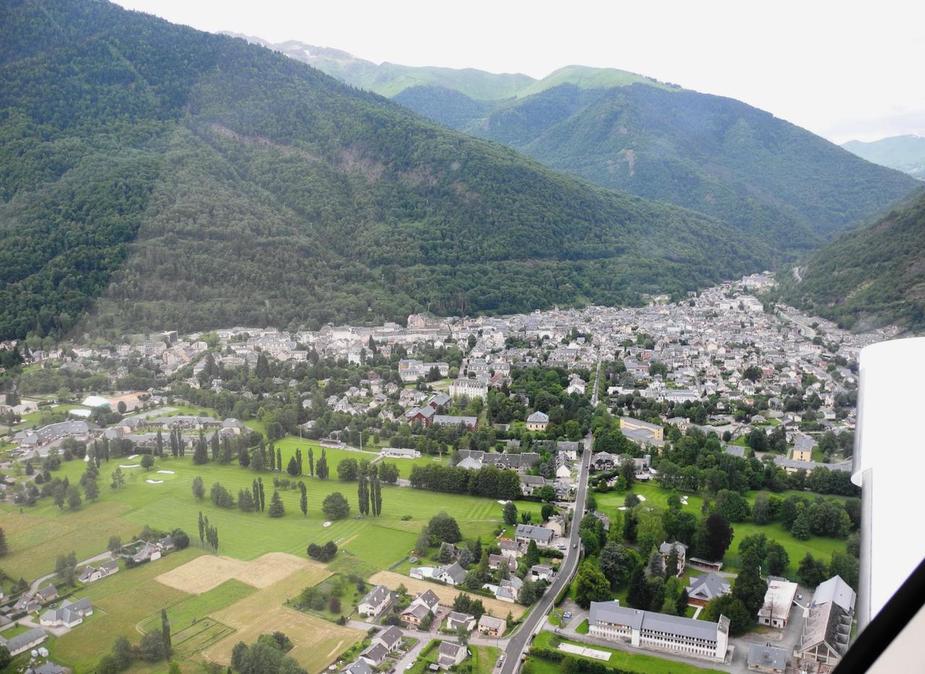
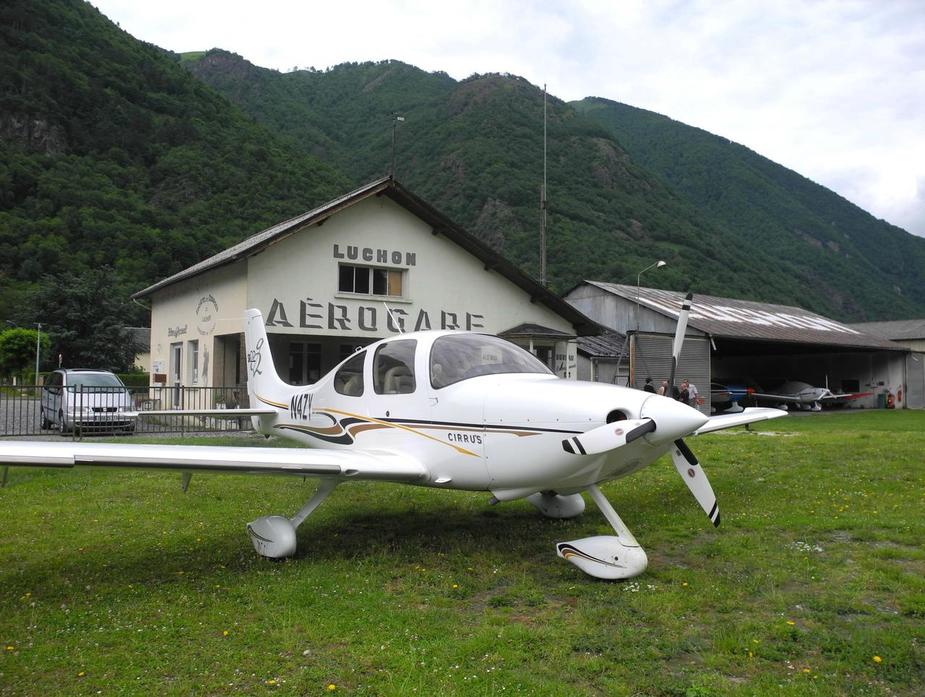
The welcome from the folks of the aeroclub was super-friendly. This must be one of the most picturesque airfields in France.
The town’s main street, with lots of hotels and restaurants.
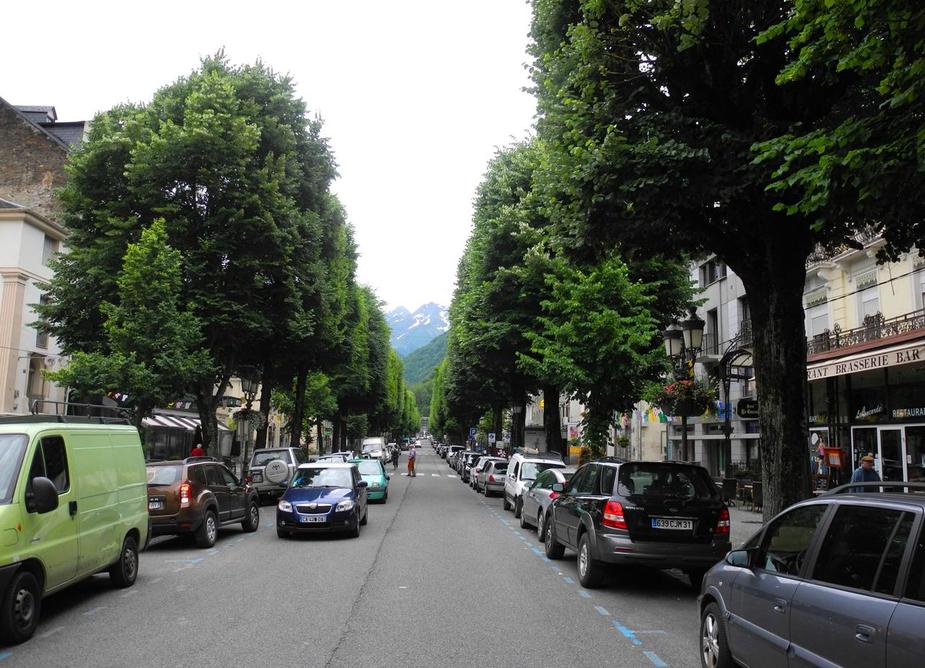
We found out that there is a beautiful 9-hole golf course in Bagnères, again in easy walking distance. So, in the afternoon, we decided to play a round…
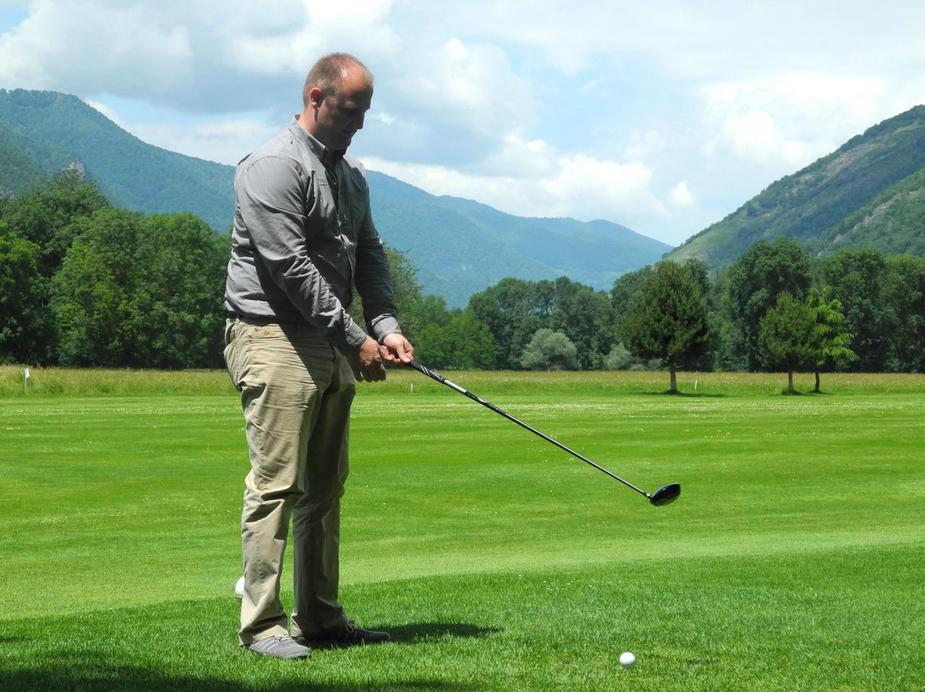
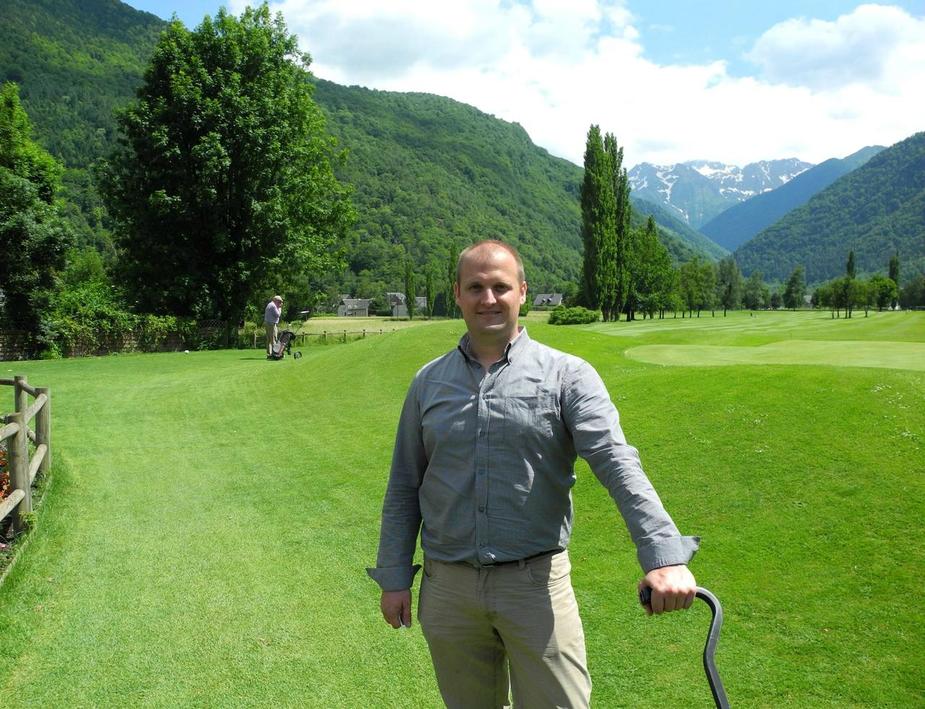
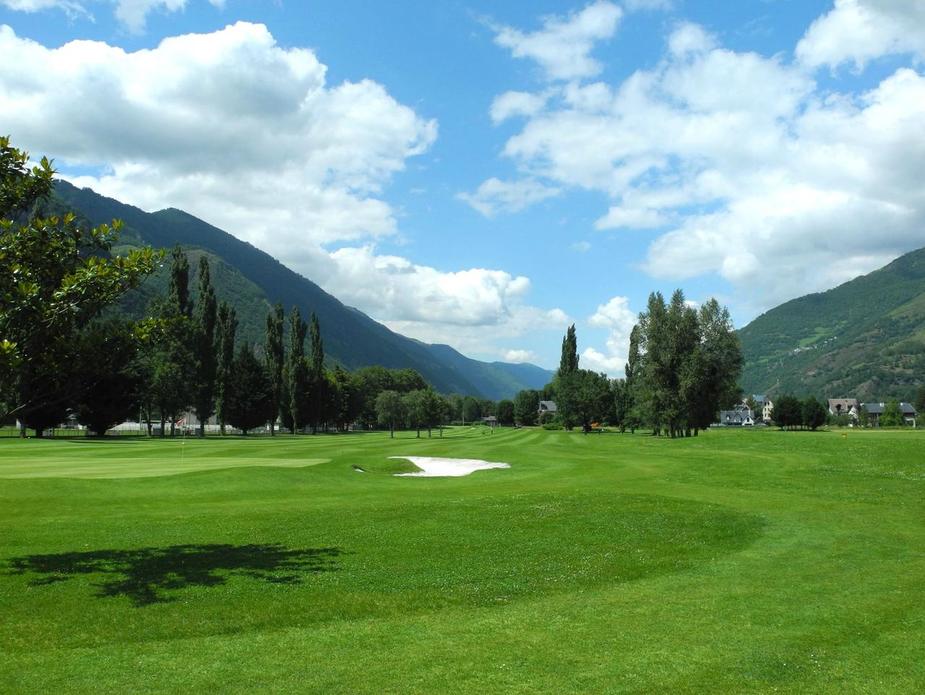
This was my drive on one of the par-3 holes. Missed the birdie, though…:-(
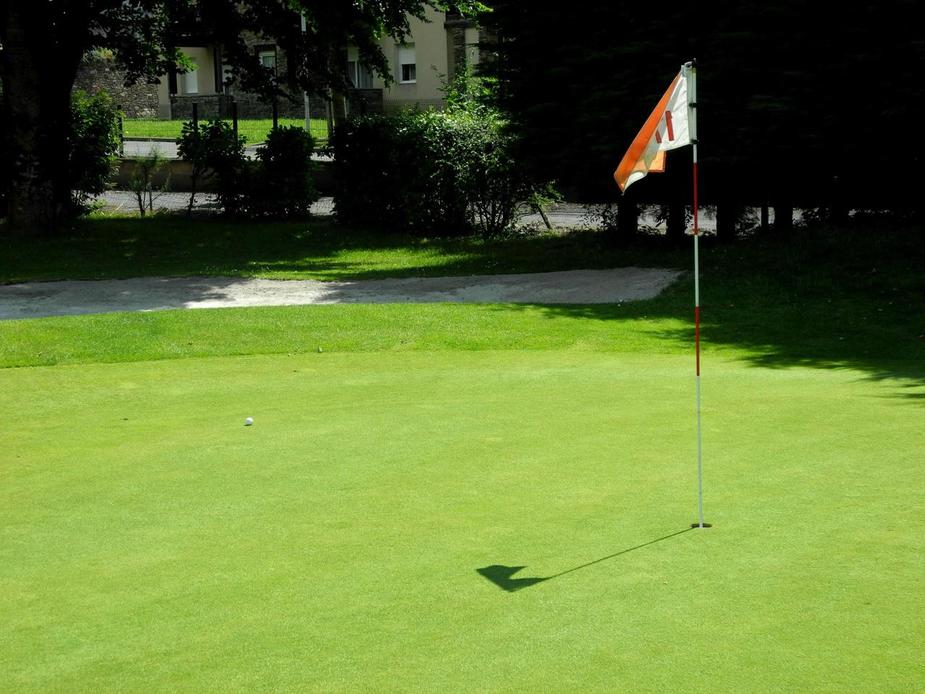
The evening put a nice end to a great day, with the 4:0 result of Germany against Portugal  . We watched the match together with a handful of german bikers who were touring the Pyrenees.
. We watched the match together with a handful of german bikers who were touring the Pyrenees.
The next morning, we decided to head for the French Atlantic coast (the weather forecast was perfect). The destination of choice was Arcachon (LFCH). I have previously been in the Arcachon area about 12 years ago and throughly enjoyed it. We decided to fly VFR on this 45-minute flight.
Sunshine and an aircraft awaiting us at the airfield.
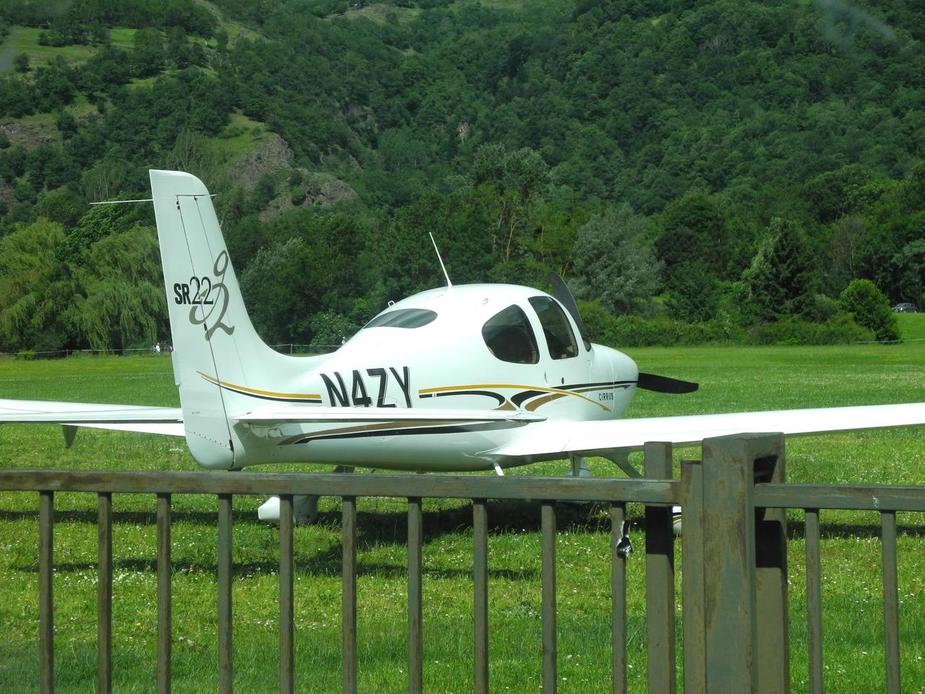
Ten minutes after departure from runway 02, we were well clear of the Pyrenees and started dealing with the French airspace. However, as usual, French ATC was perfect and approved all our requests. We cruised at 3500 feet.
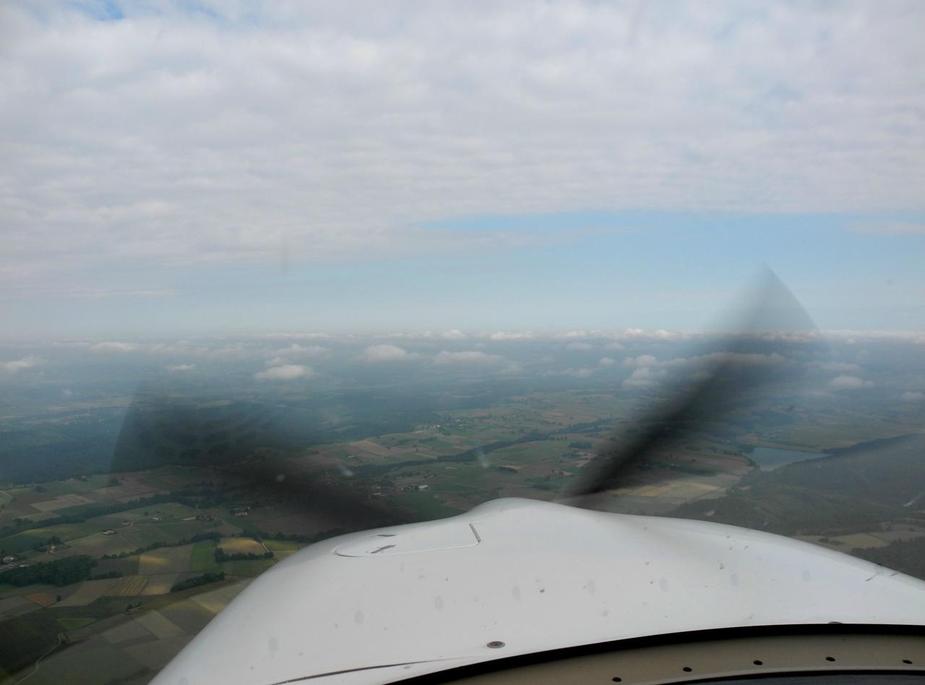
A last look back at the Pyrenees.
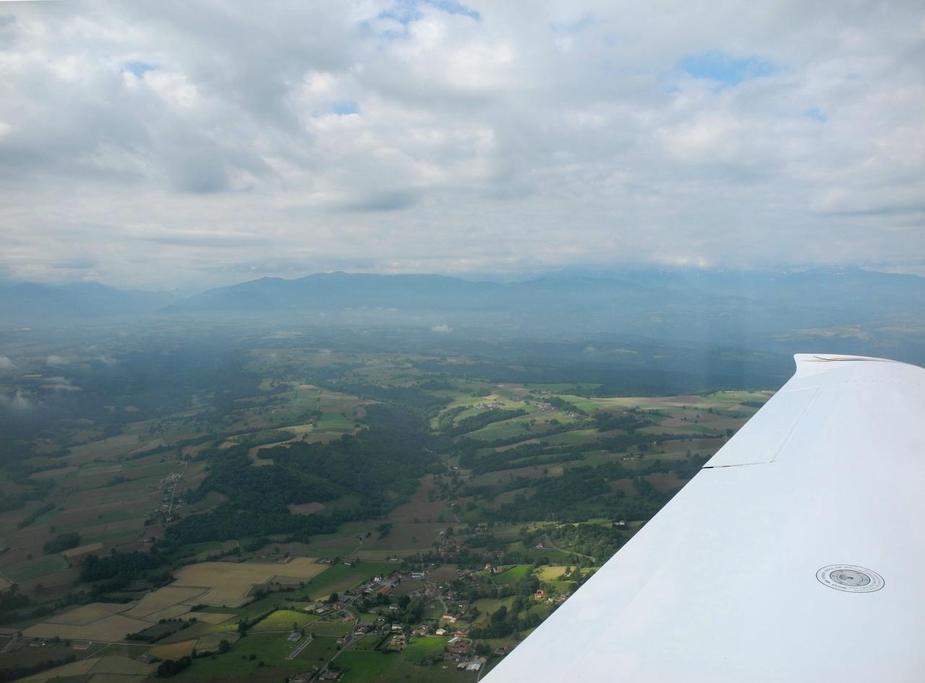
Here’s our routing. Roughly via Tarbes, Mont-de-Marsan, Mimizan and Biscarosse to Arcachon.
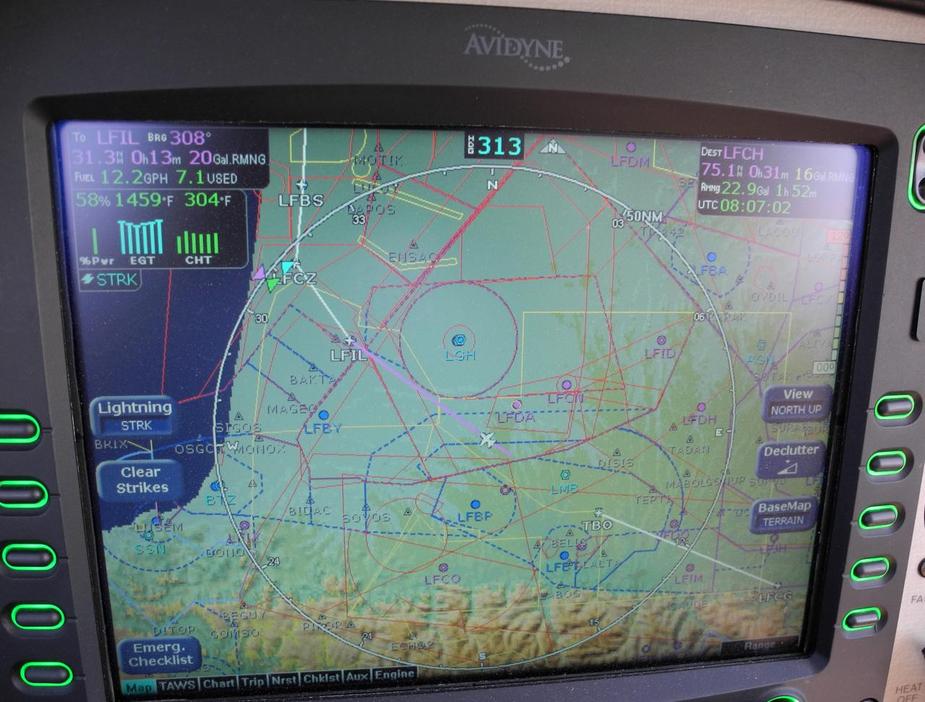
Landscpaes change very quickly in that area. In one moment, the view outside was like this (typical of the foothills of the French Pyrenees):
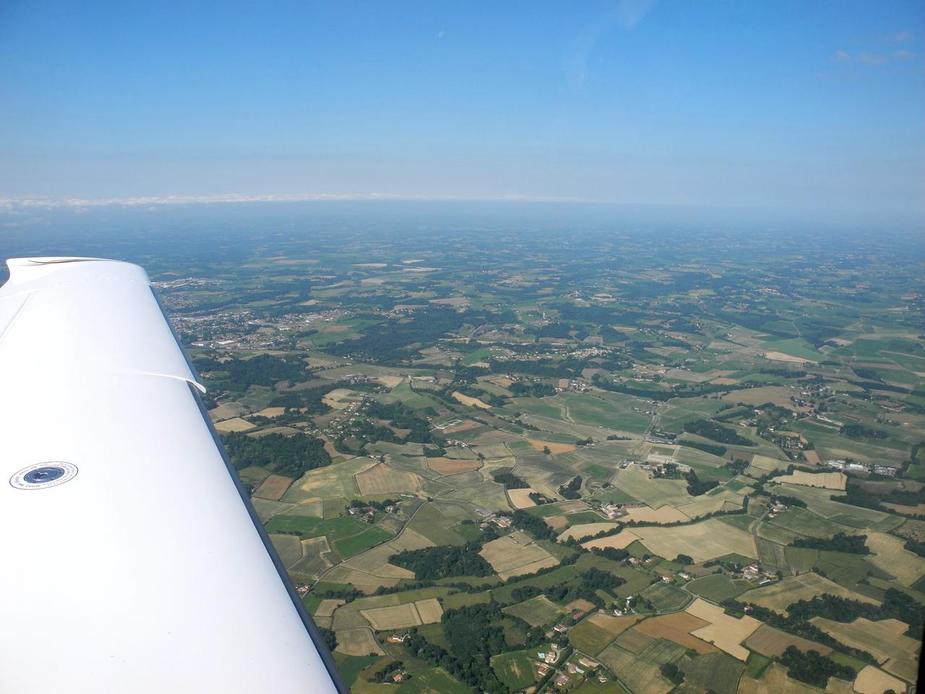
…and only one minute later, it was like this, which had a more more “Atlantic” feel to it:
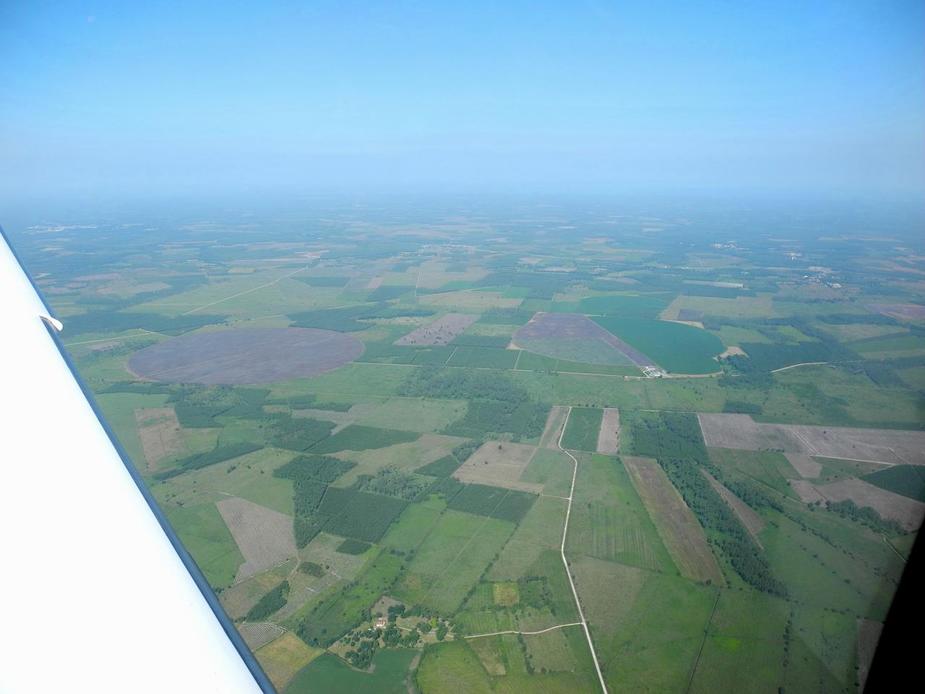
Here’s Mimizan airfield (LICZ) which is always full of parachuters. Also, a first glance at the Atlantic Ocean.
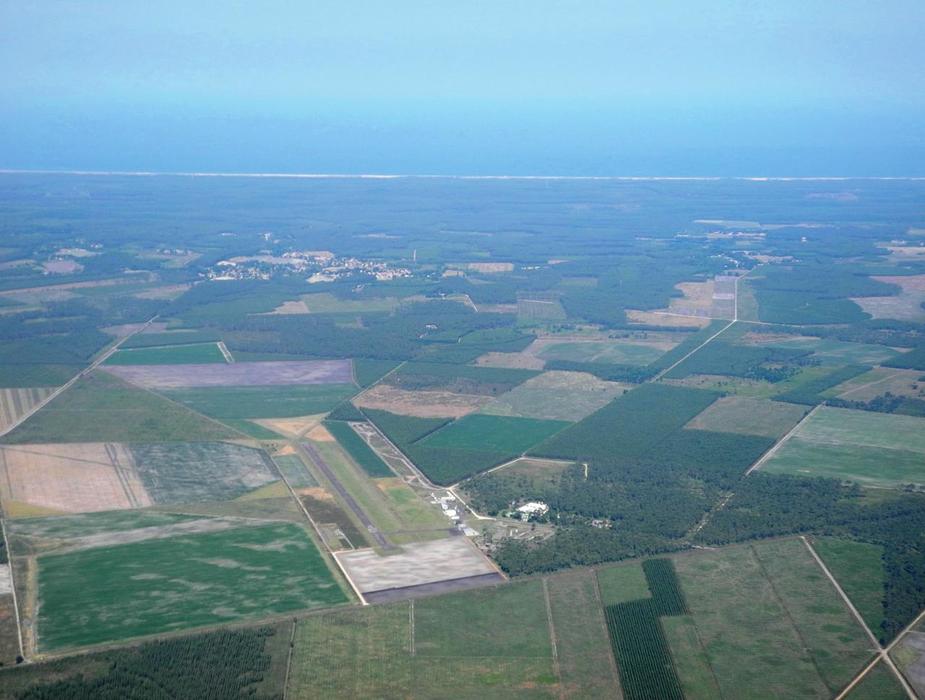
Again, French ATC was perfect, especially Cazaux Military, who – despite some heavy activity (we saw the traffic passing above and below us) – allowed us to fly as requested.
Here’s Biscarosse (LFBS). I never understood why this sleepy airfield had an air traffic control tower…
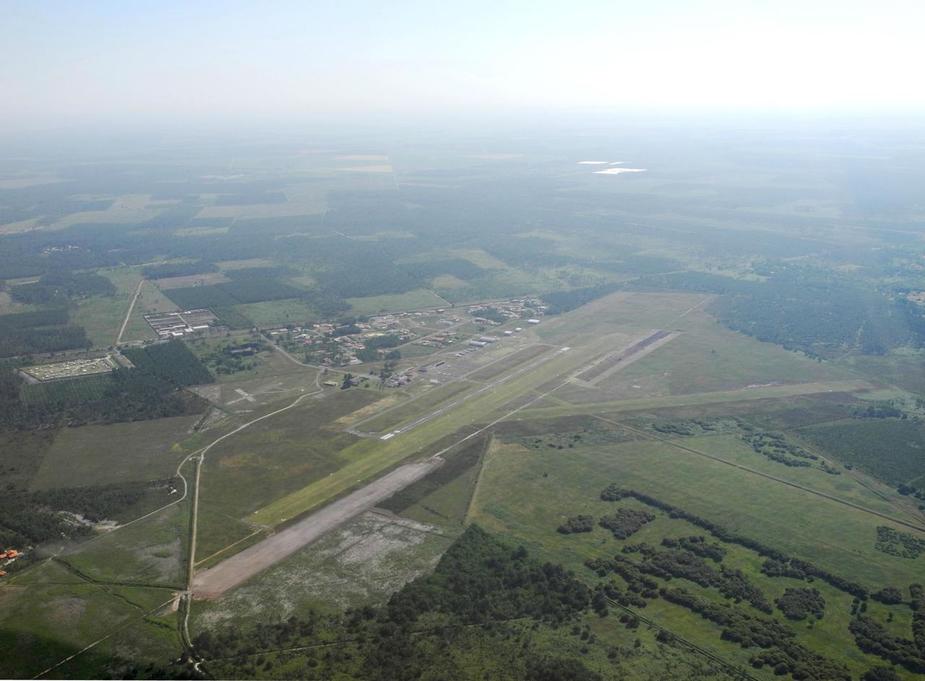
And here’s the famous seaplane base. AFAIK, it is nowadays not in use except in occasion of the biannual fly-in. I was thus quite surprised to see a C172 do touch ‘n go’s right below us.
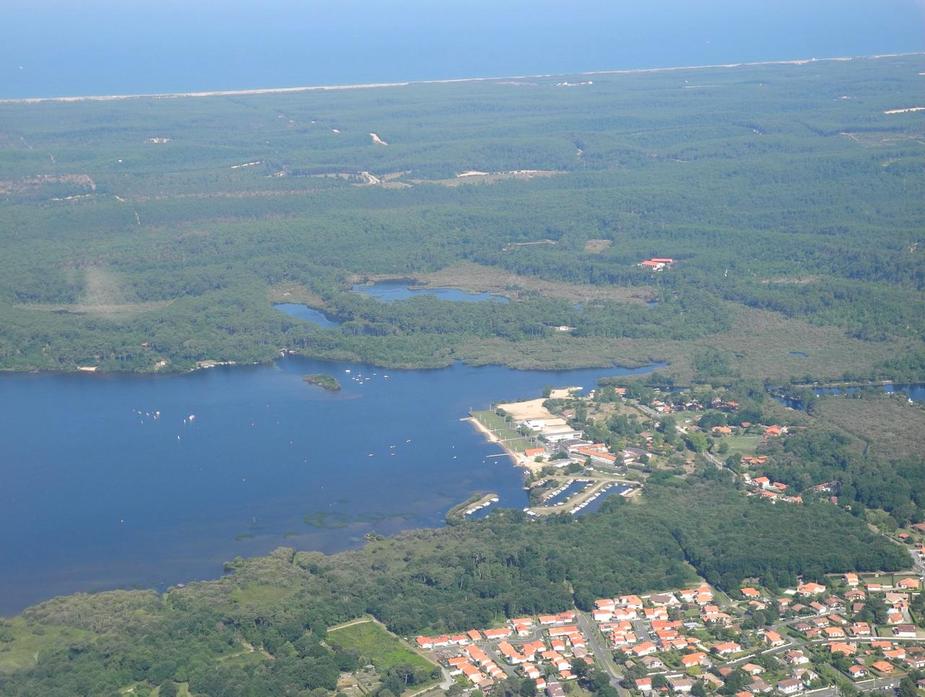
Biscarosse-Plage.
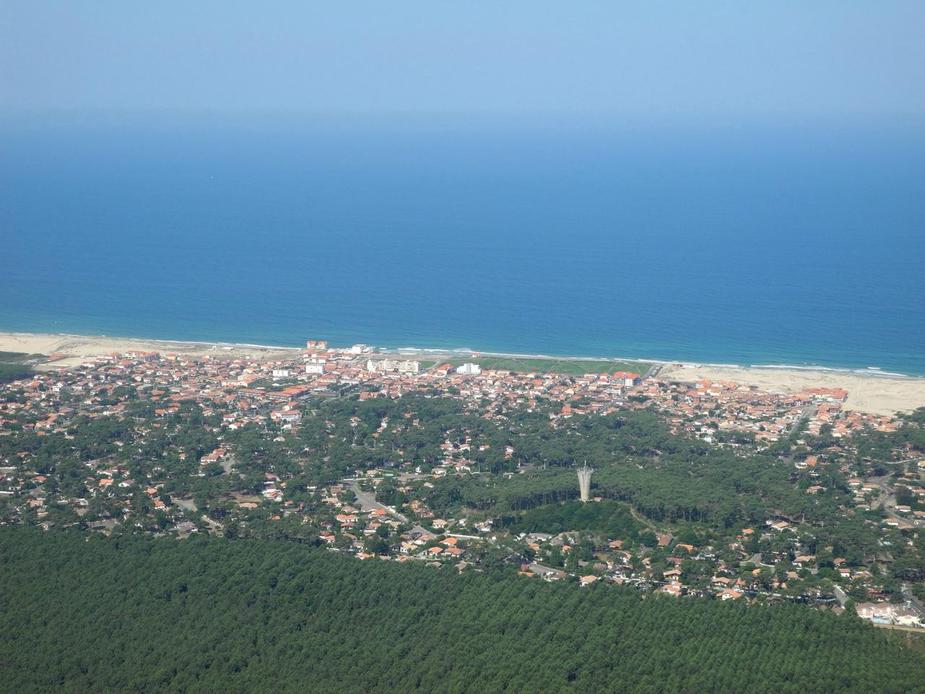
Flying up the coast towards Arcachon…
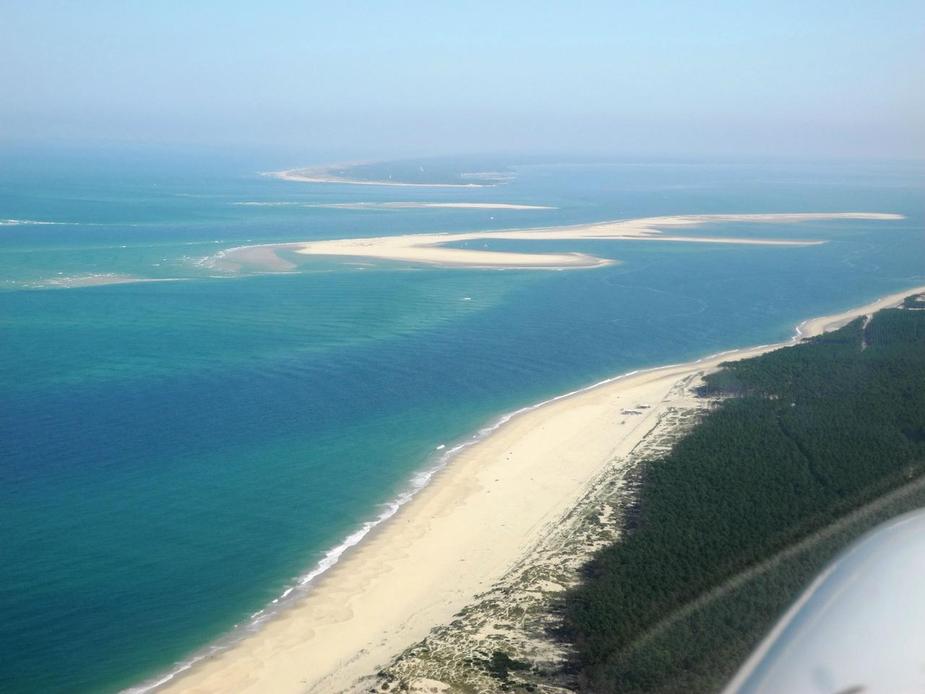
..and past the famous Dune of Pyla.
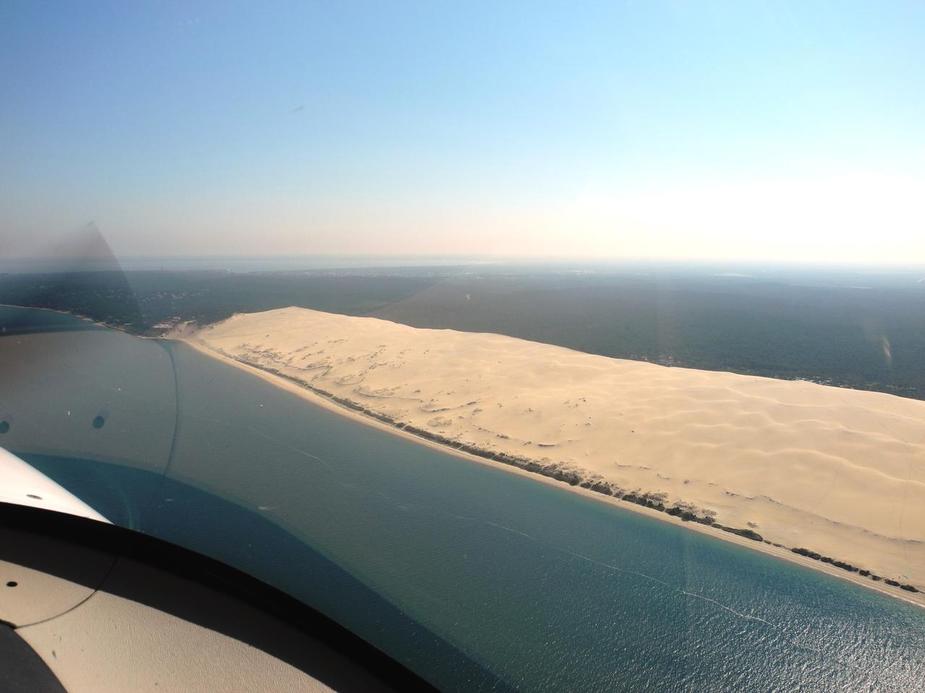
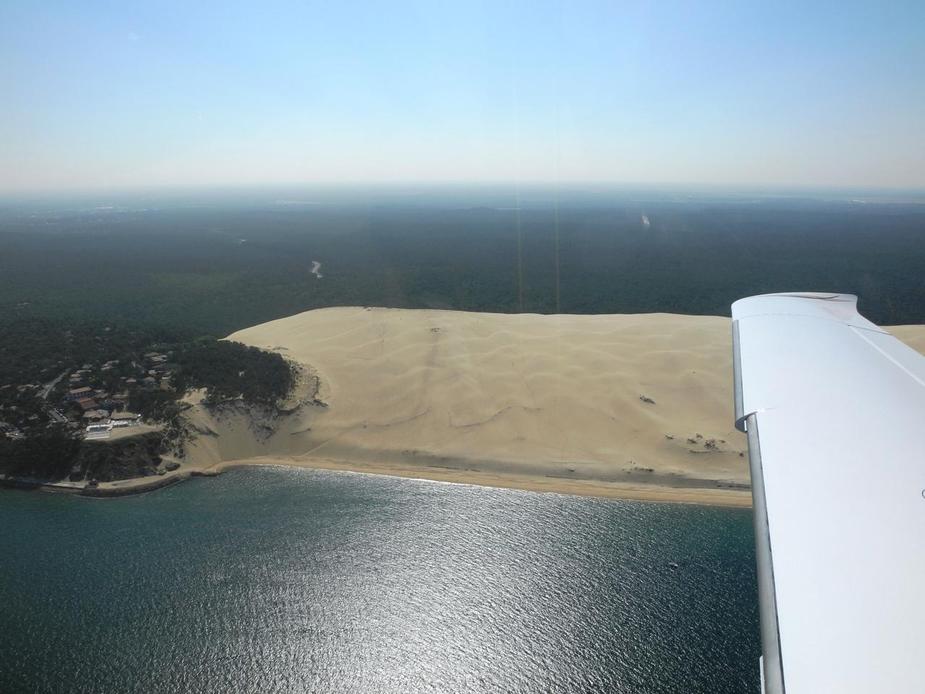
Turning eastbound…
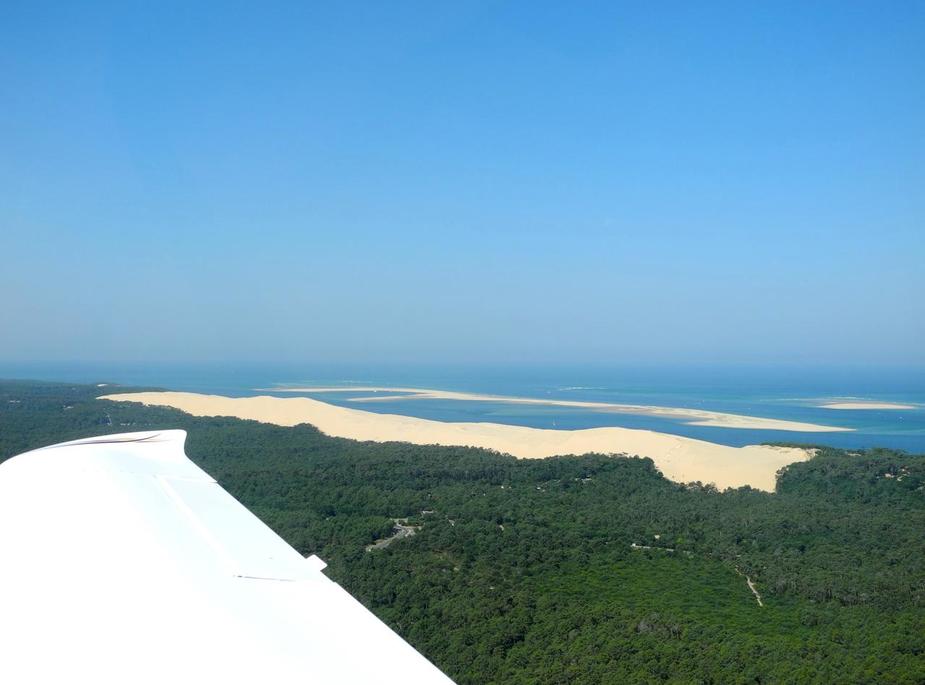
…put us right on final approach for runway 07 at Arcachon.
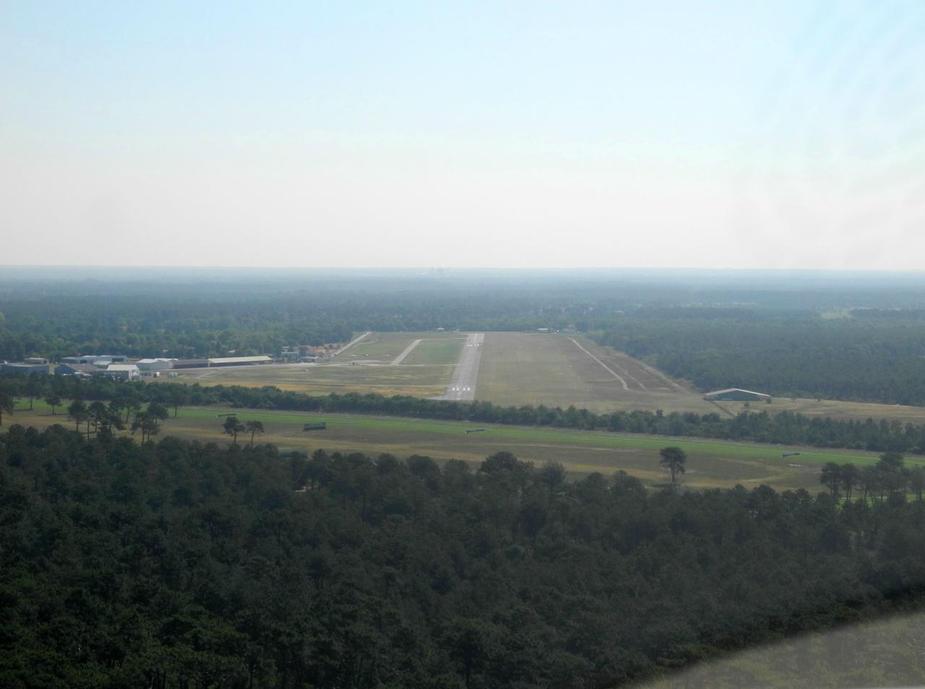
Taxying in. The airport has recently undergone a complete “major overhaul” and I would now call it one of the tidiest and most wonderful GA airfields on the Atlantic coast of France. Also, the personell was extremly friendly and helpful. These guys know how to do tourism.
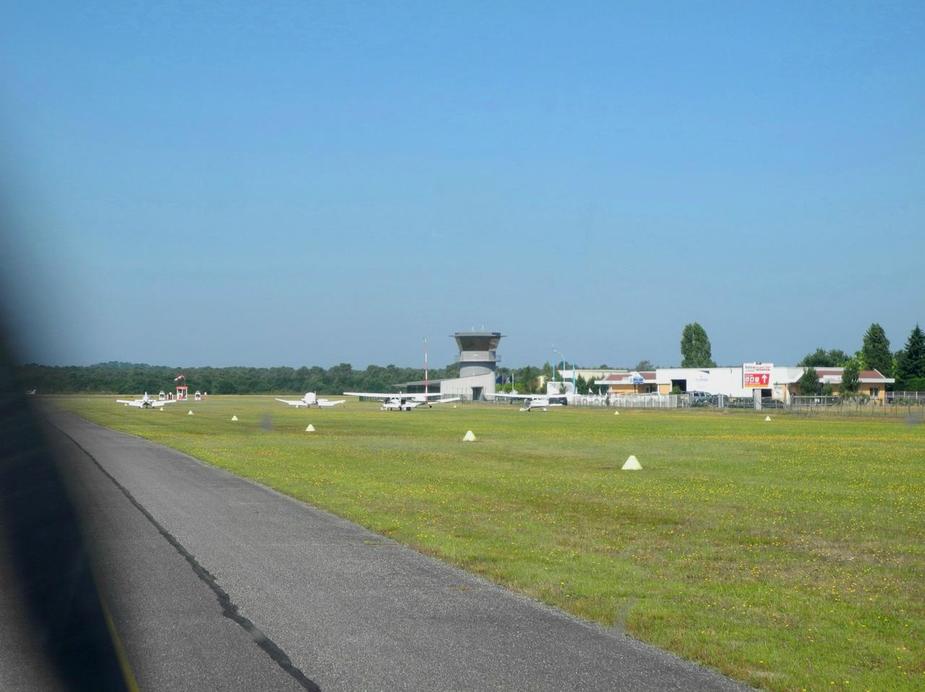
Another TOTAL pump with a card machine.

As usual, my pax was assigned to refuelling service. Remarkably, this was our first refuel since leaving Mende!
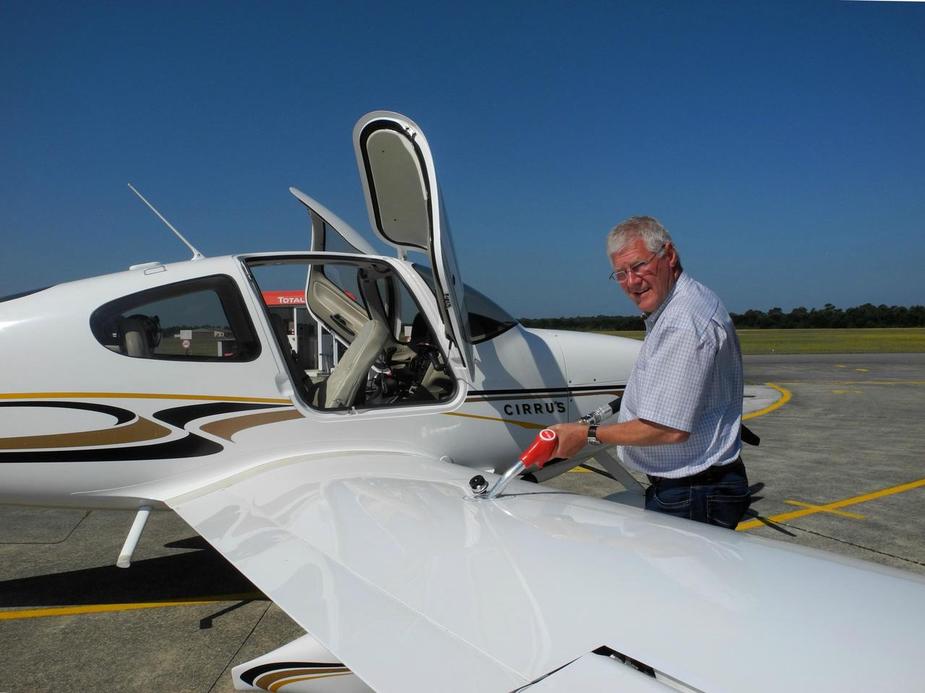
One nice “feature” of Arcachon airfield is that there is a rental company on site that rents out 40 year old (but well maintained) “2CV” cars (“Ente” in German), which makes for a nice “holiday in France” feeling.
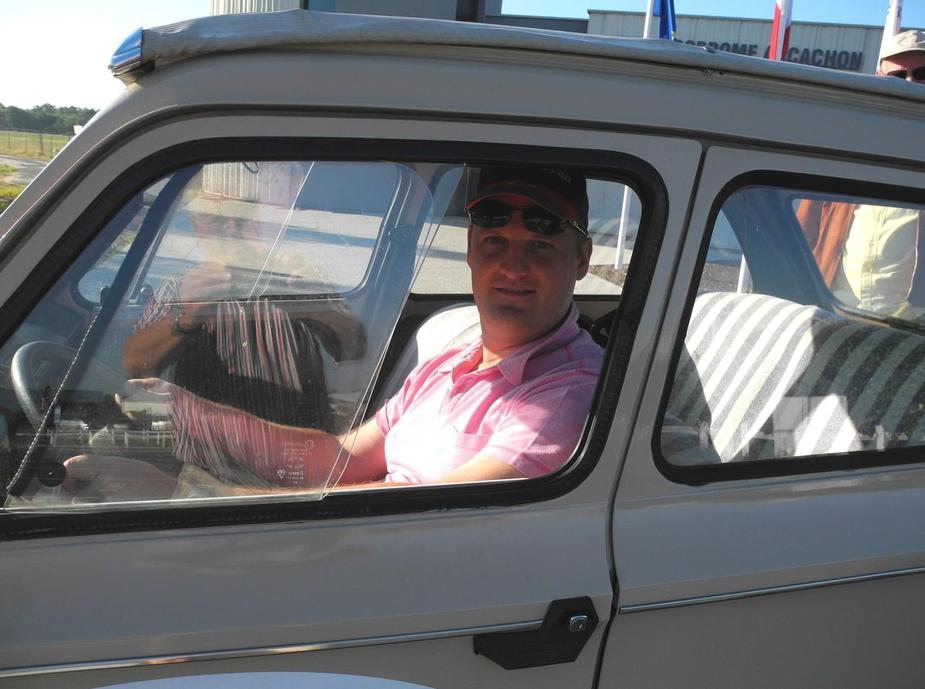
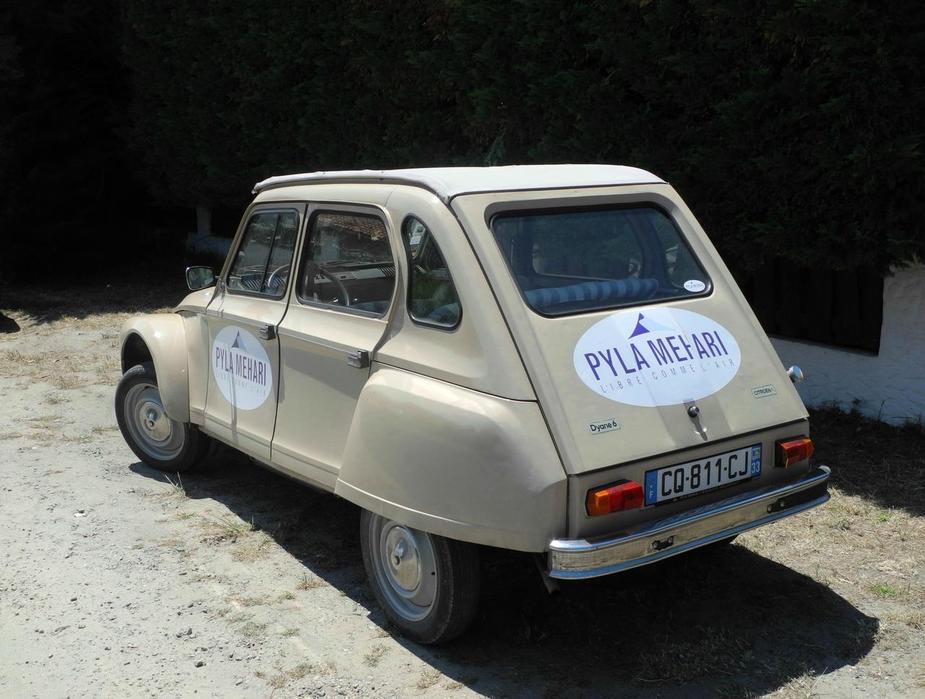
The area of Biscarosse has some beautiful lakes.
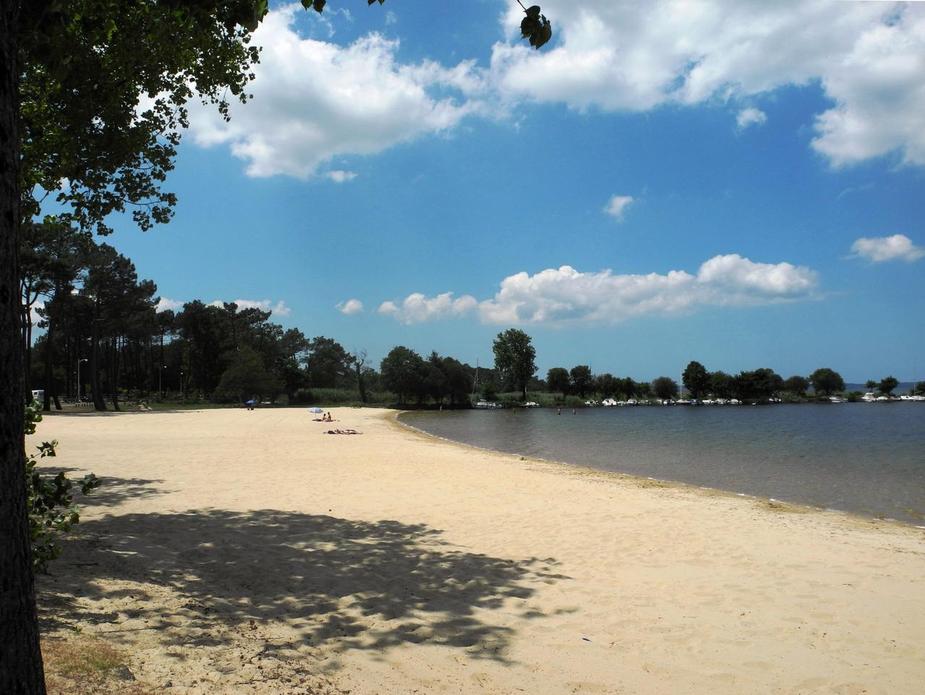
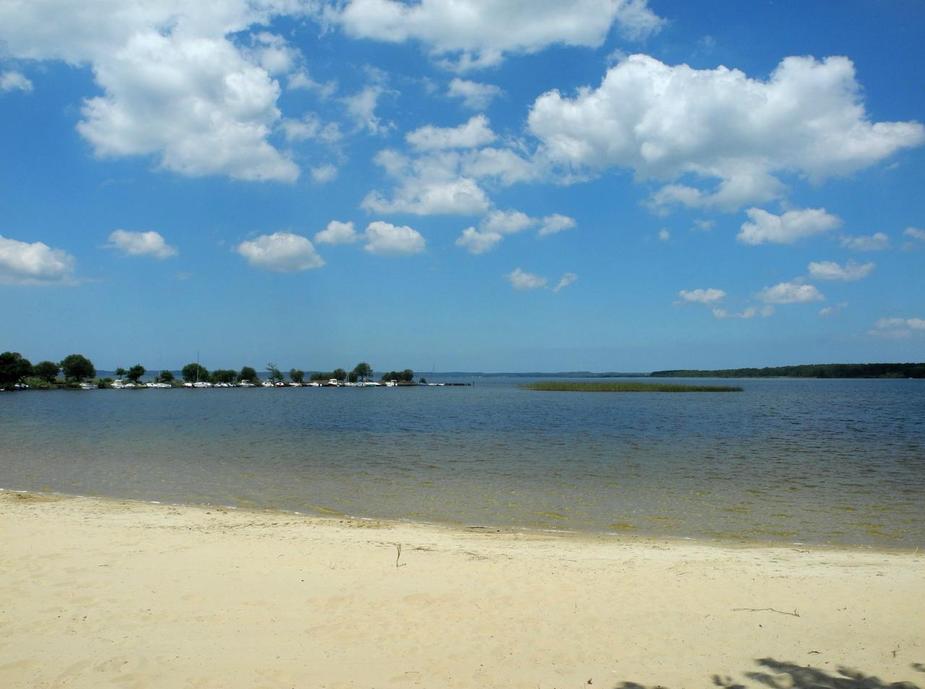
However, after lunch, we quickly headed for the beach.
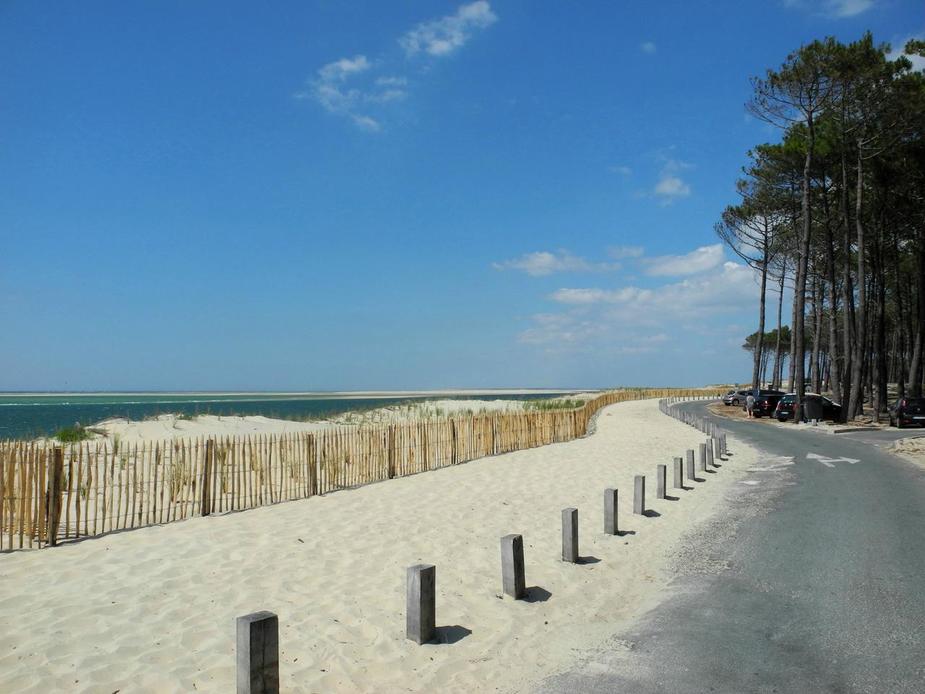
Me and my dad.
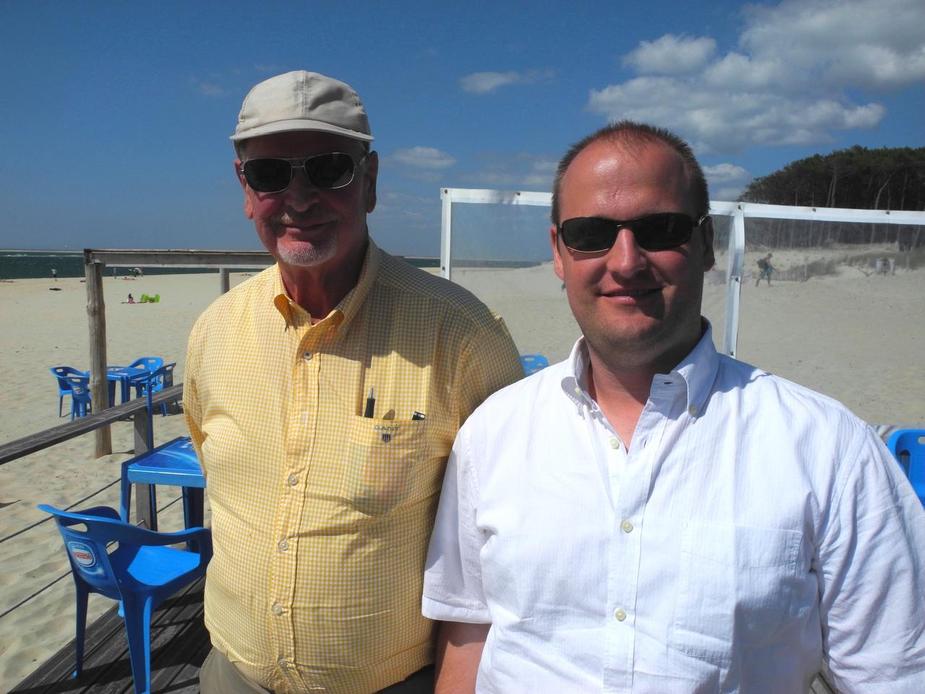
Just south of Arcachon.
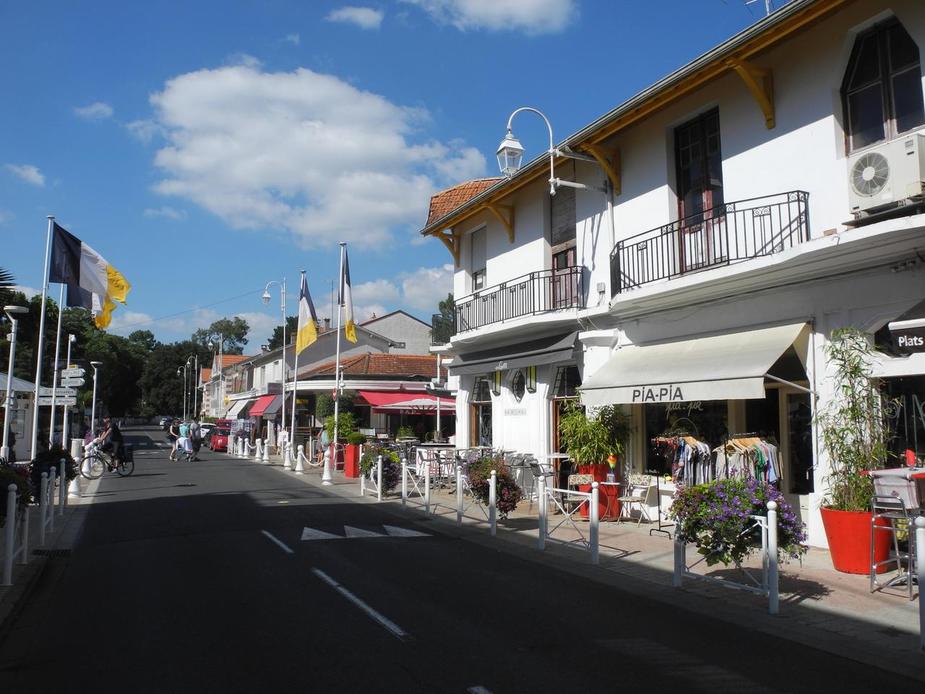
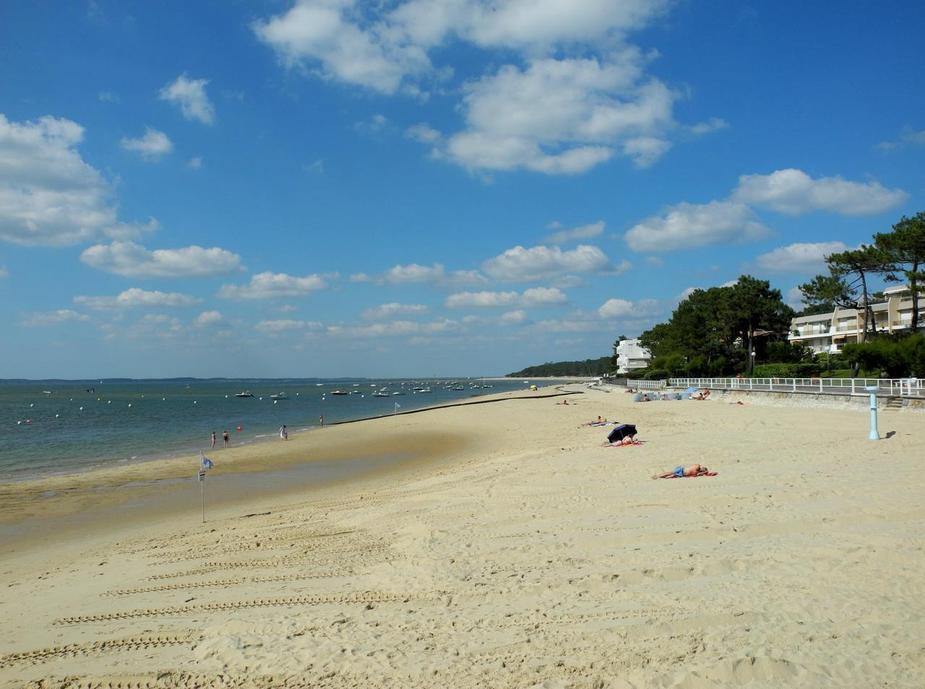
The following day, we toured the Bay of Arcachon with our trusty 2CV. As I mentioned in another thread, driving the 2CV felt, smelled and sounded exactly like flying the average 1970s’ aeroclub Cessna 172… 
Andernos-les-Bains.
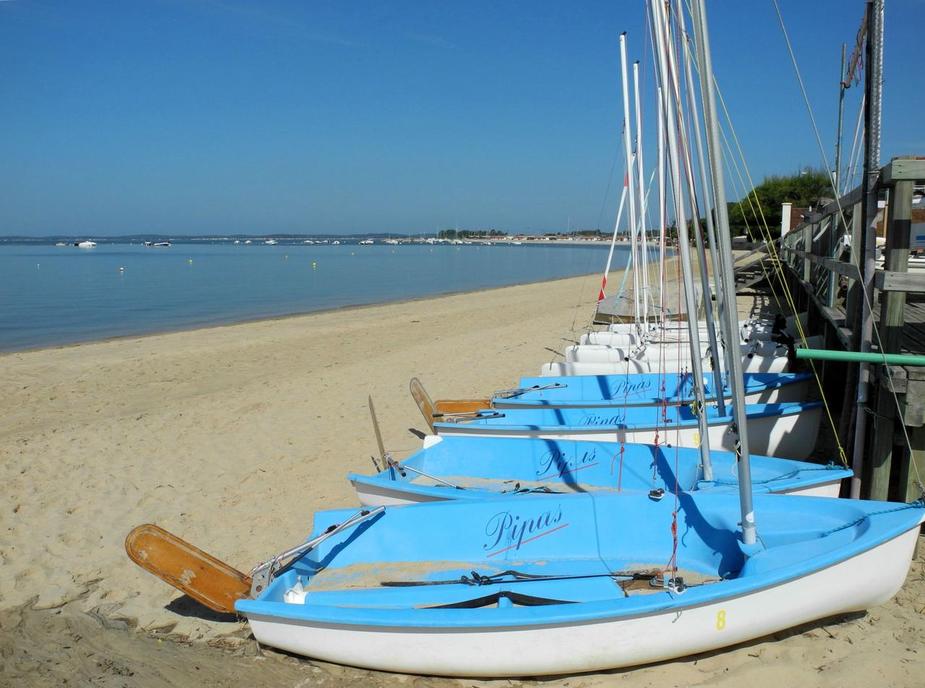
Cap Ferret.

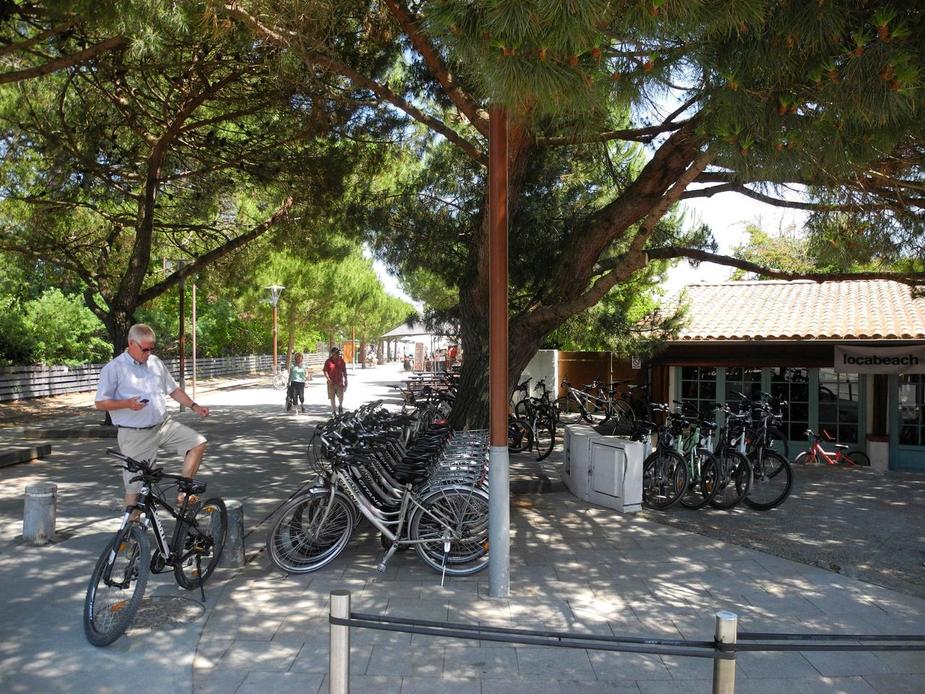
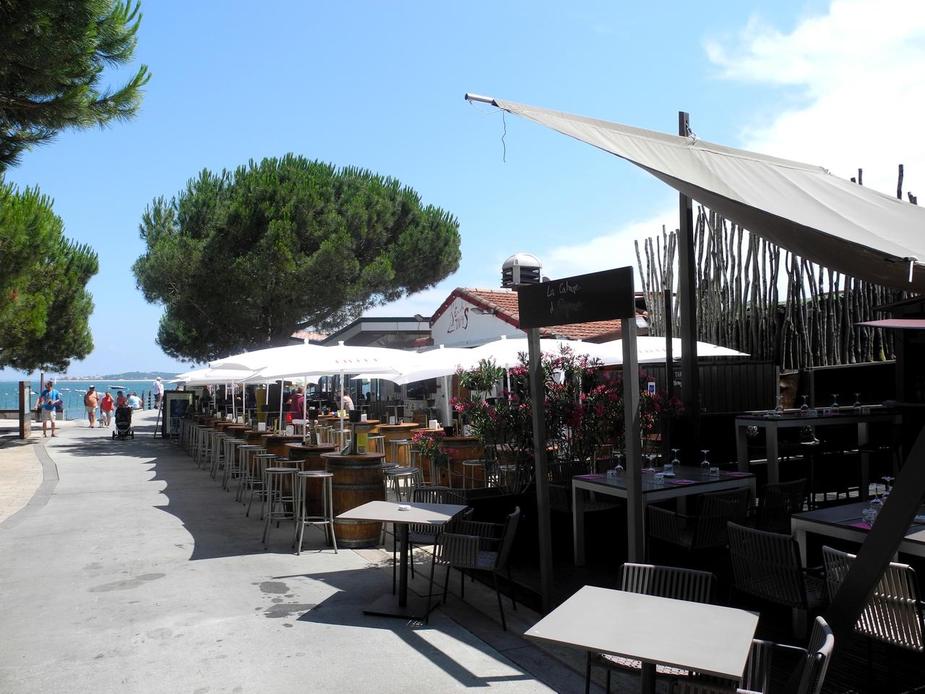
Oyster beds abound.
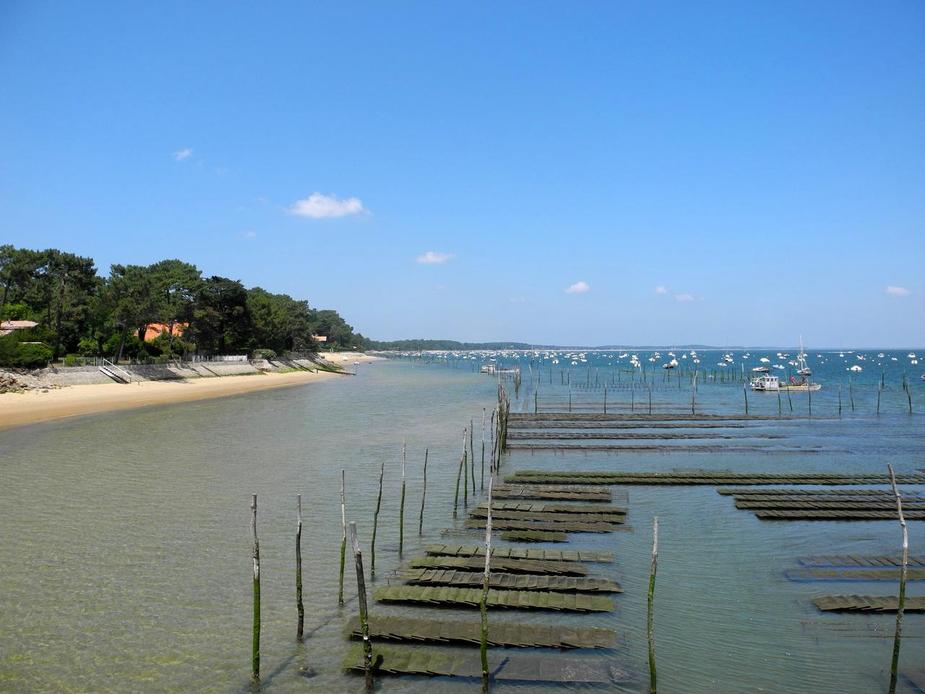
Off to the beach again.
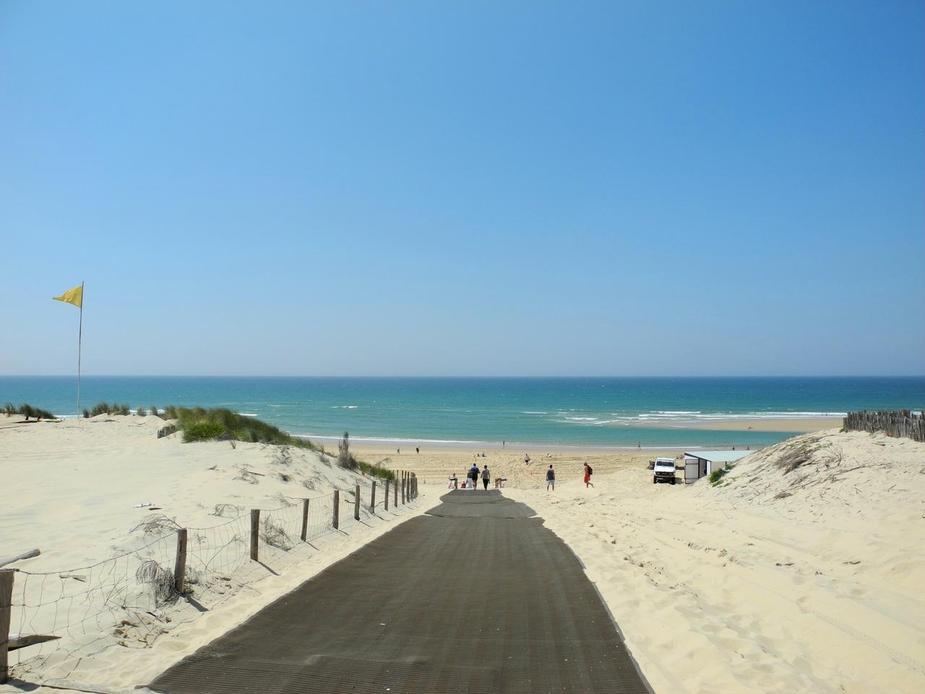
Cap Ferret is full of fortifications stemming from the Atlantikwall.
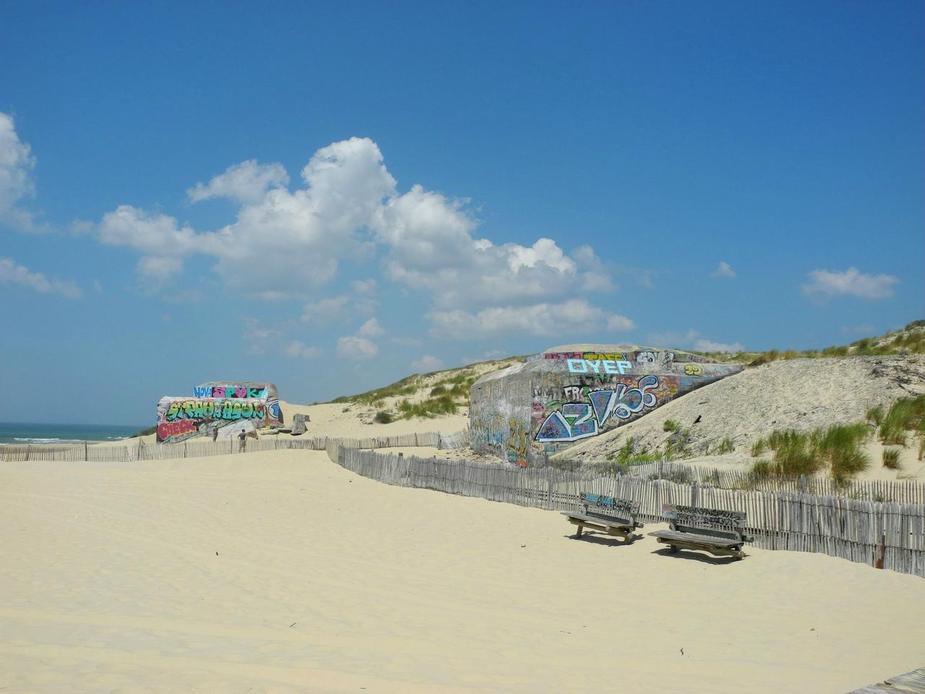
The Sea was cold, but not too cold for a very short swim.
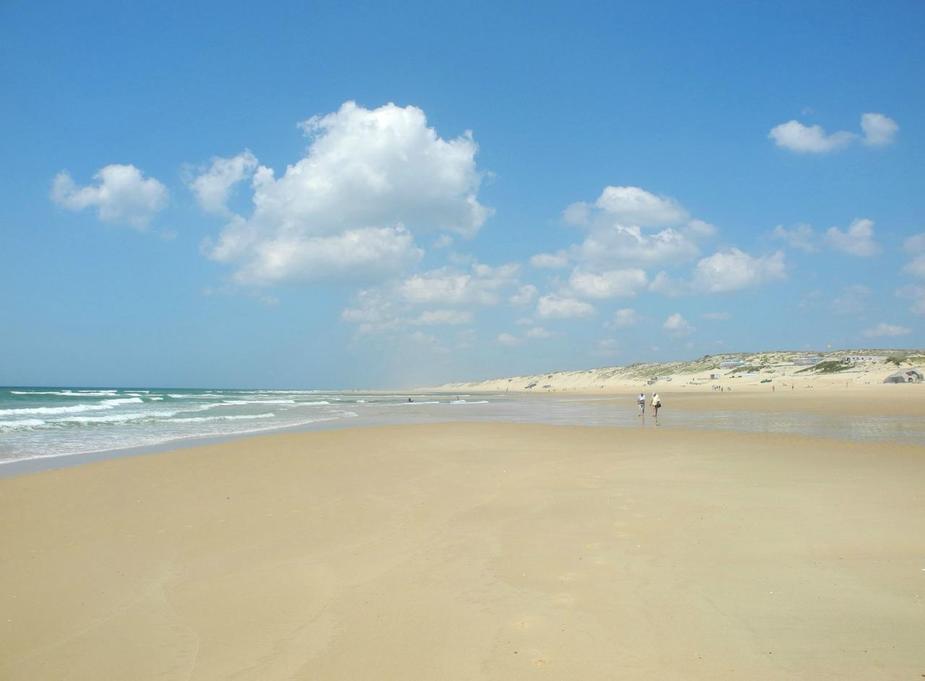
Time to plan the last stage of our trip. One item that had always remained on my bucket list for France was to visit the famous (white) wine regions (Sancerre, Pouilly-Fumé…) along the River Loire. For those who don’t know, this is bang in the centre of France, about 100 miles south of Paris.
Fortunately, there is a very convenient VFR airfield right in that area, Cosne-sur-Loire (LFGH).
Here’s our (IFR) flightplanned route:
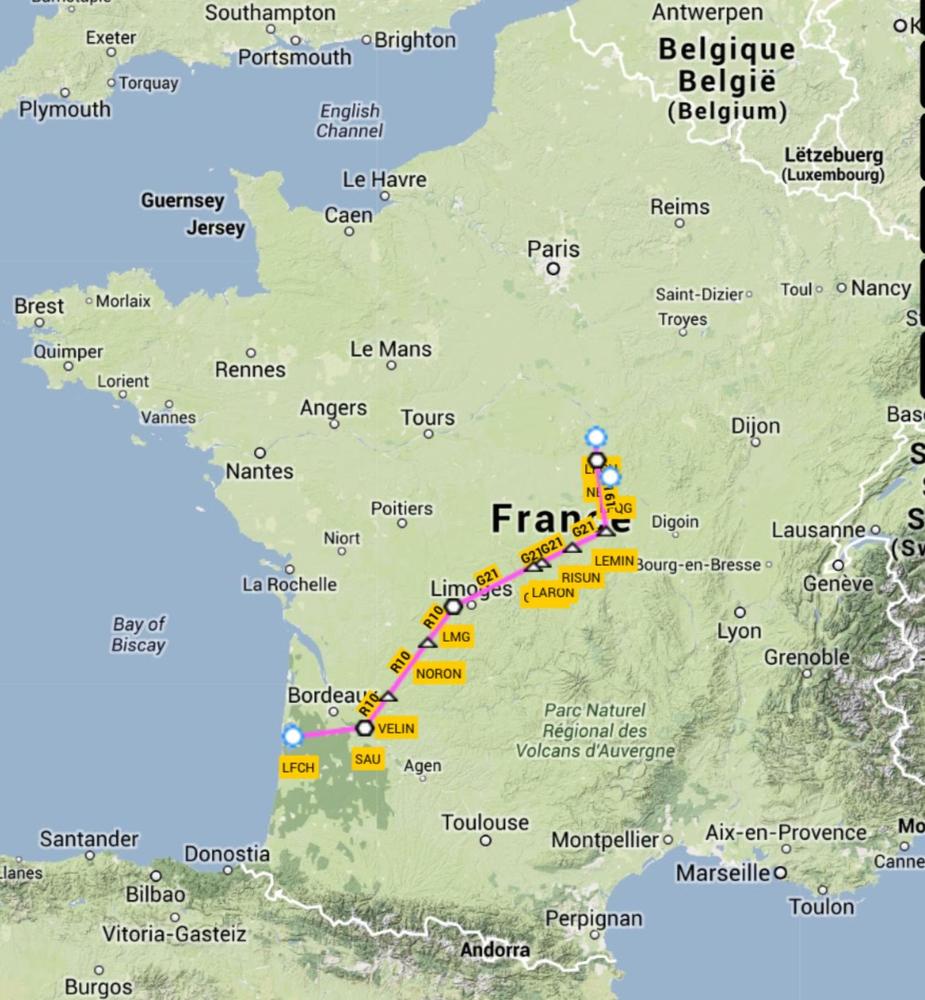
Here, by the way, you can see the situation that I described in another thread:
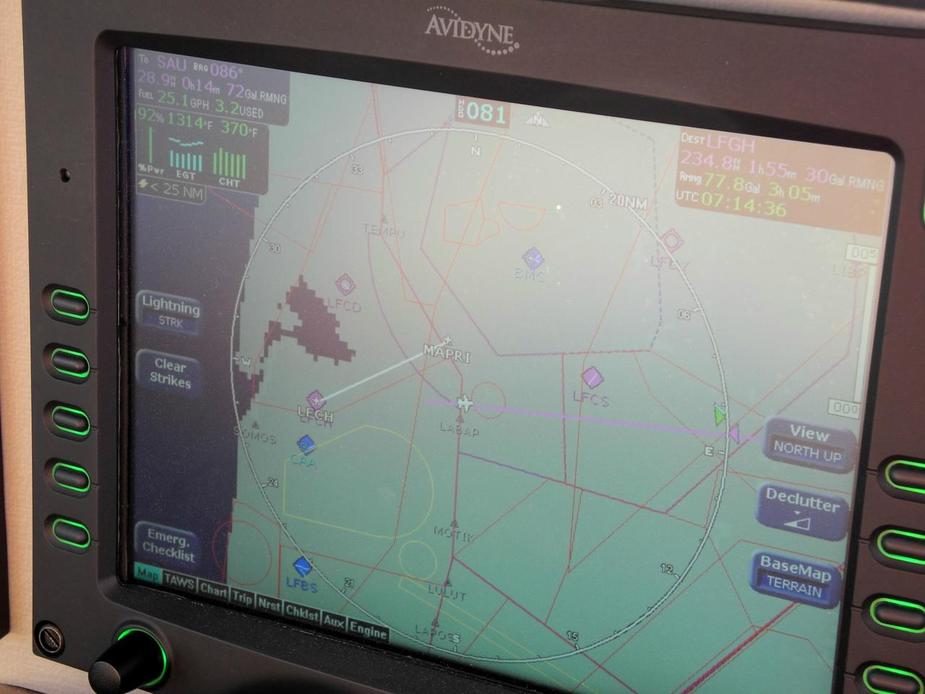
Shortly after departure from Arcachon, Aquitaine instructed me “direct Sauvterre (SAU)”, which took me right through an LF-ZIT. I was not 100% sure the controller knew what he was doing, so I made extra sure I would be able to outclimb it. (After the flight, I checked the AIP and found out that the restriction does not apply to IFR flights. But no way I could have checked that in flight, before reaching it).
Here’s Bordeaux Léognan-Saucats airfield (LFCS), which, unlike LFDY, is open to the public.
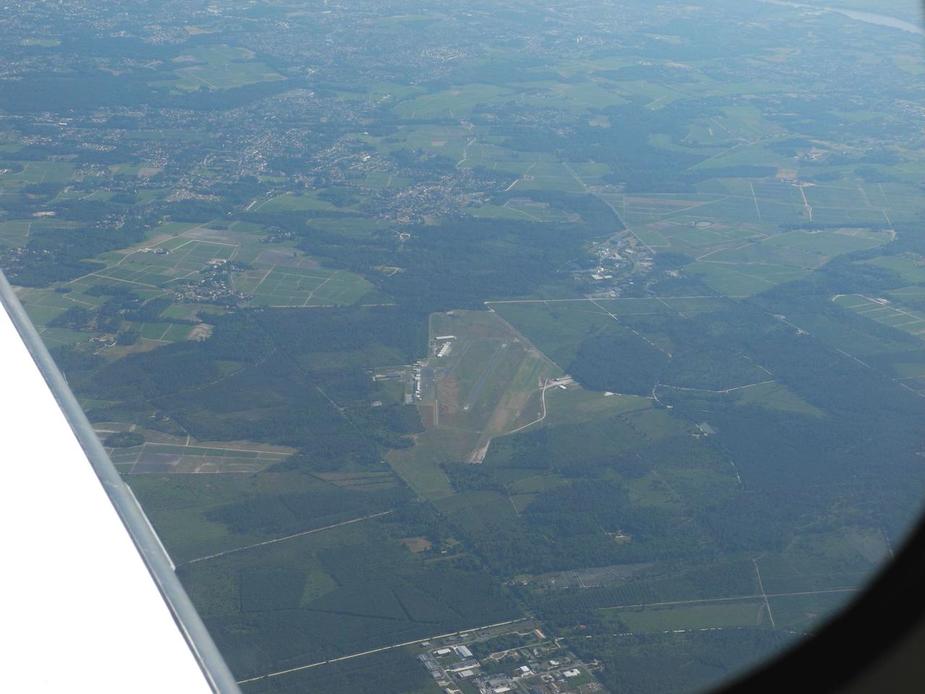
Bordeaux in the distance.
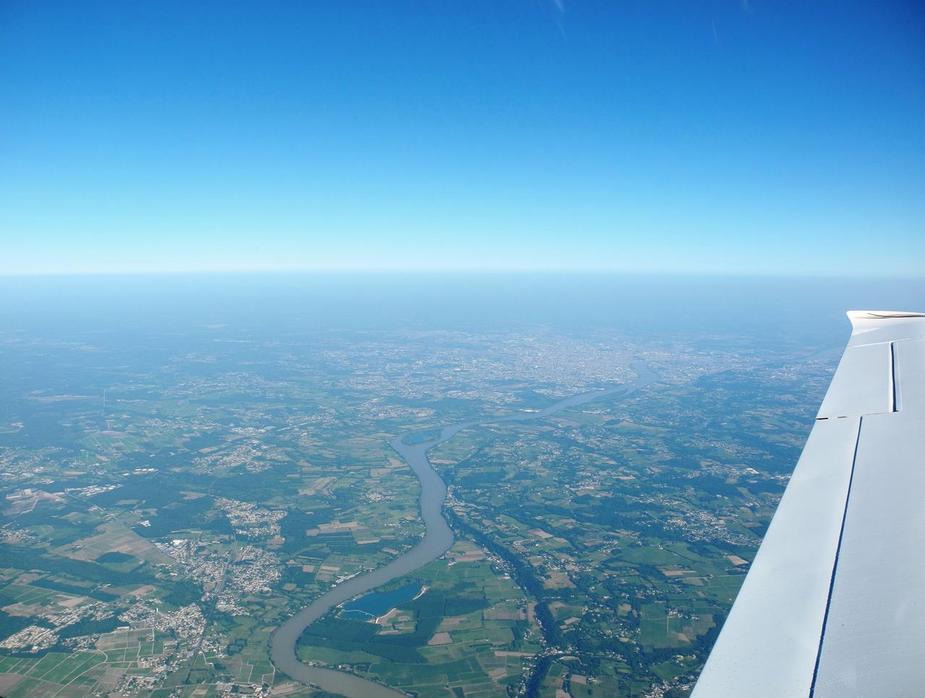
Later on in the flight, I negotiated hard to get a DCT to (or at least towards) our destination, but ATC was very clear and had me fly all the way to MOU VOR before turning me northbound. As nice as French ATC is, sometimes (especially on a weekday) they will just not accomodate requests of VFR traffic due to “military activity”.

Limoges. The airport is right next to the city.

Here we are in the descent into Cosne. Unfortunately, there was a lot of haze, so it was difficult to take good pictures. This is Pouilly-sur-Loire:
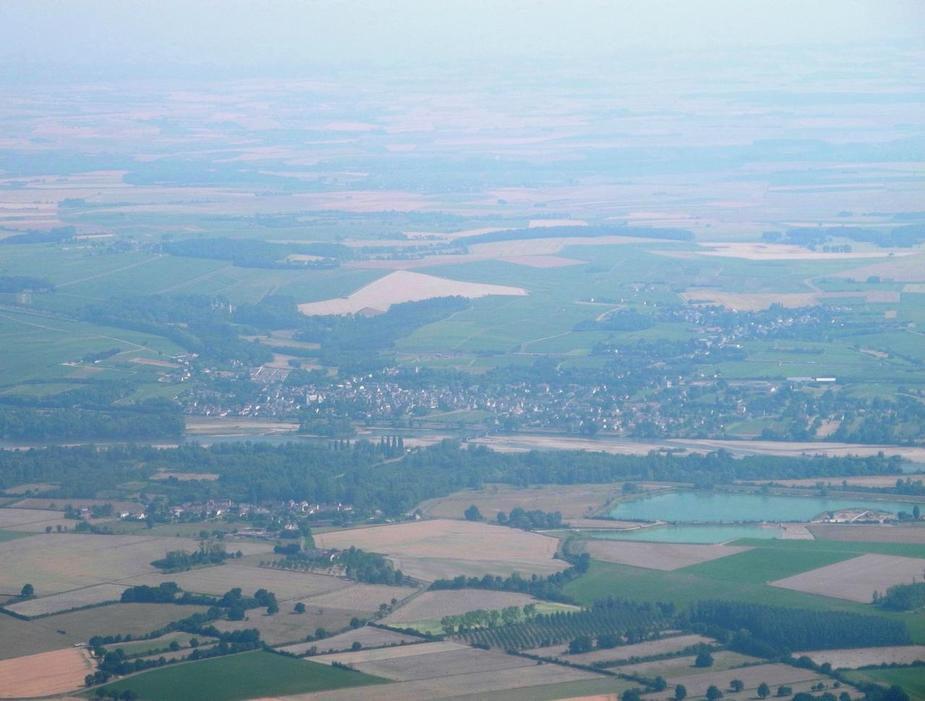
There’s Saint-Satur and Sancerre (to the left, on top of the hill).
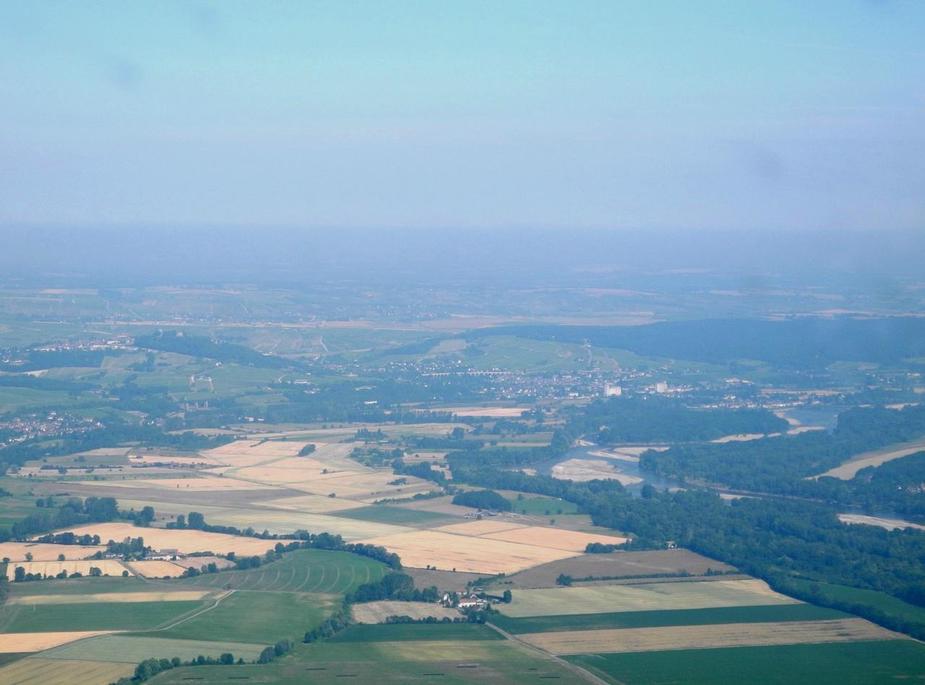
River Loire.
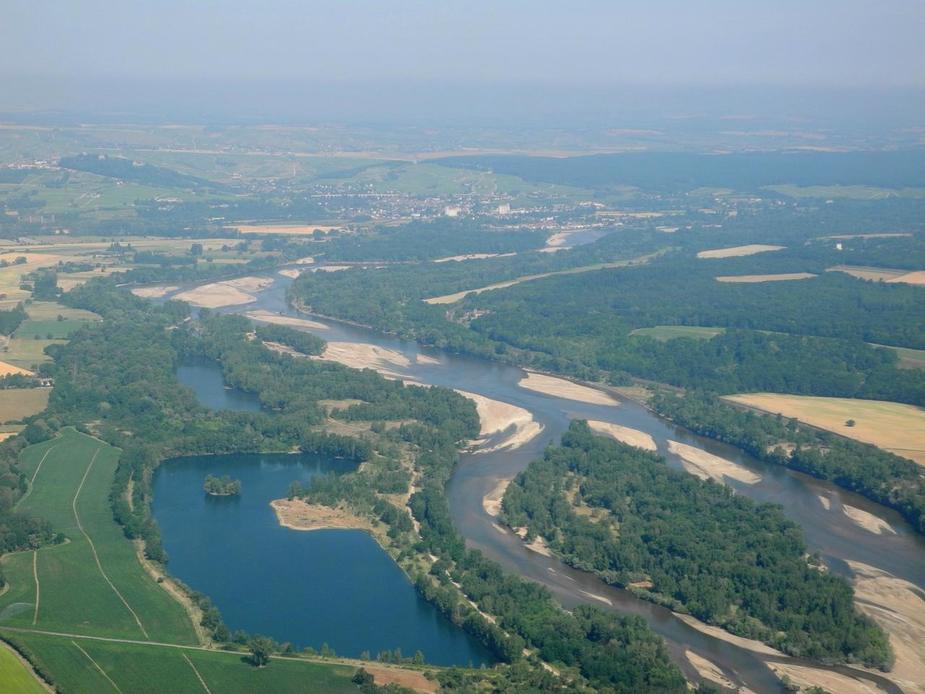
After our arrival at the airfield, we refuelled again (this time with the help of the local maintenance shop, since the BP pump did not have a card machine).
Also, we managed to rent a car from a Citroën dealership which is located just two miles north and agreed to bring the car to the airfield for us.
Visiting winemakers…
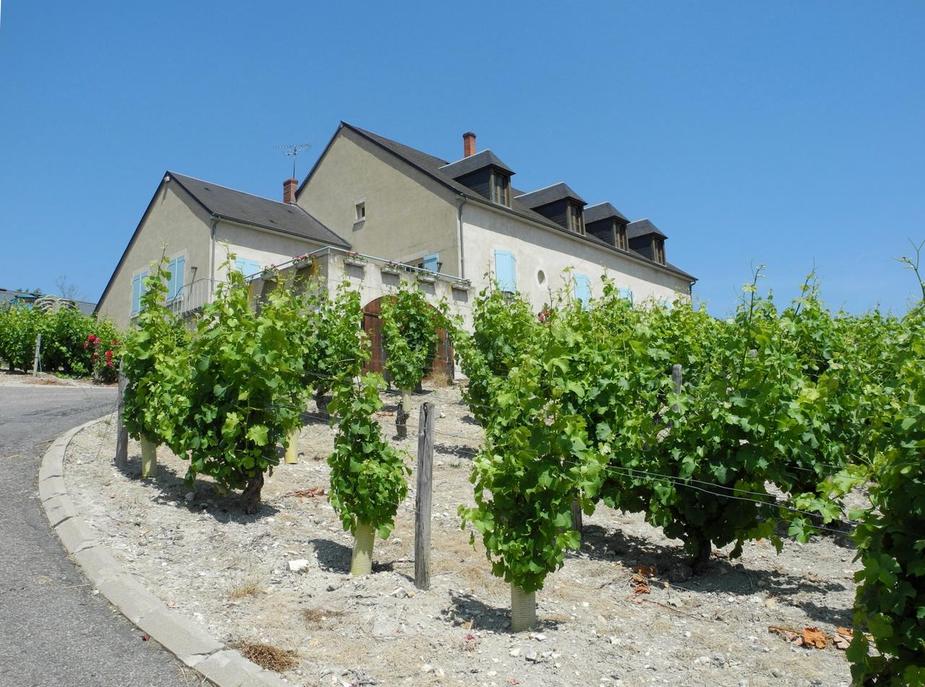
Lunch at a restaurant in Sancerre.
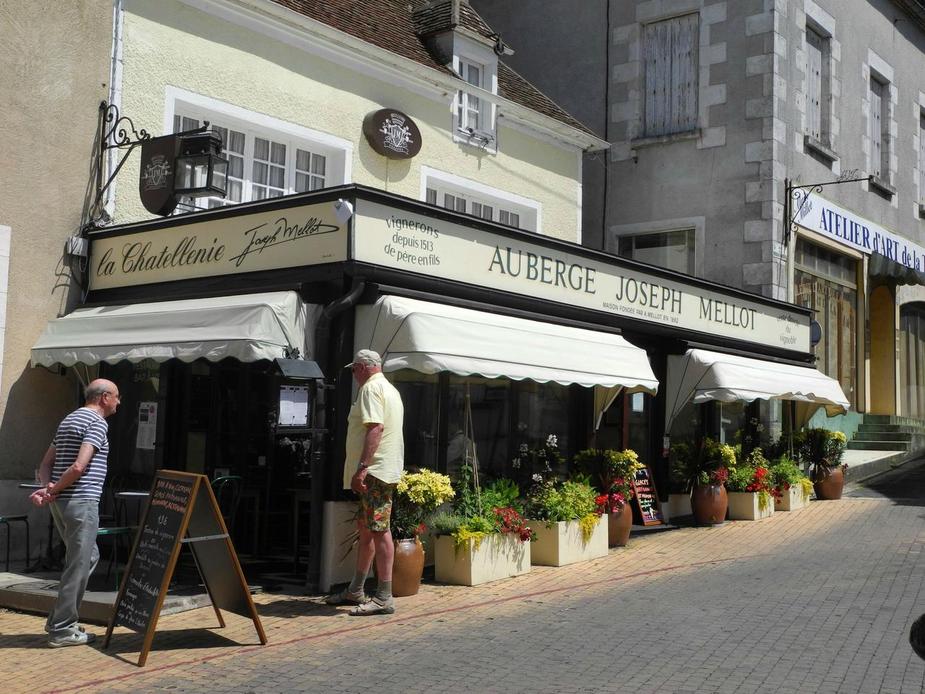
We really love Pouilly-Fumé…
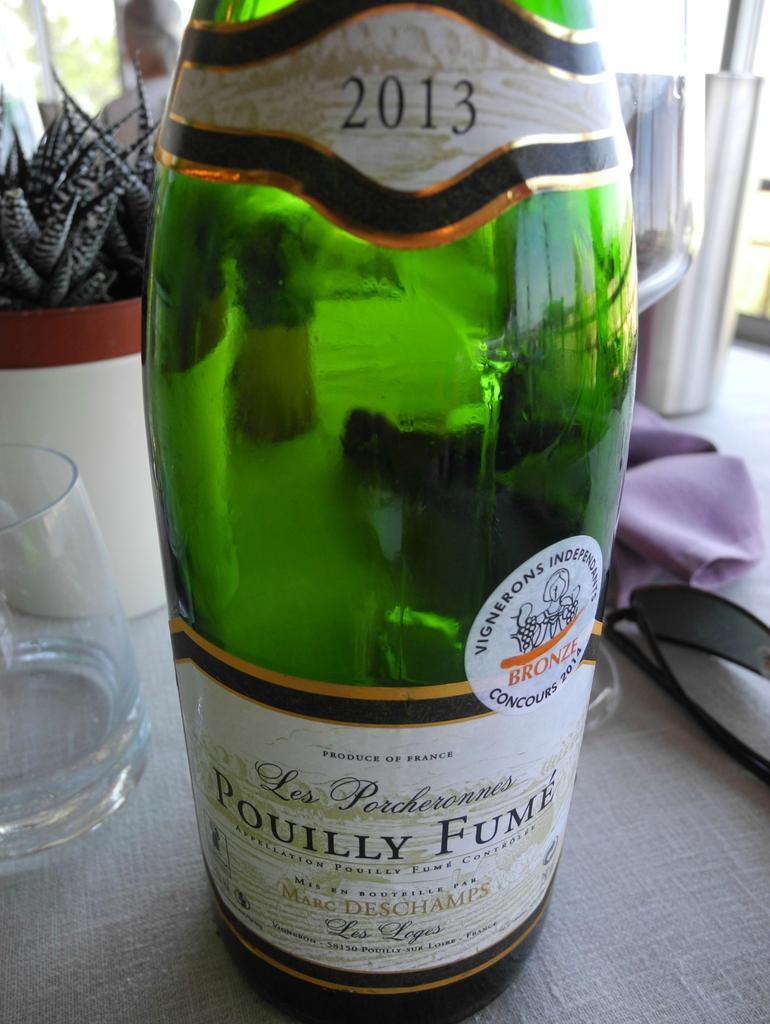
Some excellent local cheese.
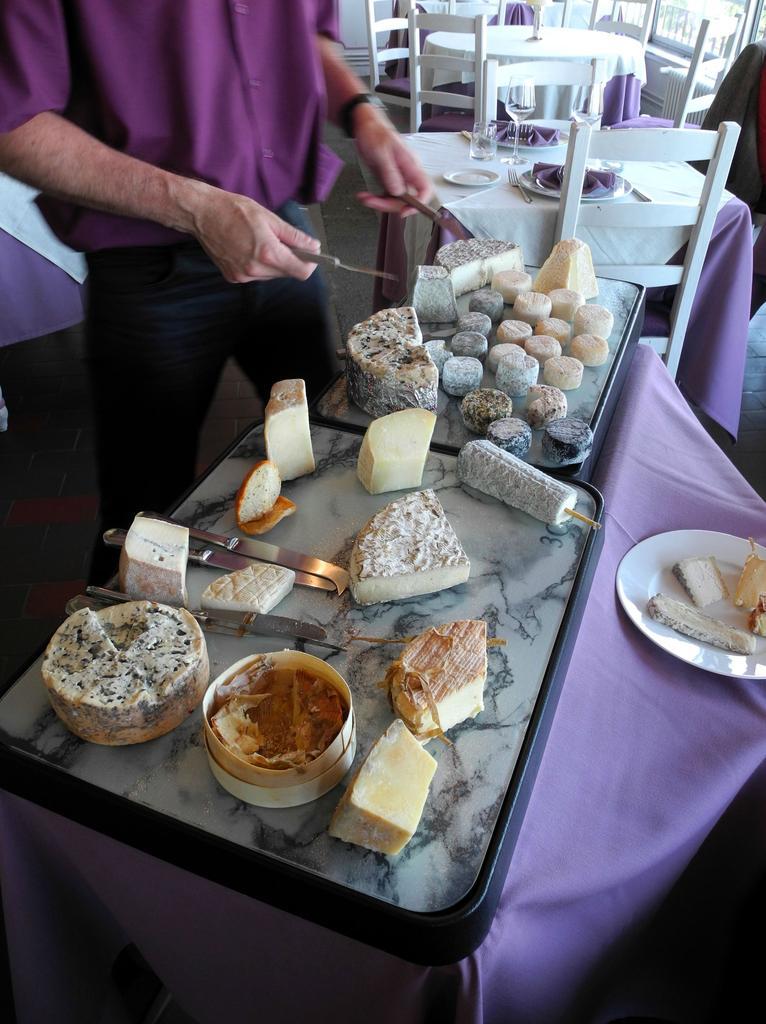
Views from Sancerre.
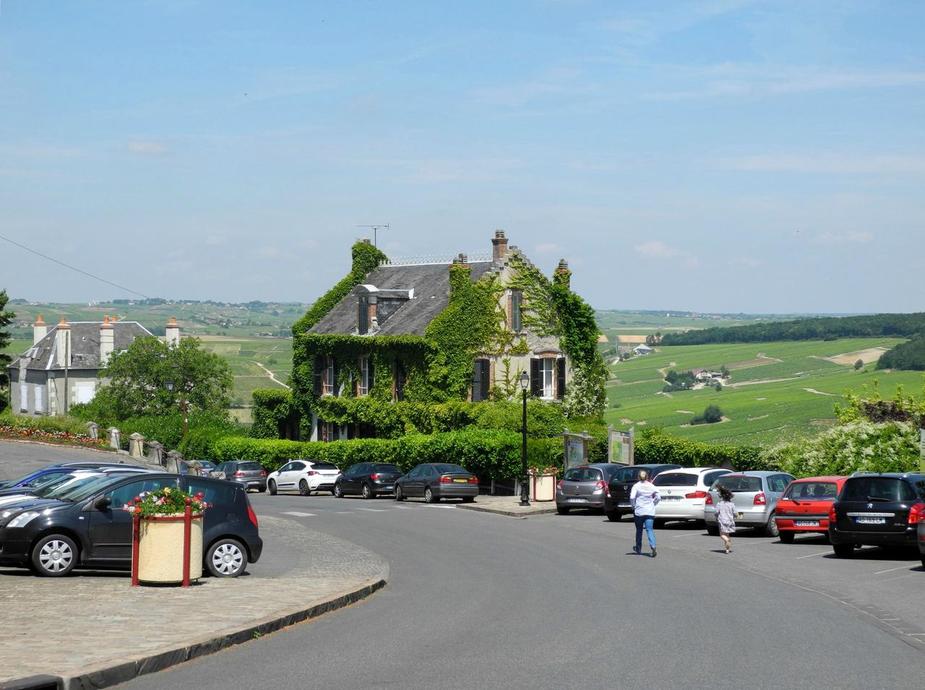
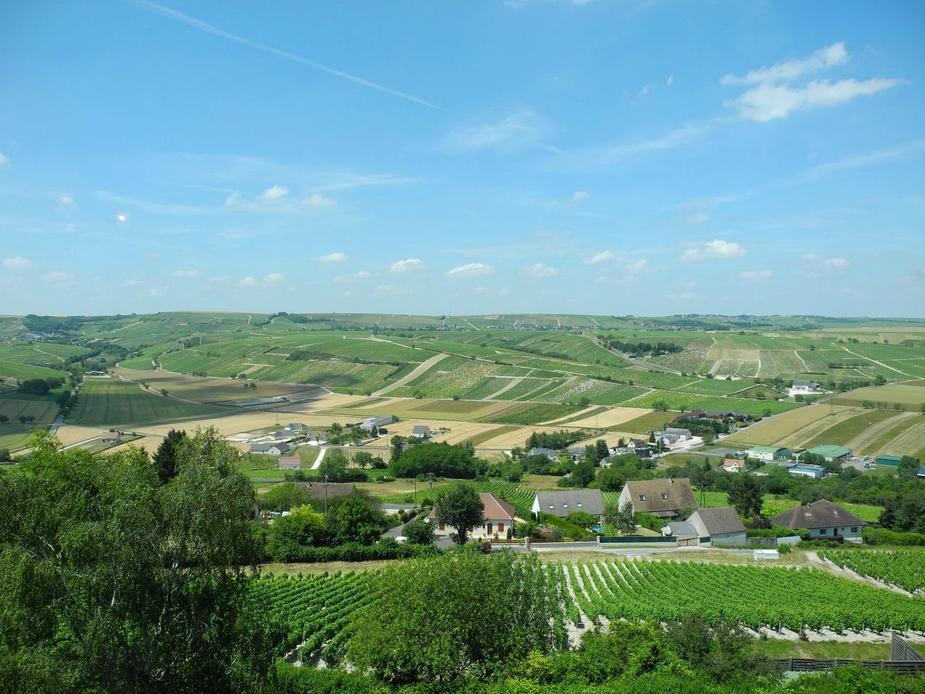
The area did indeed remind me quite much of the Piedmont wine regions of Italy.
One of the most famous brands of Pouilly-Fumé is “La Doucette”. They even have a chateau near Pouilly, so we paid a short visit.
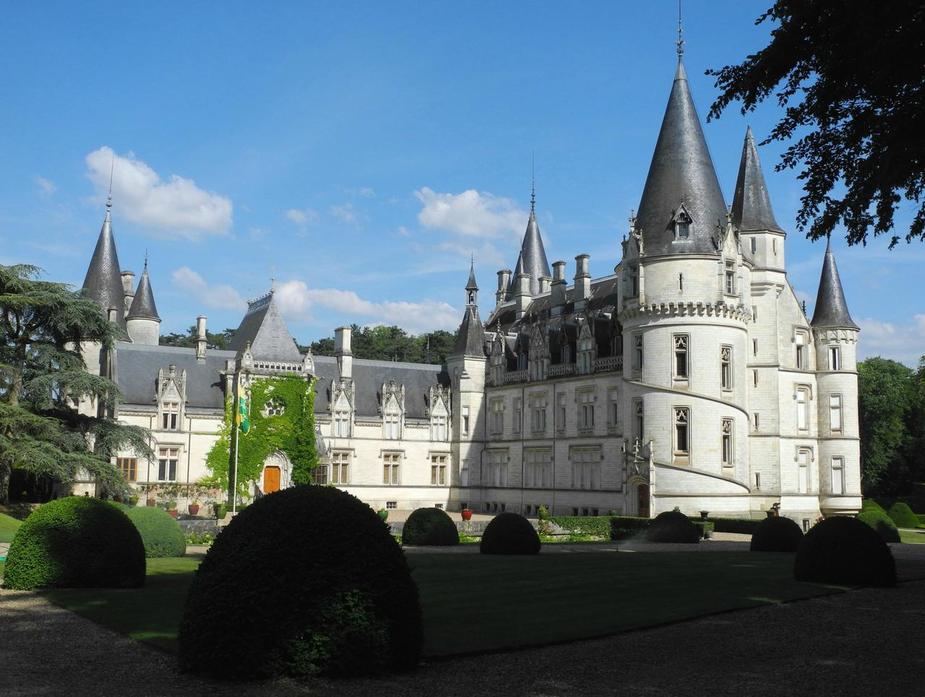
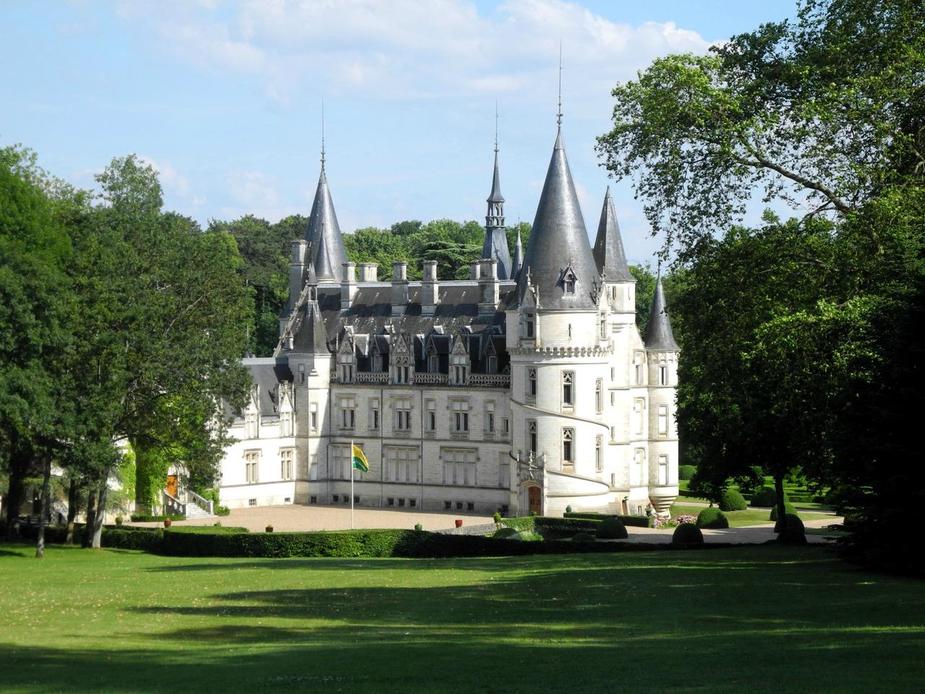
In the early evening, we even had a swim in the River Loire, whose water was pleasantly wasn’t cold at all.
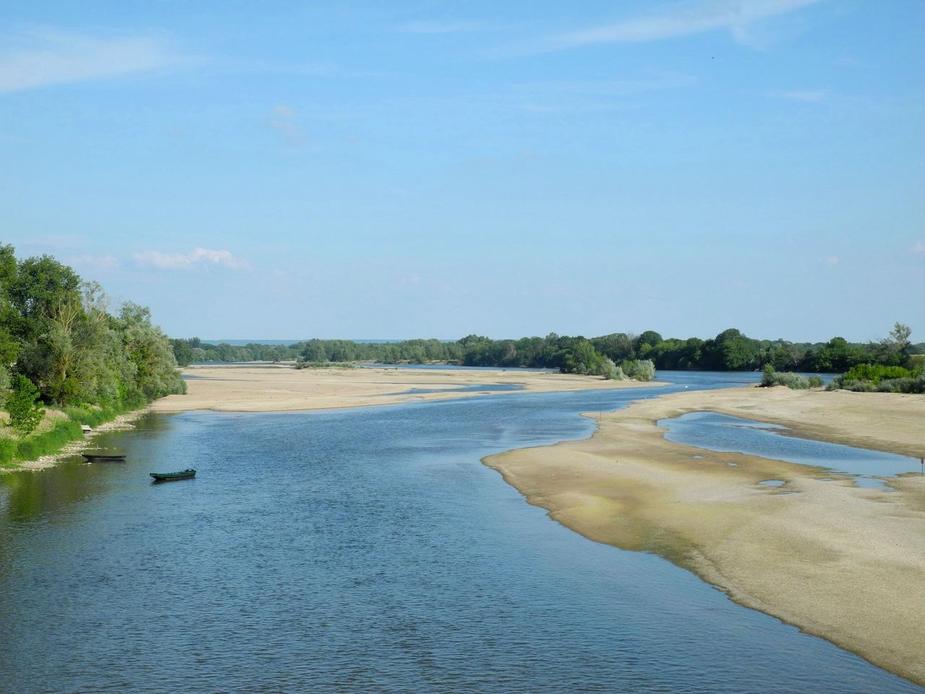
We slept at a gorgeous little chambre d’hôtes somewhere in the countryside. A view from the garden:
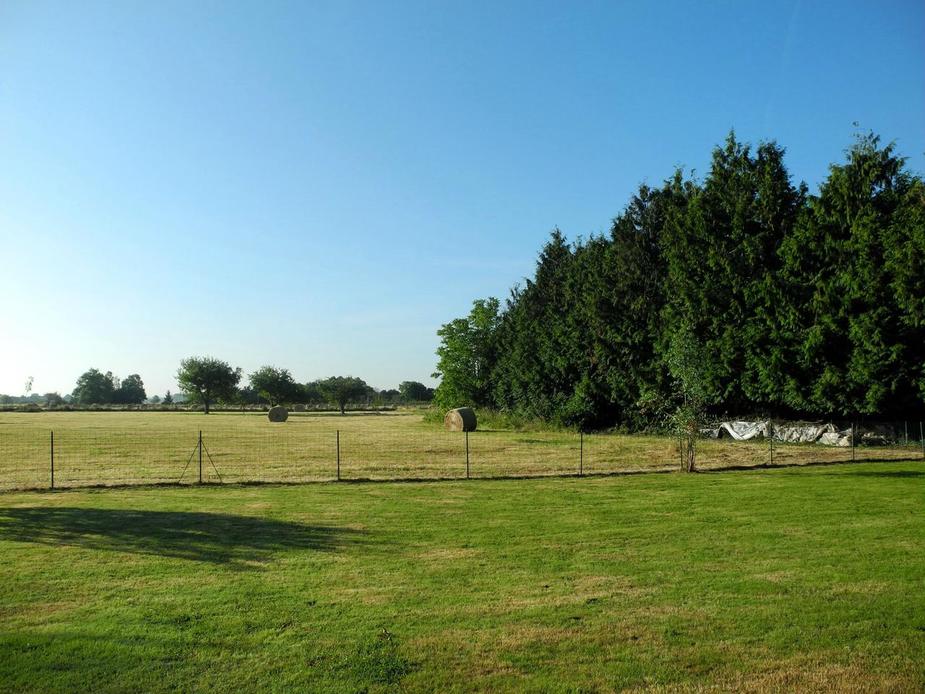
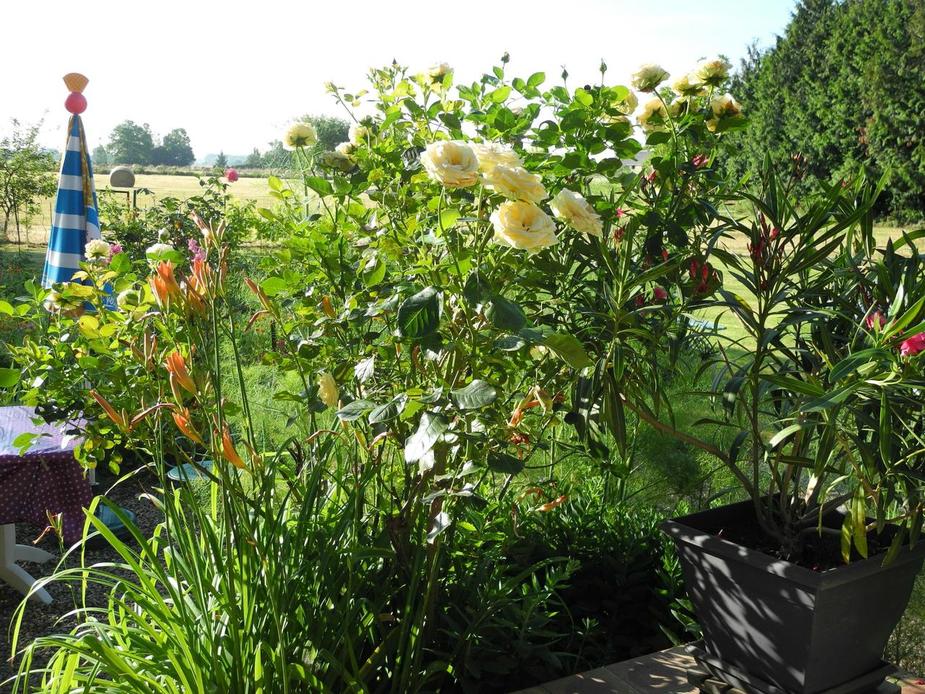
The next morning, it was time to return to Germany. The staff from the Citroën dealership even helped us loading some wine into our aircraft!
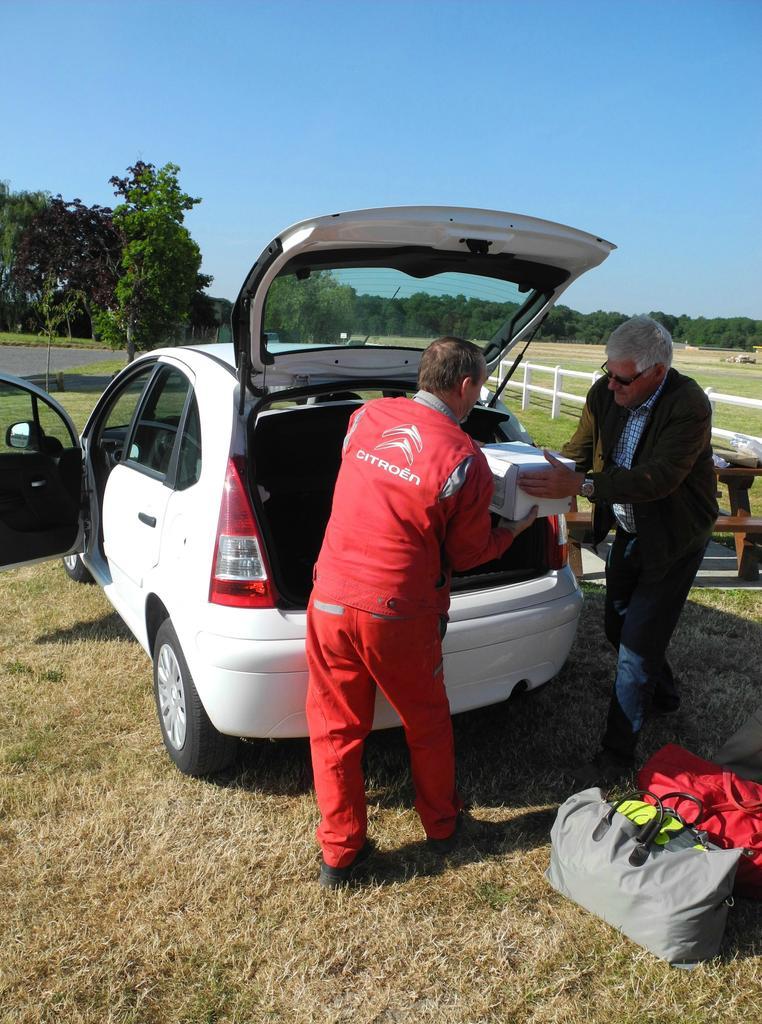
Ready to go home.
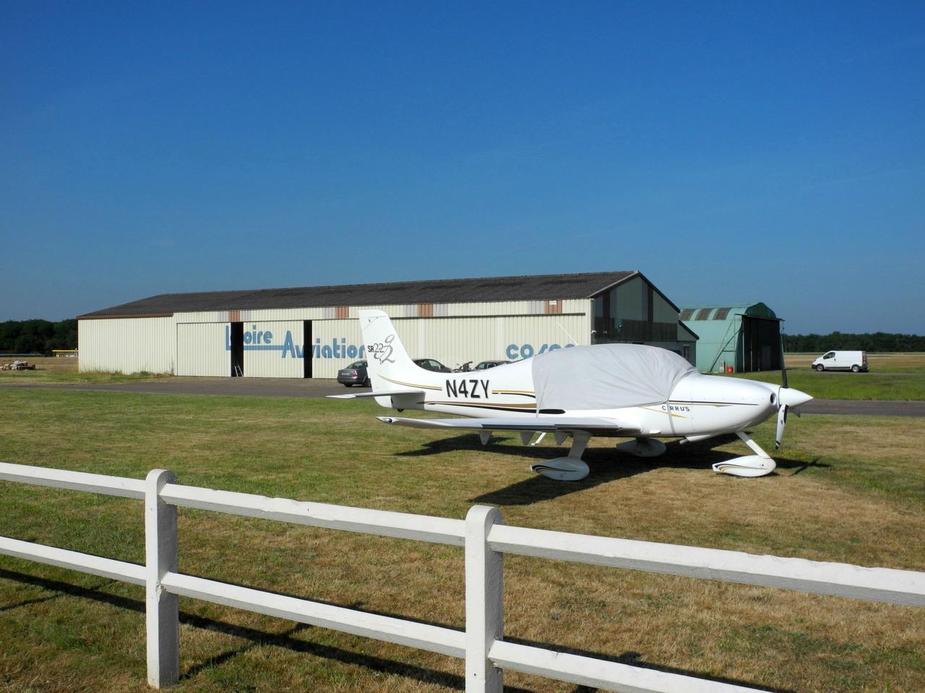
Here’s a view of the airfield at Cosne, just after departure.
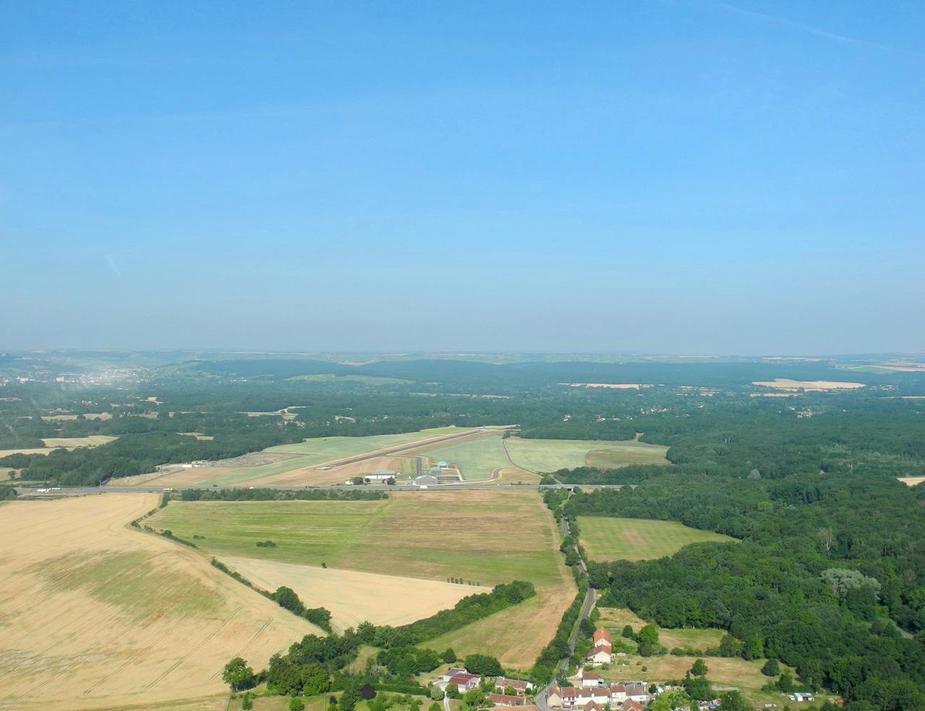
Again, the IFR pickup was quite smooth. We even got a fantastic “DCT ARCKY” (a DCT of more than 160 miles, all the way through many notorious restricted areas of the Champagne and Lorraine regions) which was hardly believeable.
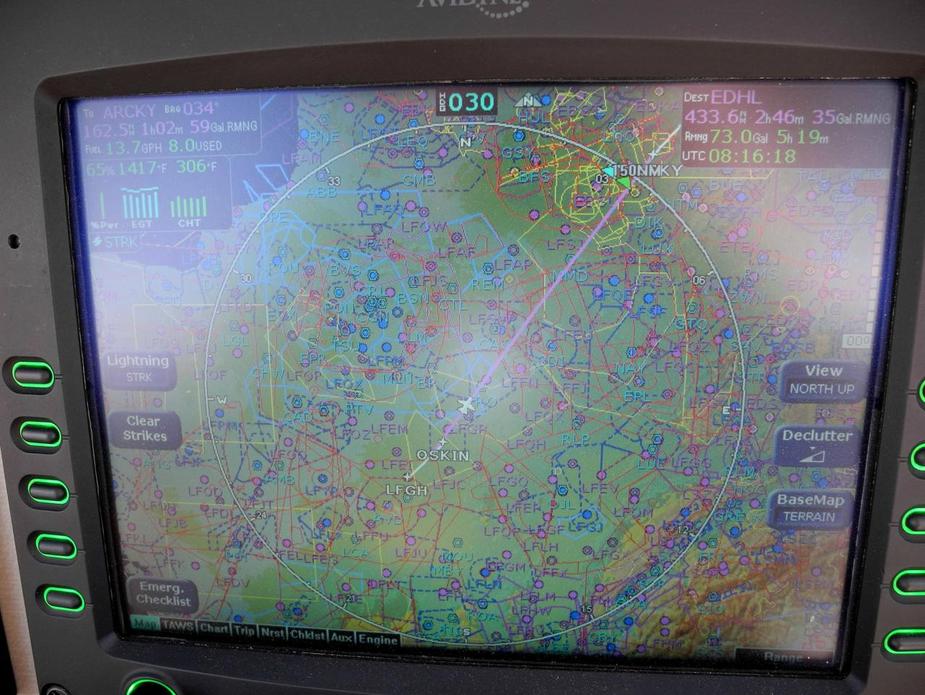
Anyway, what sounds too good to be true often indeed isn’t. Turned out that it was a “provisional” clearance and the next sector controller soon came up with the usual “proceed DIKOL, SUIPE, Montmedy” (these seem to be the favourite waypoints of the controllers in that area…), which was quite a detour. (Note: I guess I could just as well have had a temporary radio problem after I got that DCT to ARCKY… 
 )
)
Much of the flight was on top of scattered clouds at FL90, so not many more photos.

Since we hadn’t used our TKS on this trip (and hadn’t done so for several weeks before that), we decided to do the “30-day TKS test run” just before our top of the descent.
Here’s the right wing (the fluid is sometimes a little hard to see depending on the light conditons):
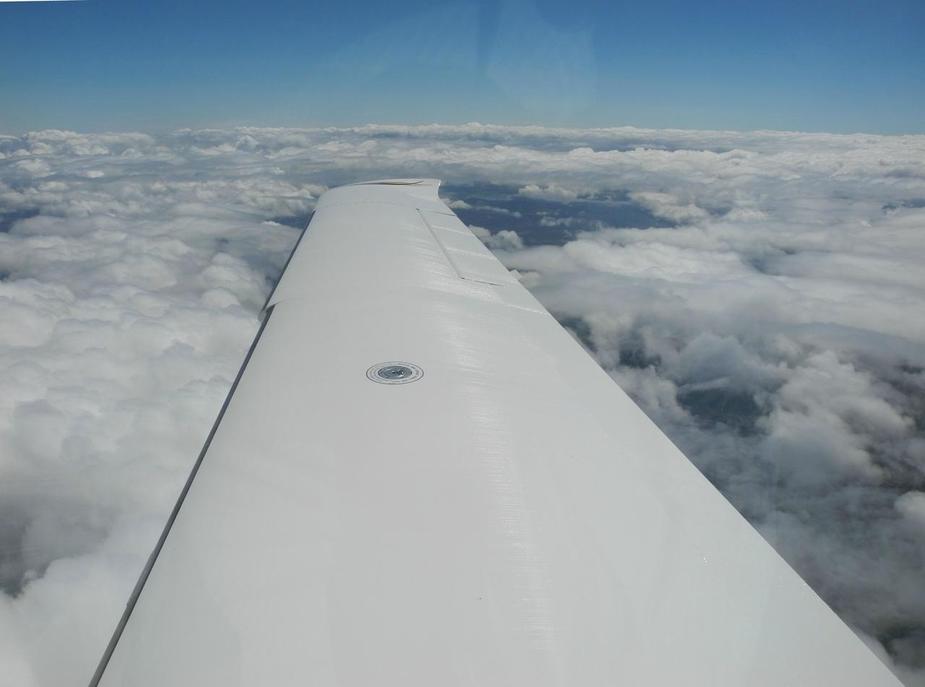
What one wants to make sure is that there is an even flow all over the wingspan within two minutes or so of switching the system on. The problem is usually with the very outer parts of the wing, which the fluid has a hard time reaching. It sometimes takes a couple more minutes to get all the way to the end.
Also, one checks for fluid to appear on the lefthand side of the windscreen. This also takes a couple of minutes.
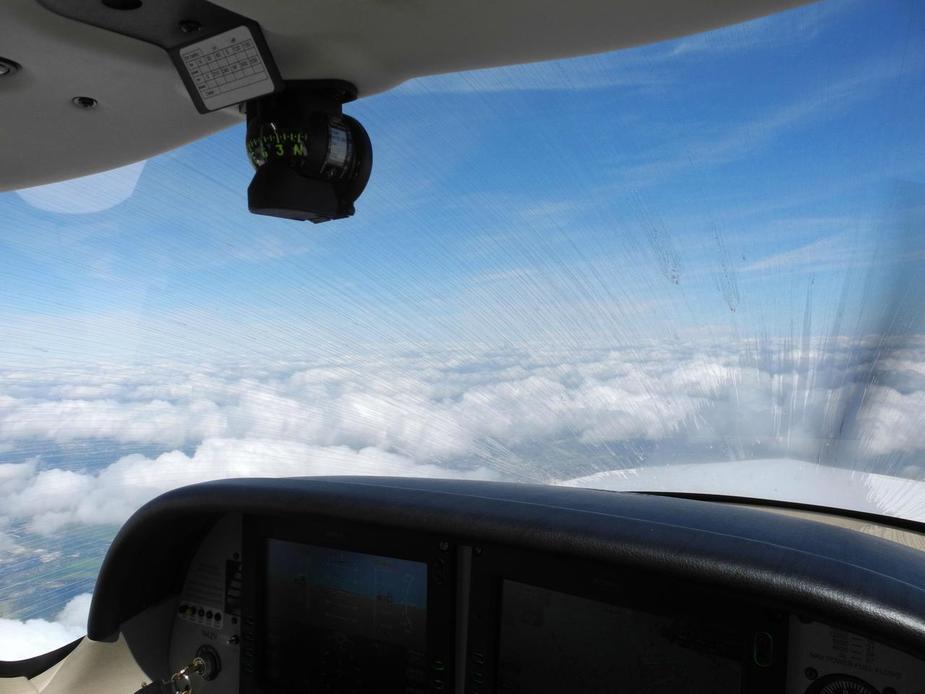
Now in the the descent over much more familiar terrain: River Elbe.
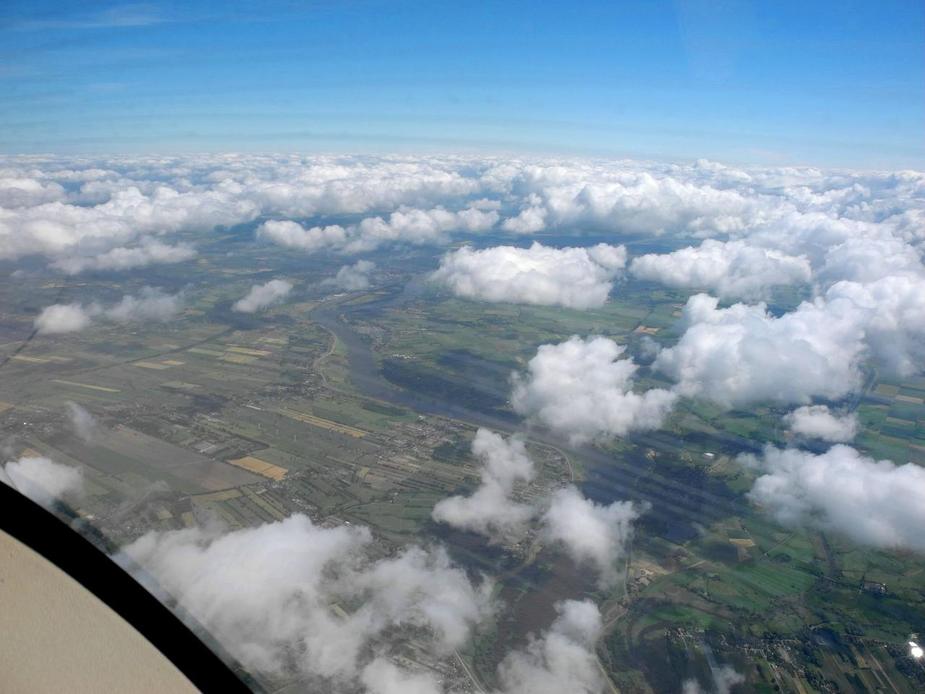
ILS25 at Lübeck.
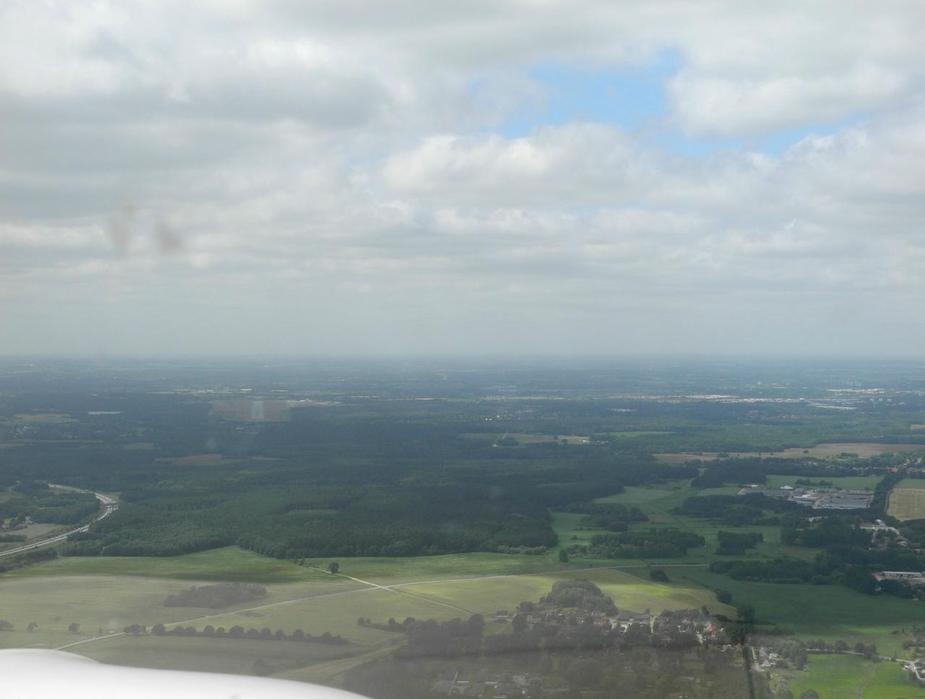
Short final. The airport is in big financial trouble. As of yesterday, it looks like a Chinese investor is going to take over…we’ll hope and see.
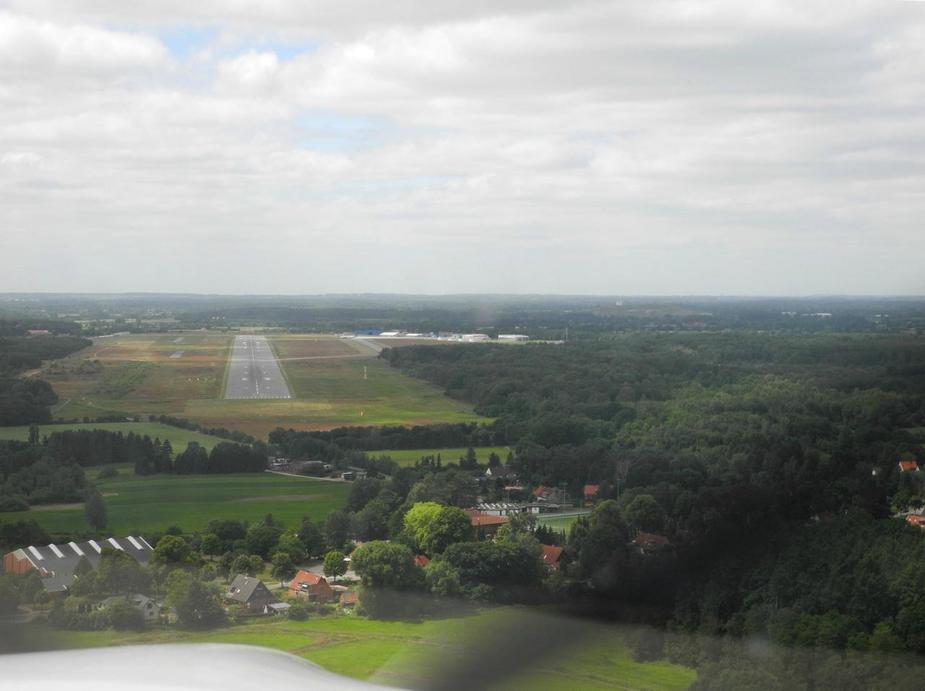
Just after we put the aircraft away in the hangar (after giving it a thorough wash), a group of French SEPs arrived, probably at the start of a trip towards Scandinavia.
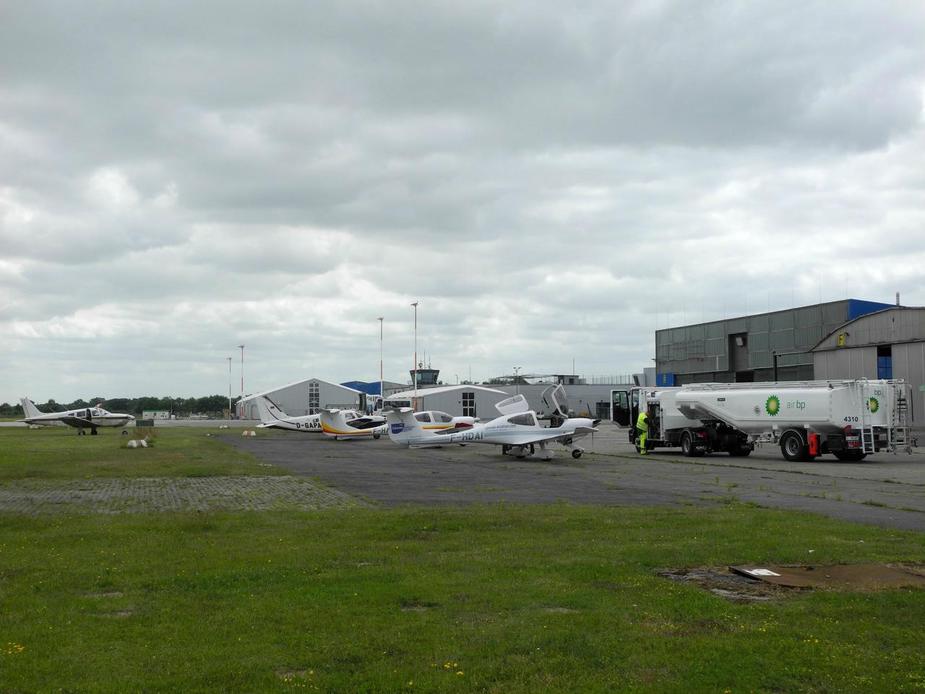
So…
Even though we didn’t make it to Sardinia, it was a great trip nevertheless. It really pays off to be a little flexible destination-wise.
Total flying hours were 12.5. Time spent in IMC: 2 minutes (one on departure at Menorca, one in the descent to Bagnères-de-Luchon).
Oh, and on the entire trip, we paid the huge total sum of 43 Euros for landing and parking fees (5 at Mende, 16 at Arcachon and 22 at home field – all the others were totally free).
Menorca was nice, but France was even better.
Great trip and writeup, Bosco! Just one small correction – the car in your pics is a Diane 6, not a 2CV! Take it from someone whose family owned both (plus a whole series of other Citroens) in the 60s and 70s….
Yes, you are right. I’m not a big conoisseur of cars. 
In any case, the car rental outfit at Arcachon has both.
I was going to say the same thing – but actually it is a Dyane, a Dyane Mehari to be exact… but that is but nitpicking.
Worse (to some) might be placing Barcelona in Spain – and that for the capital of the nation of Catalunya…
Worse (to some others) might be misspelling Biscarrosse, yes with a double R.
But of course I am writing all that because I am fondly jealous of this very nice trip and very well reported – thank you very much Boscomantico, well done!
If Biscarrosse has a tower, I believe the presence of an official or semi-official flying school may have to do with it. There is even a quite nice looking restaurant on the field, but they wouldn’t serve me – they only serve the school’s staff and pupils, and likely the tower staff too. Outsiders unwanted, though.
But above all, again it is illustrated that France is a private pilot’s paradise. The one art that has escaped me until now is how to know the good fields – with fuel available, payable with a common credit card, AND a decent restaurant – it must be said some French fields are nothing more than a bumpy runway out in the middle of nowhere with perhaps a ramshackle hangar in the bushes. I guess reading reports like this one is the answer – thank you indeed!
very nice write up!
We are departing next Saturday for our tour and the group hasn’t decided yet where to go after La Rochelle, perhaps we’ll stay in France 
Great write up. Thanks for sharing.
Is that aircraft yours? It looks fantastic.
Approaching the overhead (mandatory joining procedure for airfields without an active AFIS or Tower).
Where did you get this from? The first time I flew to France I tried very hard to find what their joining procedures were for uncontrolled airfields, and couldn’t find anything. The only thing I found was a reference to the different circuit positions in the AIP, which started on downwind. So I assumed that a downwind join was the norm.
Bosco, your trip writeups are some of the best I have read on the internet. Not just technical detail but really interesting to read. Well done again.
Is that aircraft yours?
Yes, sort of. It’s the “family plane”. My father owns it and we both share expenses. I am in charge of managing maintenance, insurance, trust, etc.
It looks fantastic.
Thanks, we keep it very tidy. Cirrus Europe certified it as “the best kept 2005 example in Europe”.
Re the joining of unmanned fields in France, it’s in ENR 1.4.1 c):
Other aerodromes
On aerodromes other than controlled or AFIS aerodromes the pilot in command shall himself assess the parameters:
- on departure: before leaving the apron
- on arrival before joining the aerodrome traffic by examining the aerodrome; such examination shall when possible be made from an altitude greater than the highest aerodrome traffic circuit and in particular cover the signal area the wind cone and the surface condition of the manoeuvering area in order to determine the landing area or runway to be used and ensure that the use of the aerodrome does not imply any hazards.
It does make sense. If you don’t join via the overhead, how do you know exactly where the wind is coming from, at the runway threshold? How do you know the runway isn’t blocked by something?
And of course in the absence of ATC/AFIS you must use French only to self-announce….even if they are just off on their lunch break….
And of course in the absence of ATC/AFIS you must use French only to self-announce….even if they are just off on their lunch break….
Yes – local language competence is a requirement at all “non international” airports i.e. airports not showing as “Customs” in the airport databases. Come to think of this… I wonder whether this is true for Germany. I am going to start a new thread on that.